It was 2012 when this whole birding thing began for Evan and me. By year’s end, we didn’t even have 100 species to our name. Sometime in January of 2013, I discovered Minnesota’s listserv, MOU-net. My eyes were opened to the world of rare birds. At that point in time, rare birds and common birds were all still new to us, so many of the reports were not of great significance to us. While I wasn’t into chasing rare birds at that time, a bombardment of emails regarding one bird was causing me to think I should take some kind of action. The Boreal Owl was irrupting in record numbers that January and February, coming down from Canada. I had only seen a Great Horned Owl by this time, so it was just one of 18 Owl species I had yet to see. But people were describing how this species only irrupts like this every four to five years, and birders were flying in from all over the country to see this Owl. It was a rare event to say the least; I knew I had to try. Melissa was involved in directing a school musical during that same time and couldn’t break away for a weekend getaway until early March which I later found out was a little on the late side for Boreals. Some readers may recall that it was then that we made our first ever birding trip to the Sax-Zim Bog and the North Shore, hoping to see the Boreal Owl as well as the other great northern Owls. Not only did we not see a Boreal, but we saw no Owls at all.
That winter passed giving way to new seasons and new birds. Over the years our life list would quadruple, and it would include numerous Owl sightings from 17 different species. Each winter I’d hold out some hope that there would be a report of a Boreal Owl somewhere along the North Shore of Lake Superior, but there would be none. Eventually it became a mythical bird for me. I kicked myself for not getting my butt up to Duluth in February of 2013. In the years since then, I had amassed a formidable collection of rare bird sightings in Minnesota and across the country, yet I was not a member of the Boreal Owl club. I had Owled literally from the Canadian border down to the Mexican border seeing really cool Owls. But the Boreal was not one of them. In fact, I was down to two unseen Owl species of the 19 that are possible: the Ferruginous Pygmy-Owl and the Boreal Owl. Watching my good buddy Tommy DeBardeleben accomplish his goal of seeing all 19 Owl species in 2016 only heightened my desire to get the Boreal. I felt as if Minnesota was a lost cause. I began to daydream of trips to Washington state, Colorado, or Ontario to look for this Owl. The winter of 2016-2017 was supposed to be the next Boreal Owl irruption if it truly did irrupt every four years. I eagerly awaited news last year. There were a handful of scattered reports, but nothing of a large scale irruption materialized. Would I have to wait another four years? Would I have to travel far away and spend all kinds of money to finally see this Owl?
It turns out I was not alone in my longing for a Boreal. Buddy Jeff Grotte who started the popular Facebook group, Owl About Minnesota, has seen over 1,000 Owls in the last five years. He even tried for Boreal a few times back in 12-13, but he was still Boreal-less too. Jeff and I talked often of hoping to see this bird. Then in December, a friend of Jeff’s from Indiana had a brief sighting of one in the Sax-Zim Bog. It was a fluke sighting, or so I told myself. This wasn’t the irruption year–that was supposed to be last year. Jeff and I decided to try for this Owl the very next morning. It literally was our first opportunity in five years of waiting. We had to try. Rising early, we got up to the Bog just after dawn. Great Grays, Hawk Owls, and Snowies were all off to a banner start up there, but Jeff and I have both seen plenty of each. We wanted the prize bird more than anything else. By noon we were still without a Boreal sighting and decided to call it quits. The three Owls we did see were of little consolation.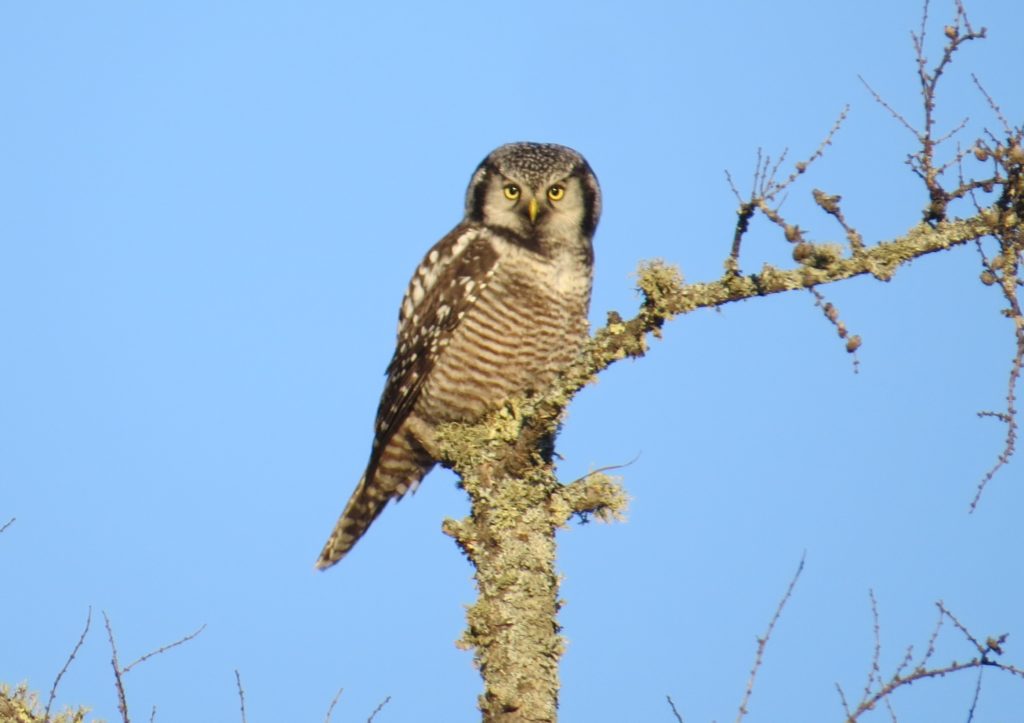
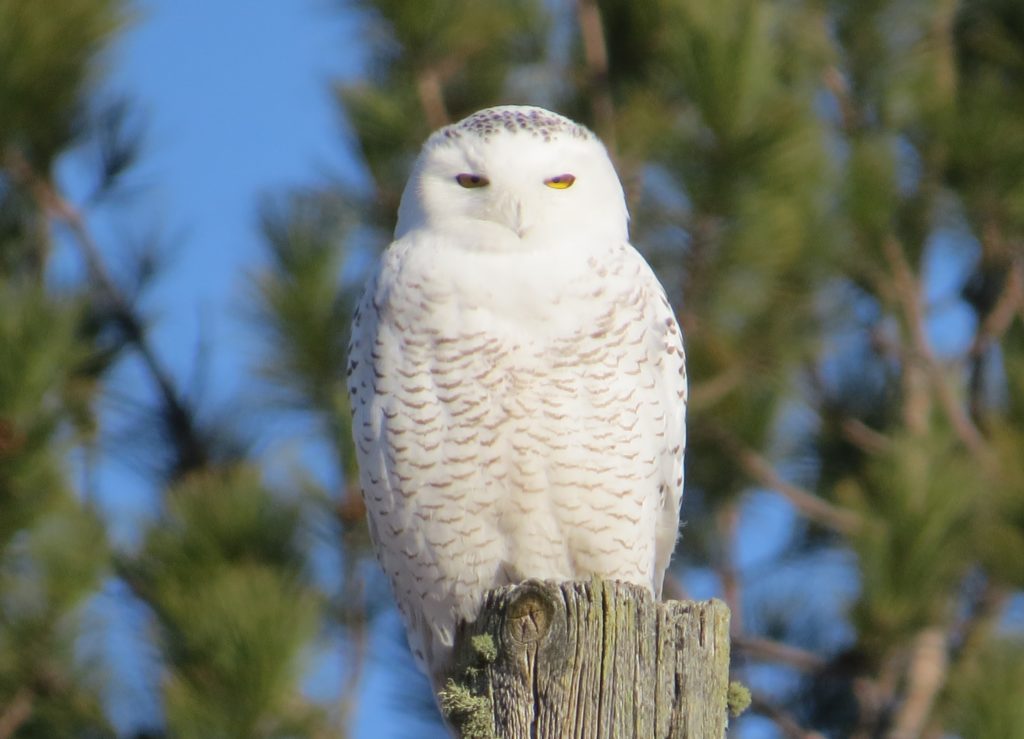
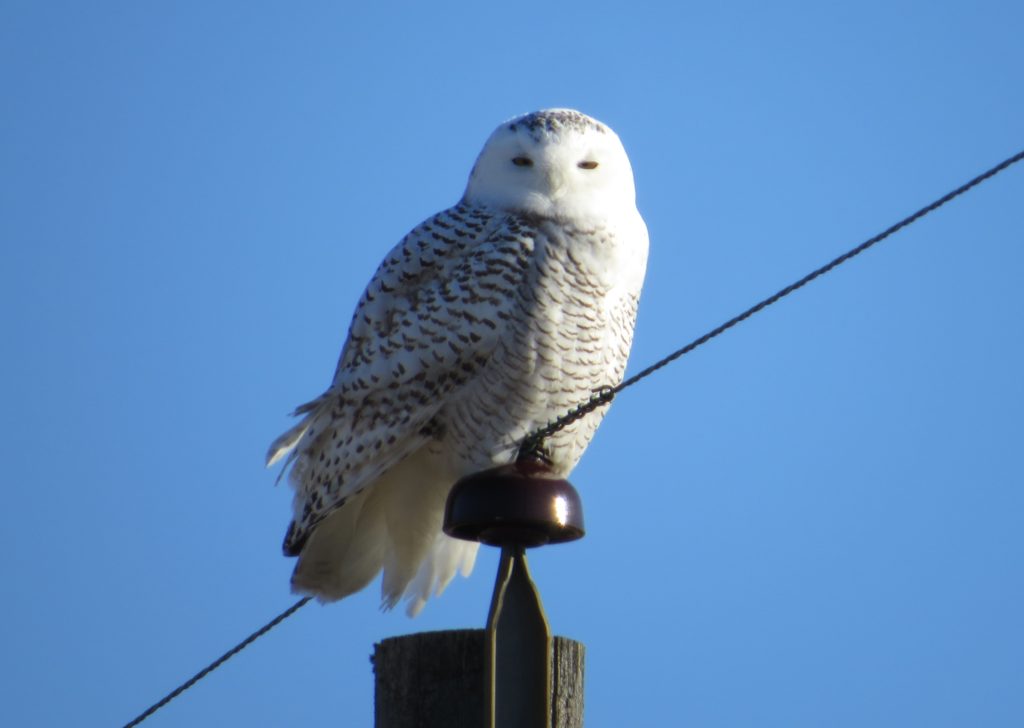 Heartbroken at the time, little did we realize that the Boreal we chased was just the tip of the spear. More sightings kept popping up during December of both live and dead Boreal Owls. By the time news of one would come out, though, it would either be during the work week or late in the day making a chase impossible. Jeff and I were hopeful that our day would finally happen, but we were very antsy about it. I had an upcoming trip to Arizona that I was now dreading. I did not want to miss my chance.
Heartbroken at the time, little did we realize that the Boreal we chased was just the tip of the spear. More sightings kept popping up during December of both live and dead Boreal Owls. By the time news of one would come out, though, it would either be during the work week or late in the day making a chase impossible. Jeff and I were hopeful that our day would finally happen, but we were very antsy about it. I had an upcoming trip to Arizona that I was now dreading. I did not want to miss my chance.
Jeff, myself, and several others decided we should just head up to Duluth and the North Shore the weekend of January 6th-7th whether we had sightings to go off of or not. Clearly the Boreals were irrupting, so the plan was to either look for one on our own or geographically put ourselves in position to quickly get on a bird if there was one. I decided to drag Evan along on this trip; even if he didn’t care about Boreal Owls so much, I knew it would be a fun father-son adventure. We would travel all the way to Grand Marais to stay in my brother’s vacation home, looking for Boreals along the way.
Late in the day on January 5th, one of our group had accomplished the unthinkable: while looking for Saw-whet Owls, teenage birding brothers Ezra, Isaac, and Caleb Hosch had discovered their lifer Boreal Owl near the Twin Cities! Four days prior to that, these brothers had come out to Kandiyohi County to try to help me find a Saw-whet out here. Jeff opted to look for the Boreal these guys found that next morning. I decided to continue with my plan of heading to the North Shore. After all, Scenic 61 between Duluth and Two Harbors is where the Boreals usually pop up. Furthermore, a fellow living outside Grand Marais had one coming to his yard for a few days in a row. This Twin Cities Boreal could easily be gone the next day, and chasing it could cause me to lose valuable search time along the North Shore. Jeff planned to call me that morning if it was relocated. Sure enough, two hours into my journey north I got the call from Jeff. I was just north of Hinckley at the time, heading north on I-35. I continued to the next exit where I could get turned around to head south. It would take an hour to get there. It was a strange detour, but you know, a bird in the hand and all that…
Evan and I got to the site. Jeff was waiting for us in his car trying to get warm. Little did we know that it was nearly a mile hike in the single-digit temps out to this Owl. Jeff did warn us that the Owl was extremely high in a pine tree, like 60 feet high, and the views were terrible. The Hosch family was also there to guide us out to where the Owl was. Visiting with the Hoschs, I learned that Jeff had called me to get me turned around on the highway before he even laid eyes on the bird himself. Nice guy. When we got out to The Tree, Isaac and Ezra were helping people get on their amazing find. I could not see the darn thing despite patient birders trying to describe where it was. Just as I was about to zero in on it, it flew! So, technically I had a Boreal Owl, but it didn’t feel like it. Evan never took his eyes off it and saw it land in another pine just as high off the ground as the first. Evan was able to see it with no optics, but again, I could not pick it out. And then it flew again. Argh! The bird had been notched, but there were no solid looks or photos. This was not just some western Empid that you could be satisfied with a brief, distant look–this was the freaking Boreal Owl! Two hours had now passed since I got that phone call from Jeff. Evan and I could still make it Grand Marais before dark and get at least some searching in along the way if we hurried. I was hoping we could get onto a more cooperative Owl. So with temps hovering around zero, Evan and I jogged most of the mile back to the car and quickly got on the road to go back north. There were more Boreals to be found, and we wanted a better look.
We got to Duluth around 1:00. I wanted to be in Grand Marais by 4:00 in case that gentleman with the yard Boreal called me. He had said he would make sure to tell me if it made its usual appearance at dusk. Once in Duluth, Evan and I hopped on Scenic 61, a highway that hugs the shoreline of Lake Superior. Boreal Owls are often found here during irruption years because when they come south they hit the lakefront and keep moving southwest along the shore. The stretch between Duluth and Two Harbors is often the best section for them. We, though, didn’t find any by the time we hit Two Harbors. We stopped at a city park where a Boreal had been seen a few days earlier. We planned to leave by 2:30 to get to Grand Marais in time. The park yielded nothing. Evan and I were walking back to the car to continue northeast to GM when my phone rang. It was Jeff: “Hey, where are you at?!”
“I’m in Two Harbors.”
“Turn around right now! There’s one in Duluth!”
I was literally running while getting the location from Jeff and hollering to Evan (who had fallen a hundred yards behind) to start running back to the car. Huffing and puffing, we hopped in the car and quickly got on the expressway back to Duluth. Another jaunt south on this north-south zig-zag adventure. No Scenic 61 this time. In about 25 minutes we made it to the Hartley Nature Center where Erik Berg and Kelly Raymond had seen this Owl and notified Jeff. It took a little bit of time to figure out where Erik and Kelly were, but eventually we found them quietly looking at this!
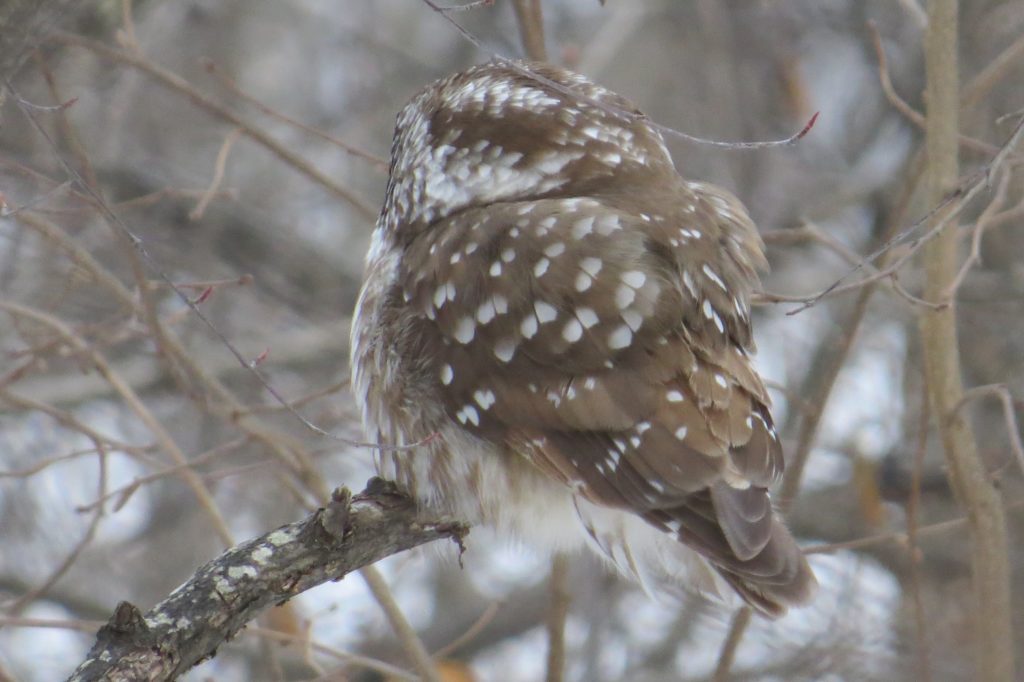 Erik and Kelly made some room for us to see this brush-loving bird through a small window in the branches. It felt good. We had made it. We were looking at a real-live Boreal Owl! Now, we were just waiting to see that face. This was our first glimpse.
Erik and Kelly made some room for us to see this brush-loving bird through a small window in the branches. It felt good. We had made it. We were looking at a real-live Boreal Owl! Now, we were just waiting to see that face. This was our first glimpse.
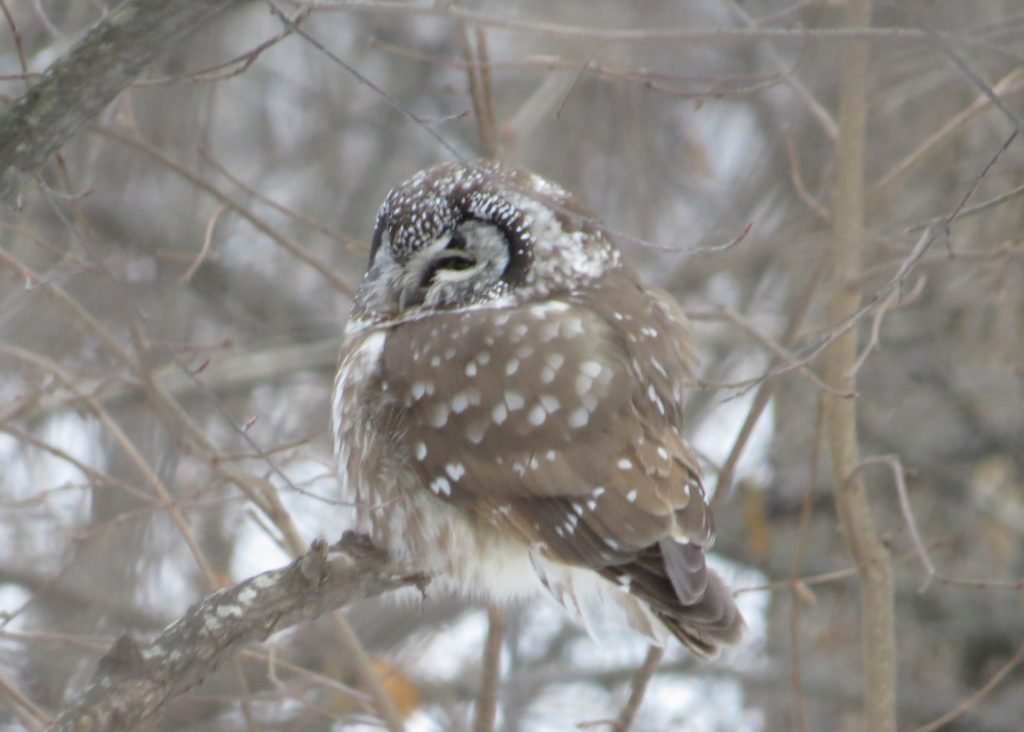 And then:
And then:
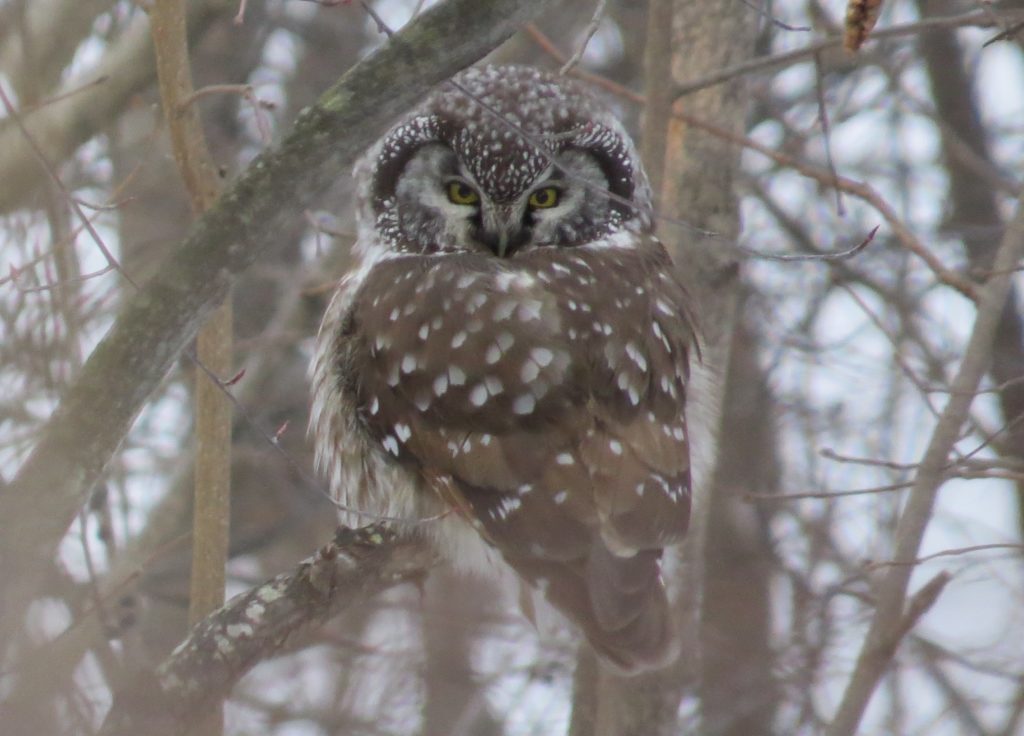
Even Evan was in awe, saying how cool this was. I was genuinely surprised at this reaction from the kid who has turned down seeing Flammulated and Whiskered Screech-Owls. “This is so cool! Dad, I see its face!”
Conditions for viewing were not perfect. I was sitting in the snow in jeans to get these photos. Eventually this sluggish bird came to life and started actively hunting! The photo opportunities (and the crowd size) started to increase.
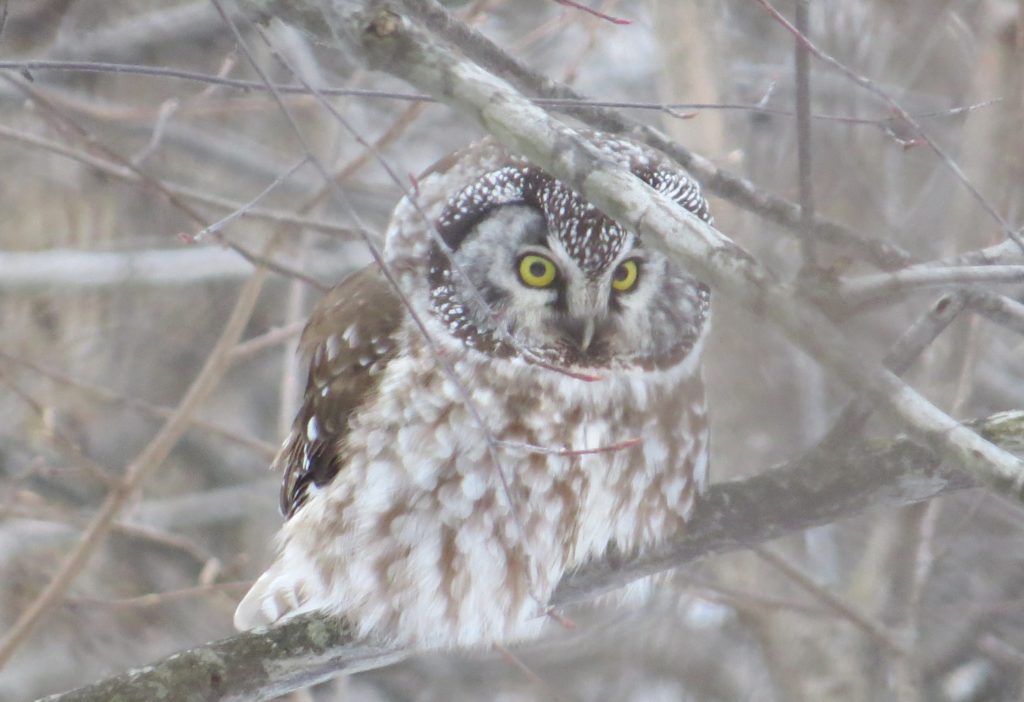
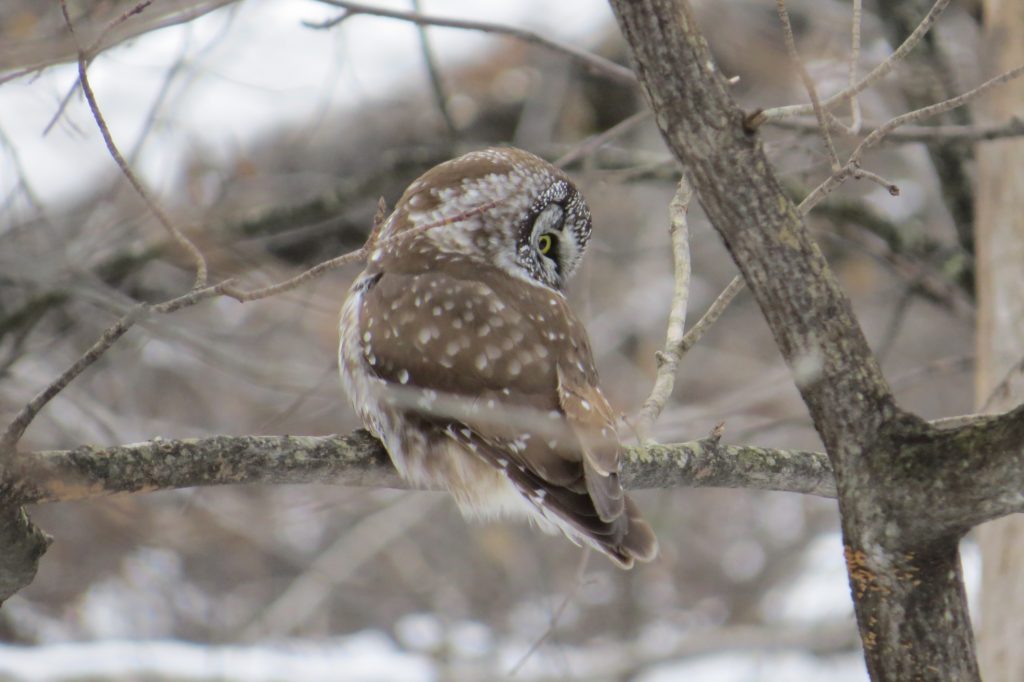
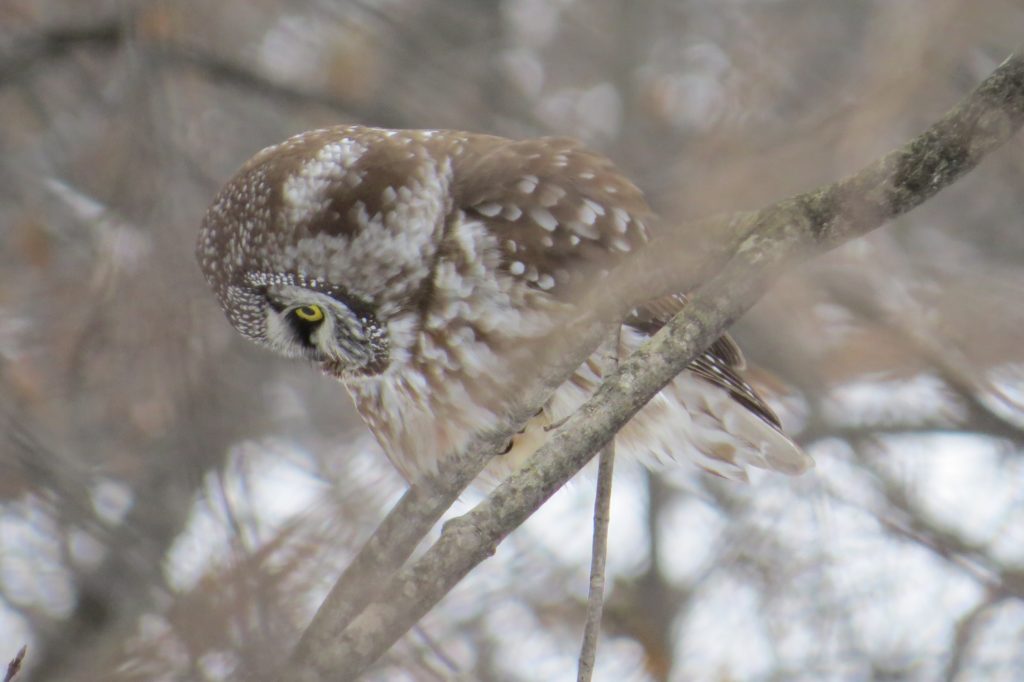
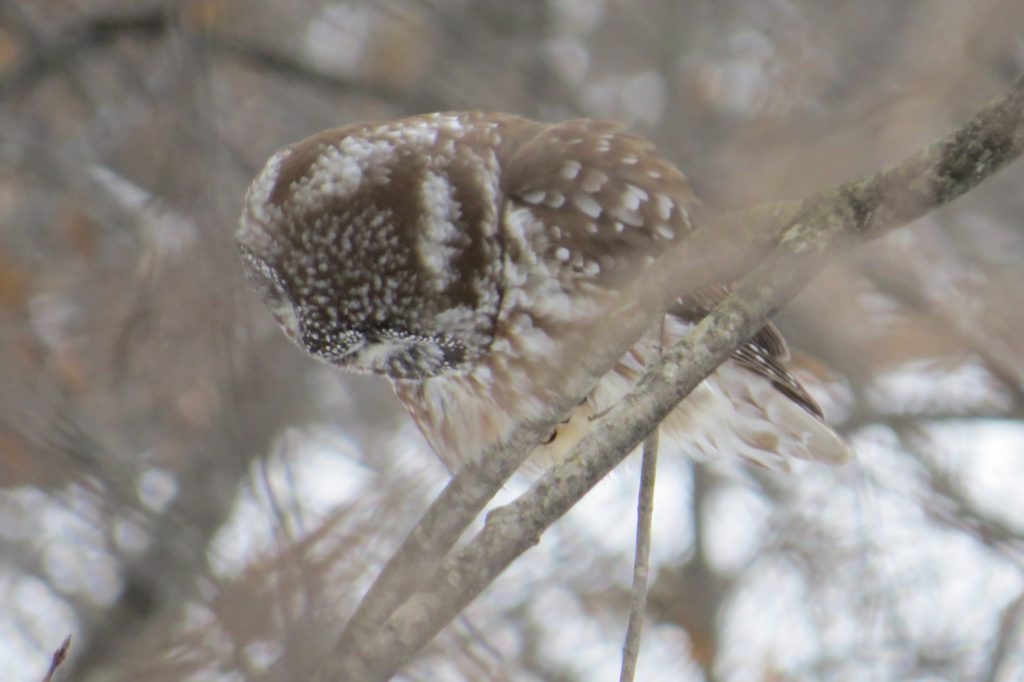 This was, by far, the coolest Owl I had ever seen. This Owl eventually flew away from this spot. I noticed it actually flew close to a different trail. John Richardson and I walked that way and spotted it on top of a brush pile. The views were much better and gave me my best Boreal photo, which Jeff helped me enhance.
This was, by far, the coolest Owl I had ever seen. This Owl eventually flew away from this spot. I noticed it actually flew close to a different trail. John Richardson and I walked that way and spotted it on top of a brush pile. The views were much better and gave me my best Boreal photo, which Jeff helped me enhance.
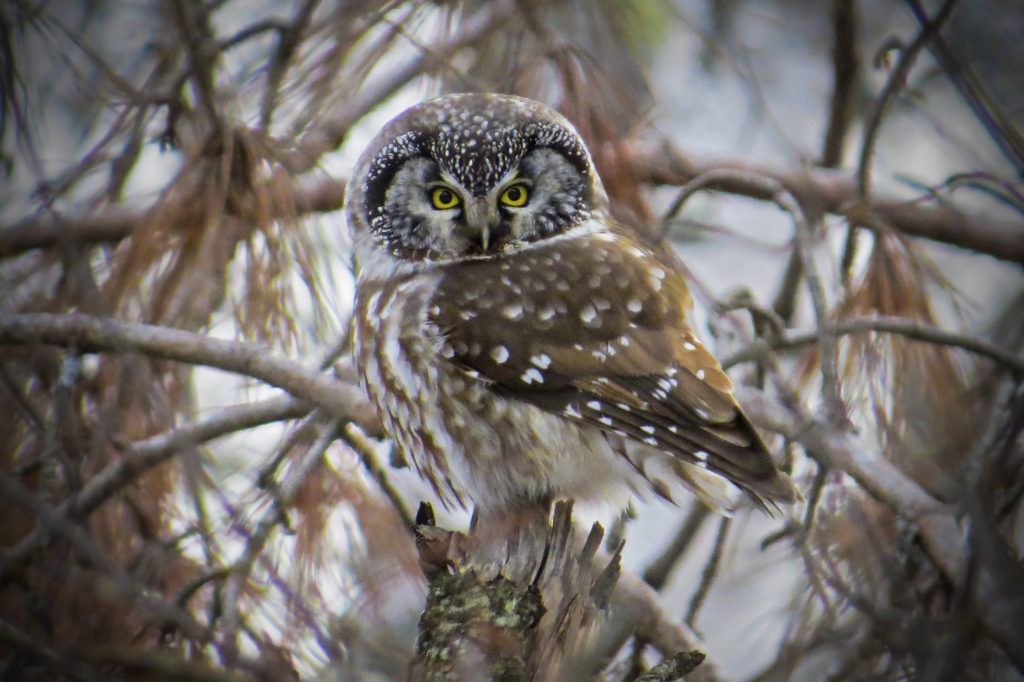
Evan was cold at this point and wanted to wait in the car while I continued to enjoy the bird. I walked him back to the car. When I returned, the Owl (and the crowd) had moved.
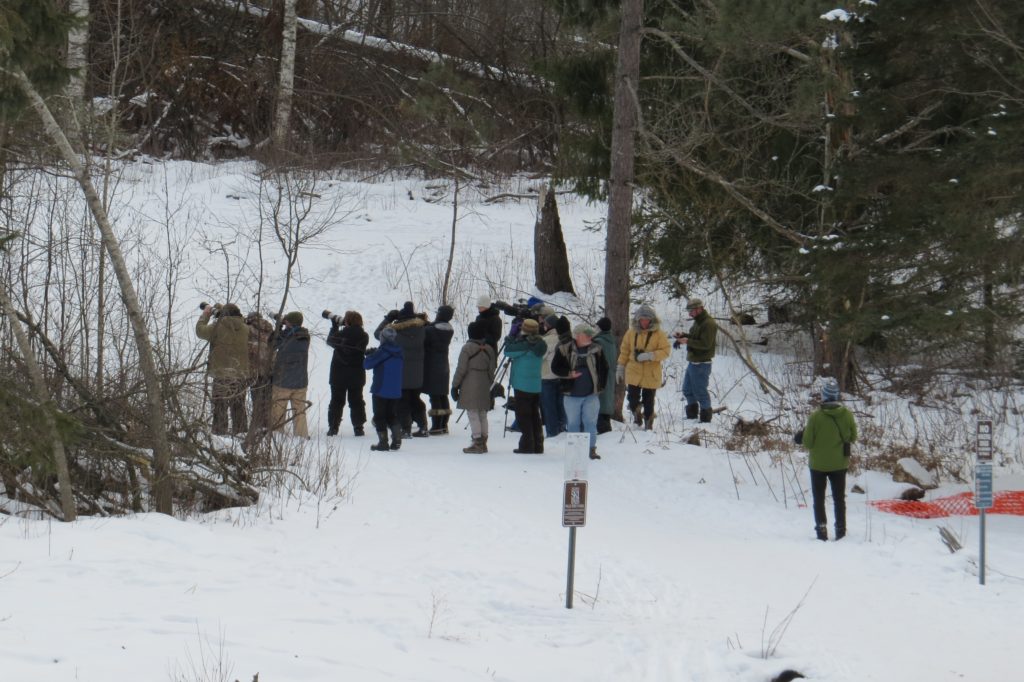 The Owl was now very close to the trails and out in the open. I felt bad that Jeff wasn’t there to experience these photo opportunities; he had not felt well after the Twin Cities Boreal expedition and decided not to come north.
The Owl was now very close to the trails and out in the open. I felt bad that Jeff wasn’t there to experience these photo opportunities; he had not felt well after the Twin Cities Boreal expedition and decided not to come north.
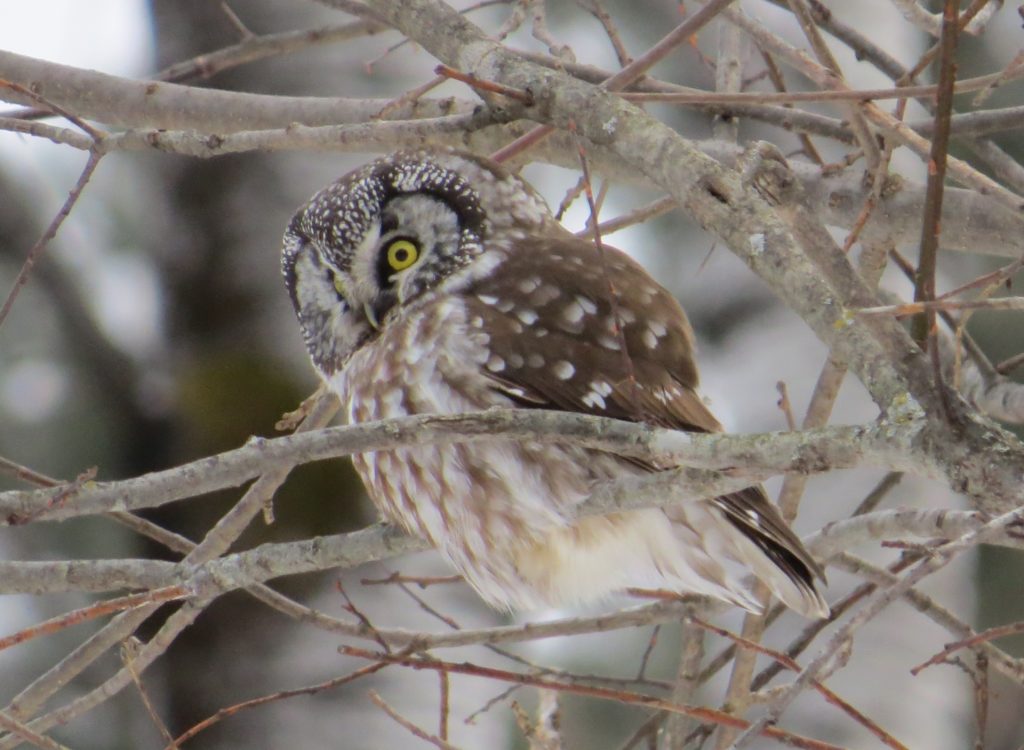 Books describe Boreals as having a surprised look on their face. It is definitely true.
Books describe Boreals as having a surprised look on their face. It is definitely true. 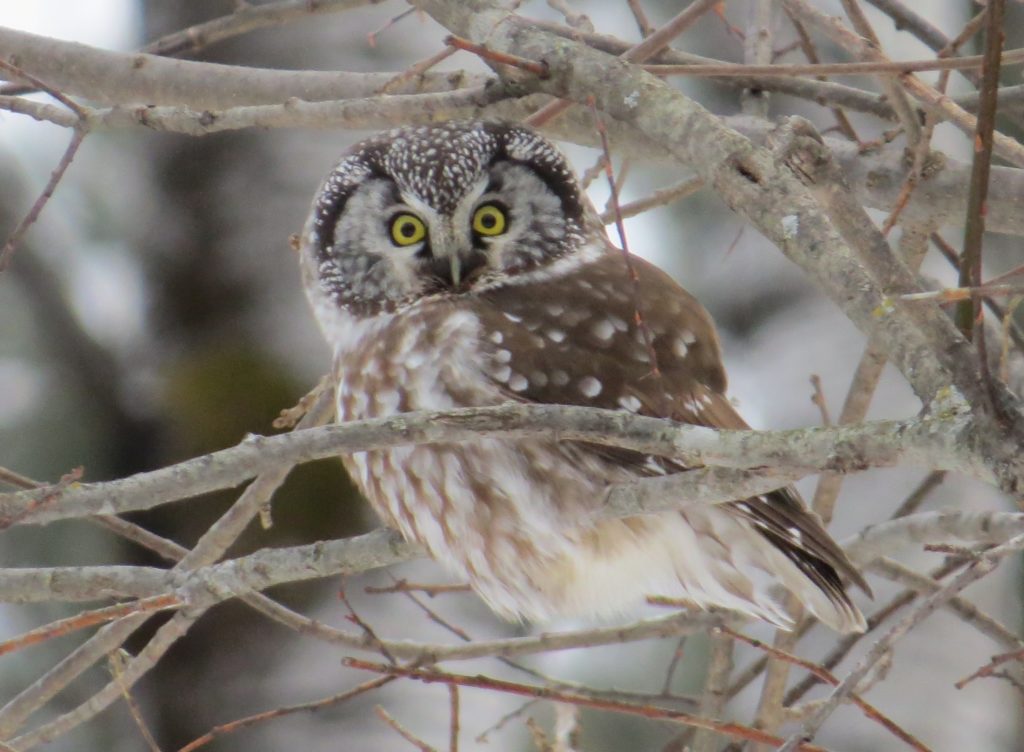
Finally, I had been satisfied enough to pry myself away from this spectacular bird. Evan and I could continue on our trip to Grand Marais in perfect peace, even if my pants were soaking wet for the two-hour drive. The Grand Marais birder with the Boreal Owl in his yard never did call me, so things worked out perfectly. It was a dream come true. We had brought our birding full circle from that very first year; we were now members of the Boreal Owl Club. Evan and I celebrated by eating supper in Grand Marais at a family favorite restaurant, Sven & Ole’s Pizza.

Josh Watson, of Kandiyohi County Blue Grosbeak fame, stopped by to join us for a celebratory beer (Evan had ice cream) and we had a nice visit about Boreal Owls and other cool birds of the North and beyond. It’s always fun to catch up with birder friends you don’t see often. It was just a great way to end a great day.
The next morning, Evan I got up and poked around Grand Marais for cool birds. We didn’t find much, but it didn’t matter–it was a completely relaxing trip now with zero anxiety. Jeff was on his way up to Duluth that morning to see if he could get onto a good look of a Boreal Owl. Evan and I continued to look for Boreals on our way southwest to Duluth. We were hoping we could find one for Jeff. One of our stops was Sugarloaf Cove Nature Center where we were hoping to find a Boreal on a little hike. No Boreals, were had, but Evan was excited to get a lifer Snowshoe Hare. 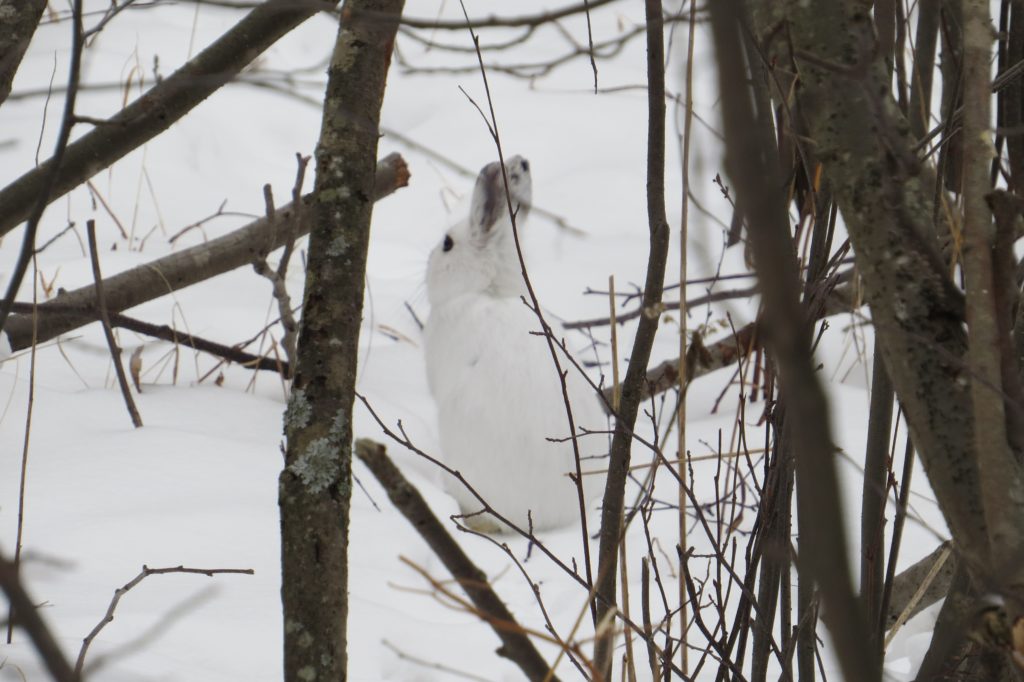 We also took a moment to take a Lake Superior selfie.
We also took a moment to take a Lake Superior selfie.
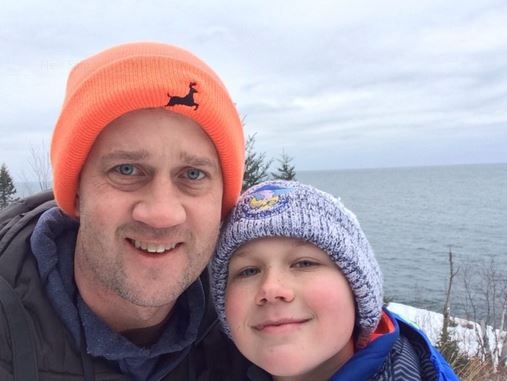
Once again, we stopped in Two Harbors to poke around. Of course we wanted to find a Boreal Owl there, but we also took a moment to get Evan a Harlequin Duck lifer, one of two continuing birds in Agate Bay along the jetty. These birds could be seen very well with the naked eye.
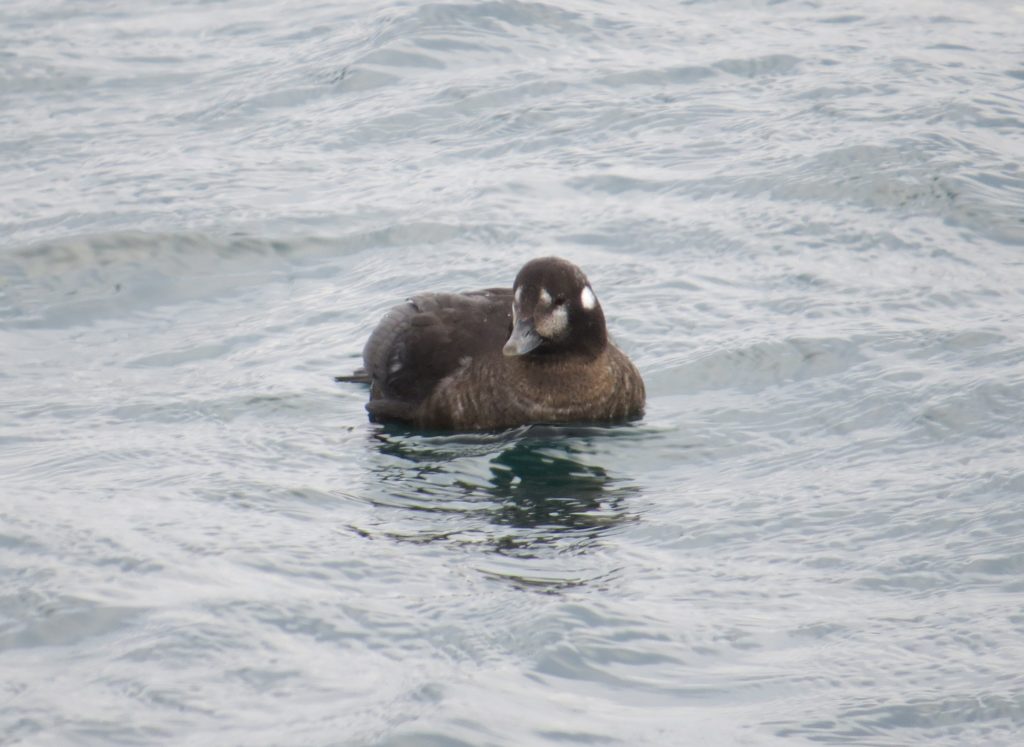
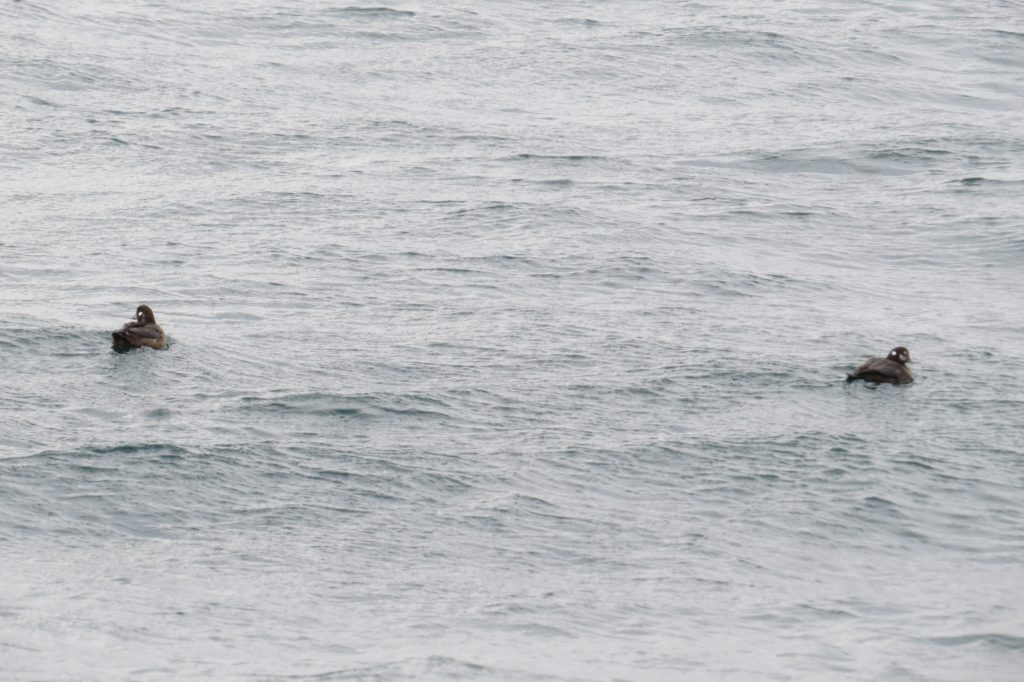 We had barely been in Two Harbors when I got a message from Jeff that he had found his very own Boreal Owl down by Duluth! I was happy he had finally gotten good looks at a bird low and in the open. Knowing there were Great Gray Owls in the area, I asked Evan what we should do. Evan thinks like a true birder because he said we should go after Jeff’s Boreal since we can see Great Grays any year. So once again we were on our way back to Duluth for a Boreal Owl. This one was snoozing in a tree right along Scenic 61. That, combined with the fact that we had gotten our Boreal the day before, meant we did not have to rush this time. Sure enough, this Boreal was right where Jeff had spotted it.
We had barely been in Two Harbors when I got a message from Jeff that he had found his very own Boreal Owl down by Duluth! I was happy he had finally gotten good looks at a bird low and in the open. Knowing there were Great Gray Owls in the area, I asked Evan what we should do. Evan thinks like a true birder because he said we should go after Jeff’s Boreal since we can see Great Grays any year. So once again we were on our way back to Duluth for a Boreal Owl. This one was snoozing in a tree right along Scenic 61. That, combined with the fact that we had gotten our Boreal the day before, meant we did not have to rush this time. Sure enough, this Boreal was right where Jeff had spotted it.
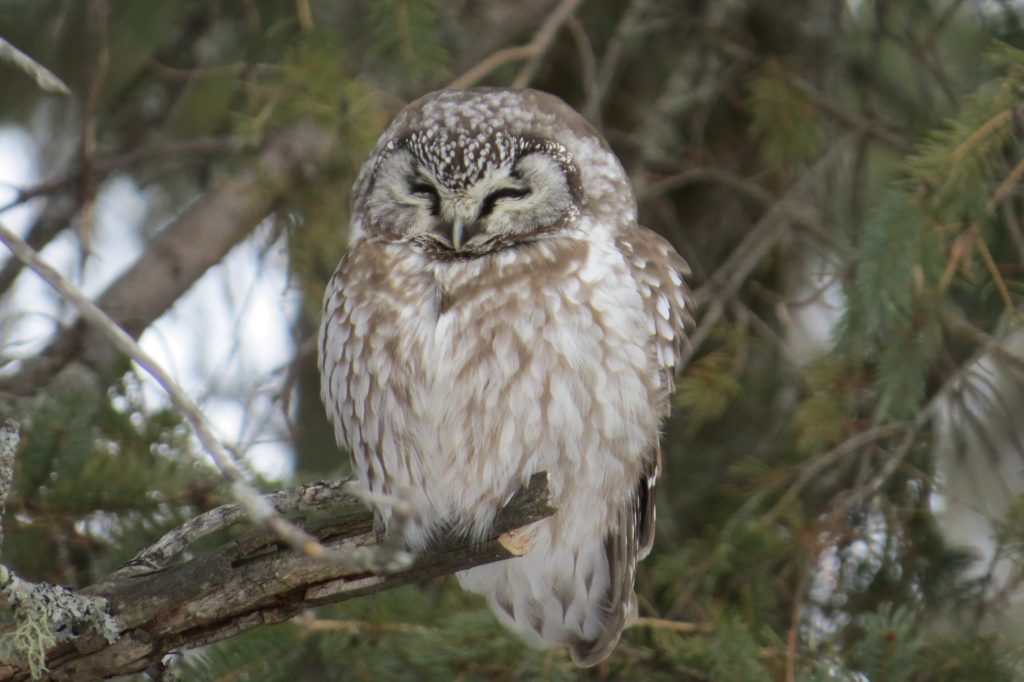 Some people, like myself, have trouble spotting these Owls. Thankfully, people like Evan can point them out.
Some people, like myself, have trouble spotting these Owls. Thankfully, people like Evan can point them out.
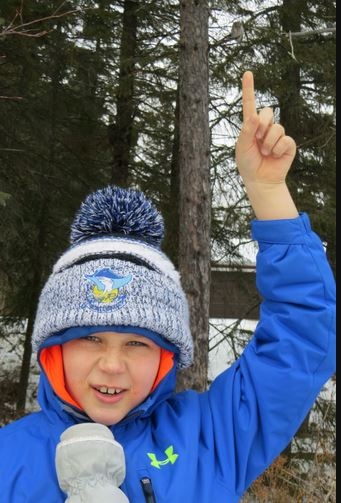
What a trip–three Boreal Owls! It was beyond a dream come true. This trip with Evan was second only to the Greater Sage-Grouse trip he and I took three years ago. Many thanks to all the people that helped us, especially the Hosch Bros, Kelly Raymond, Erik Berg, and most importantly, Jeff Grotte who helped me get on all three of these birds after he and I shared the Boreal-less struggle for so long together.
There is now just one Owl left for me to find in the United States. I’m hoping that happens in 2018. But first there will hopefully be some more Boreal Owl encounters this winter–we will be helping legendary Arizona birders Tommy DeBardeleben and Janet Witzeman hopefully get on a Boreal or two. Speaking of Arizona, the next blog post will feature a few lifers and other favorites I picked up on a trip there last weekend.

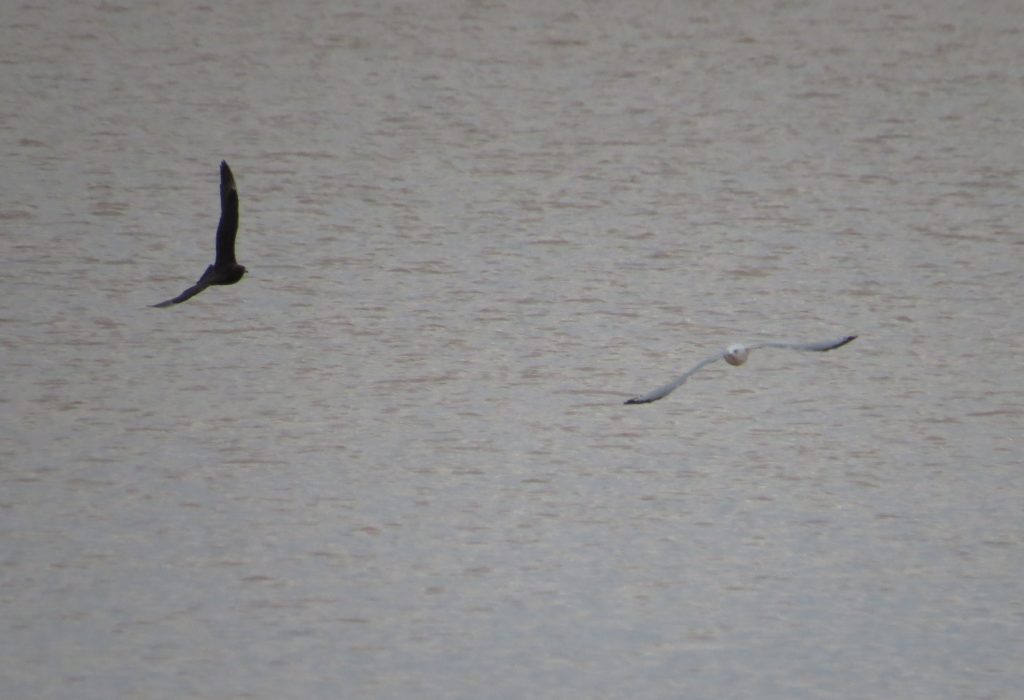
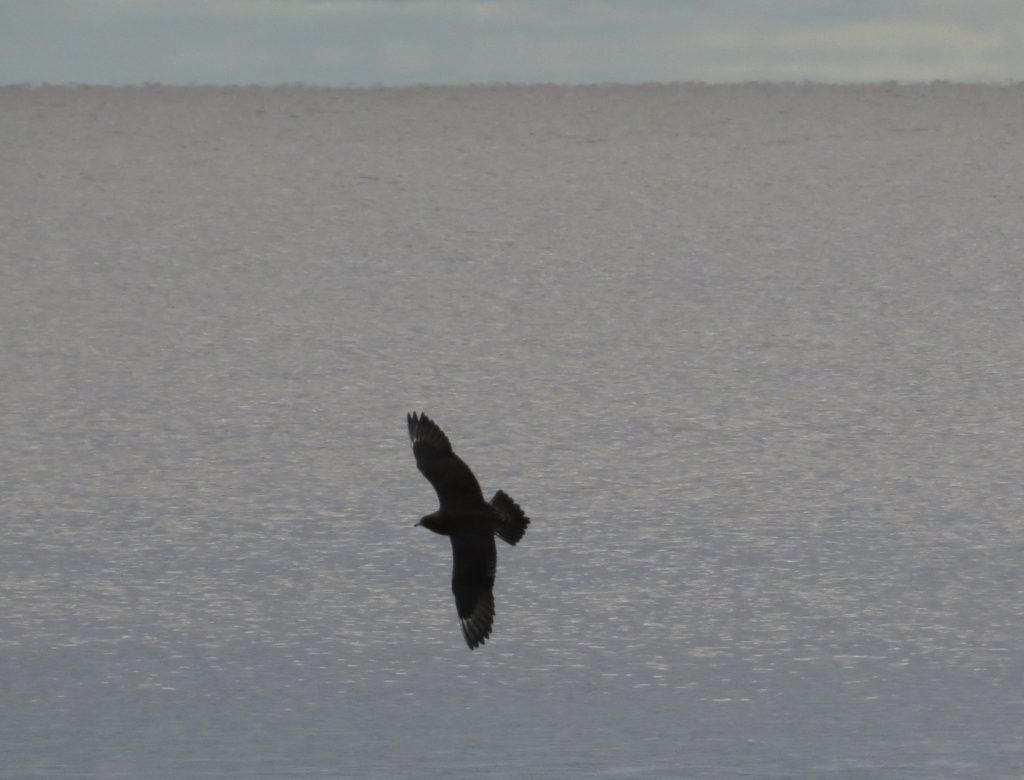
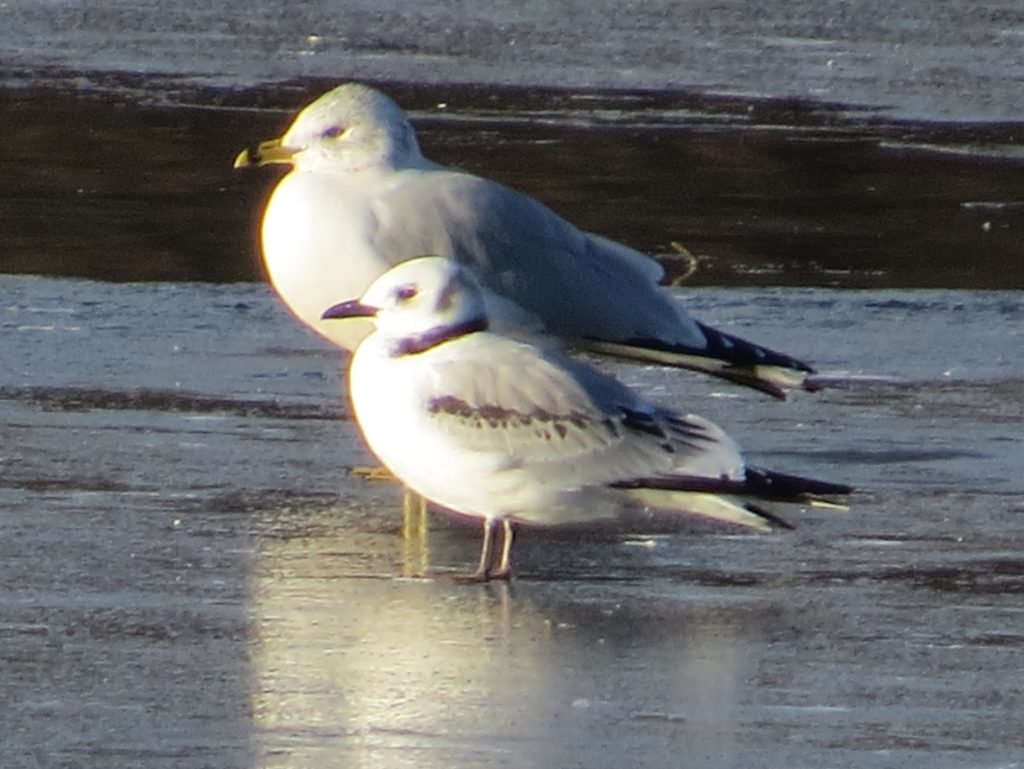
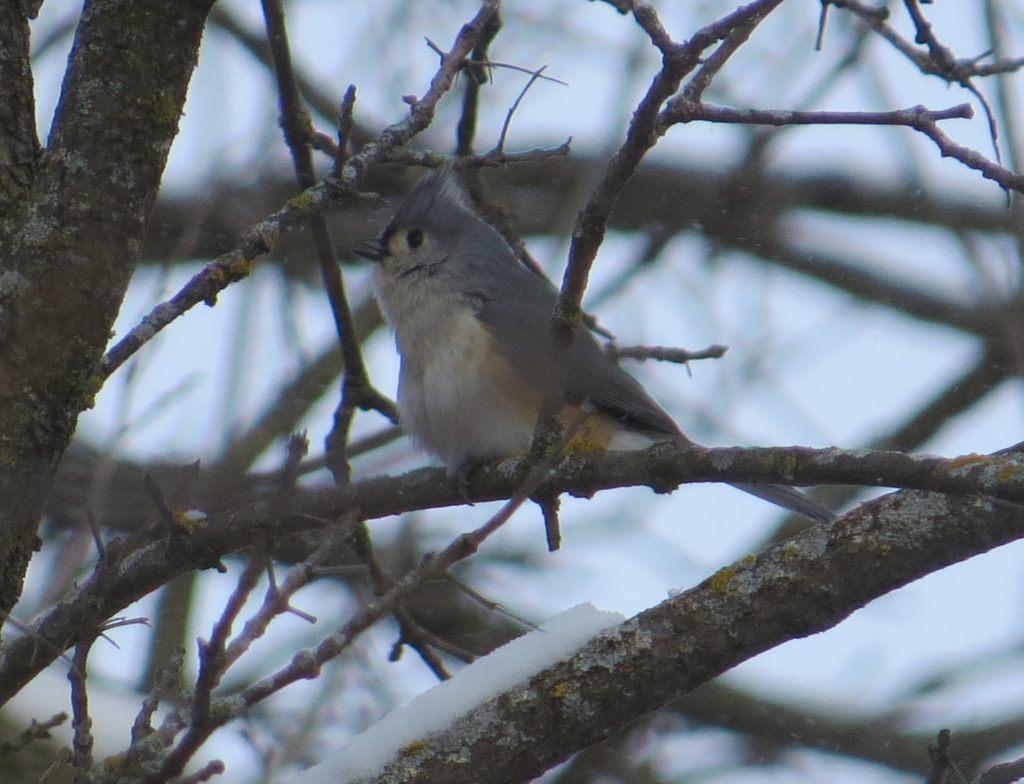
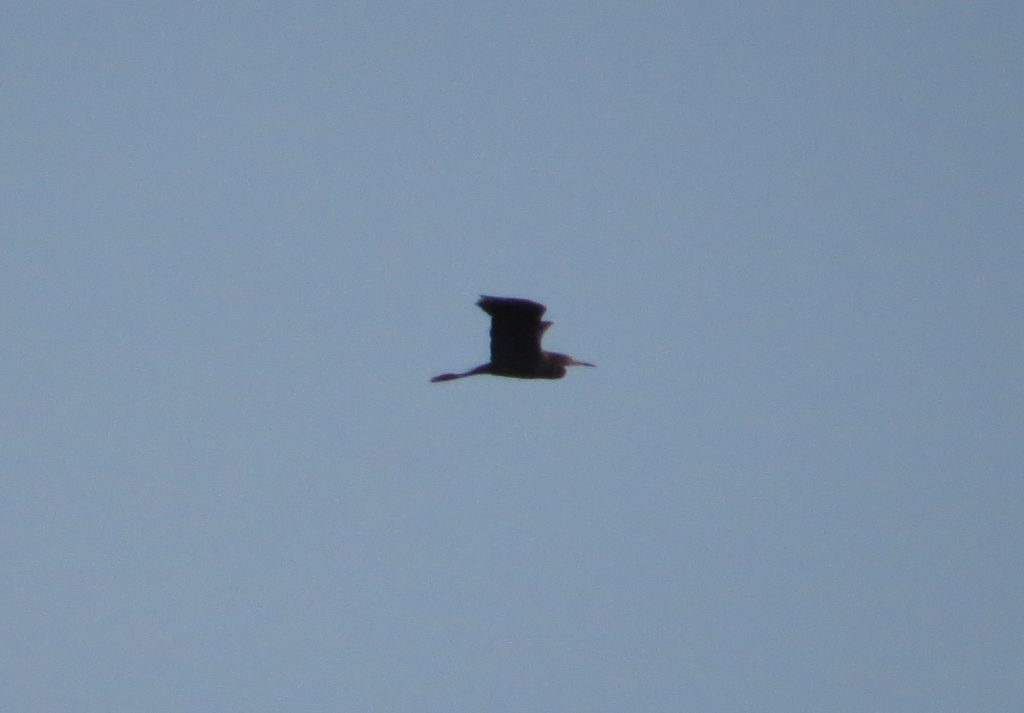
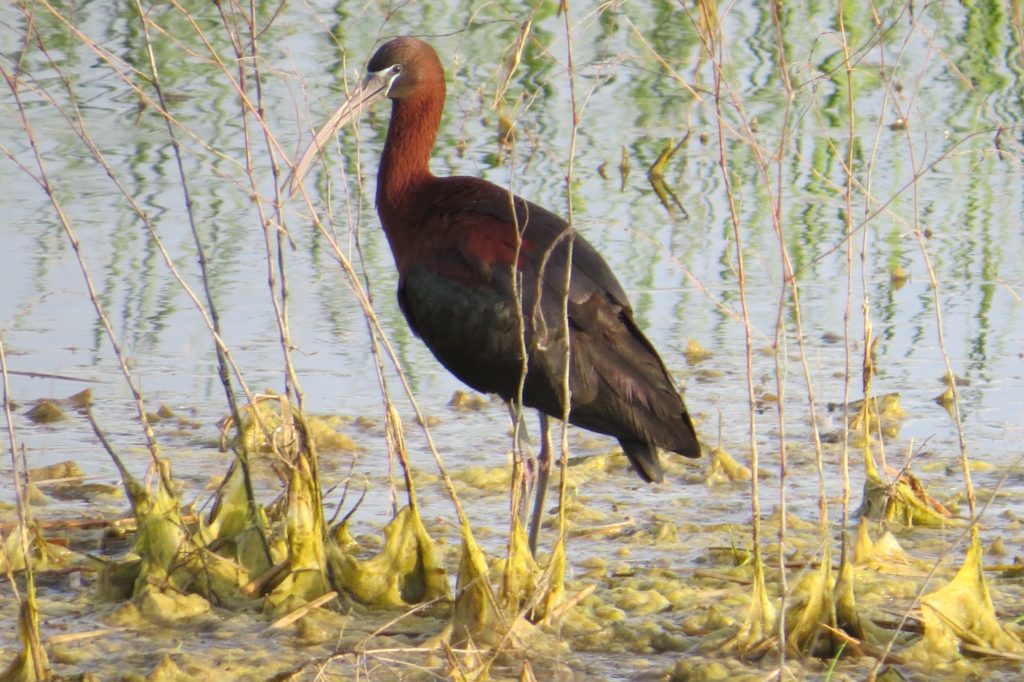
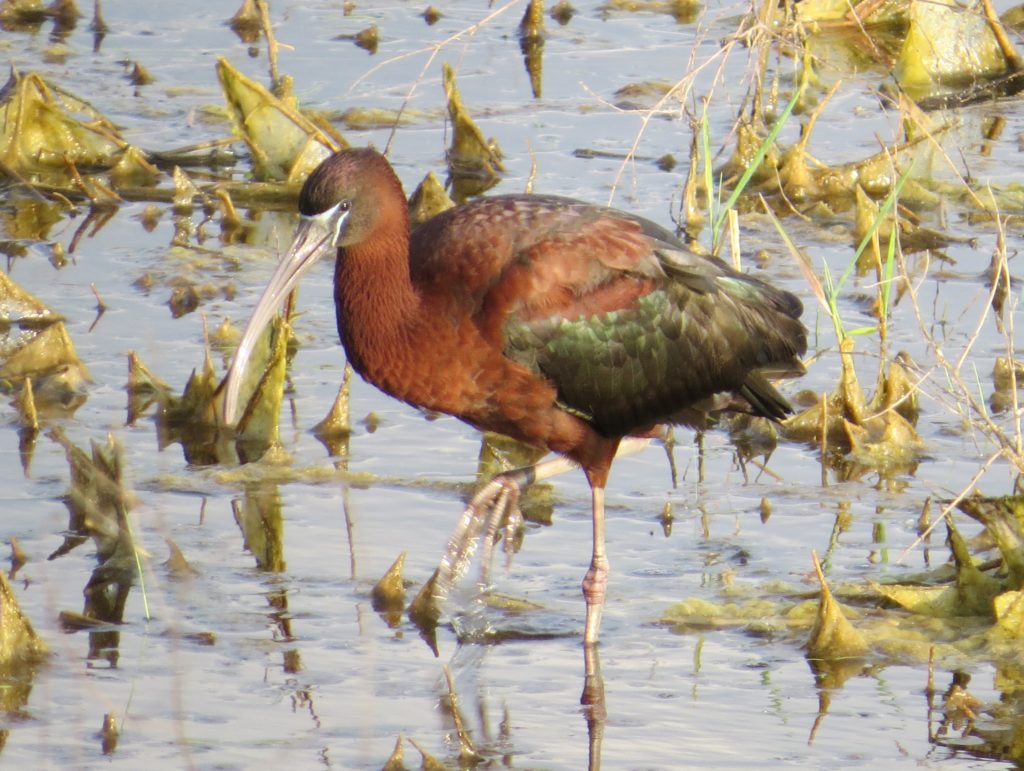 Steve and I were pretty thrilled with going 2/3 on our targets. In addition to these birds, we also nabbed some nice birds that we don’t get to see too often, like this Snowy Egret.
Steve and I were pretty thrilled with going 2/3 on our targets. In addition to these birds, we also nabbed some nice birds that we don’t get to see too often, like this Snowy Egret.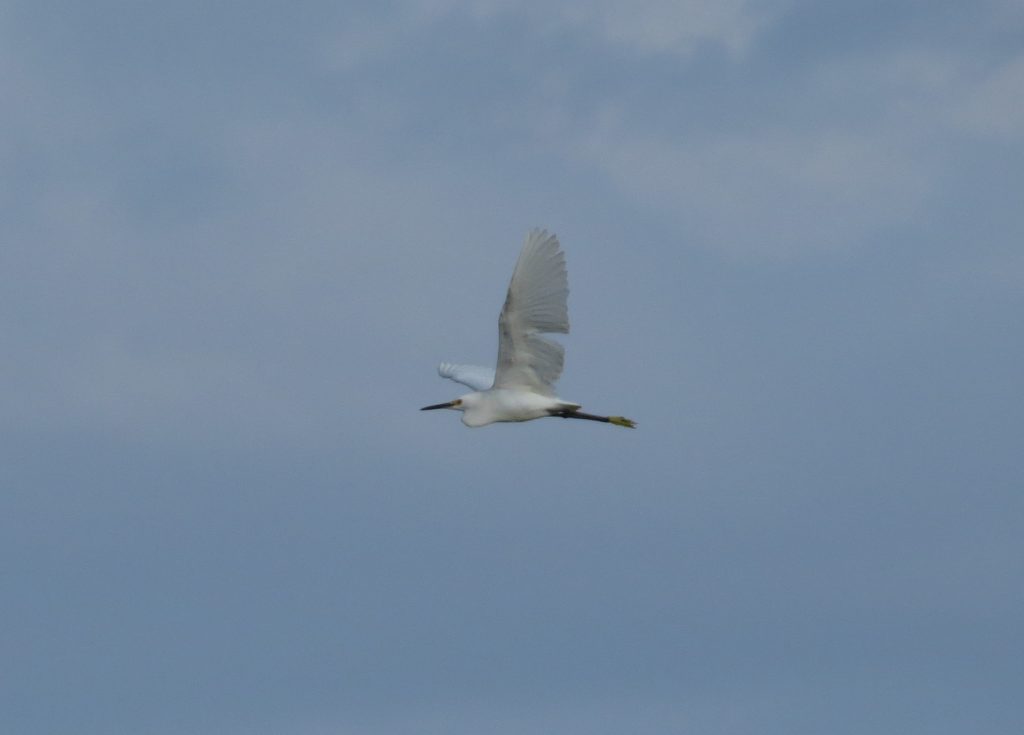
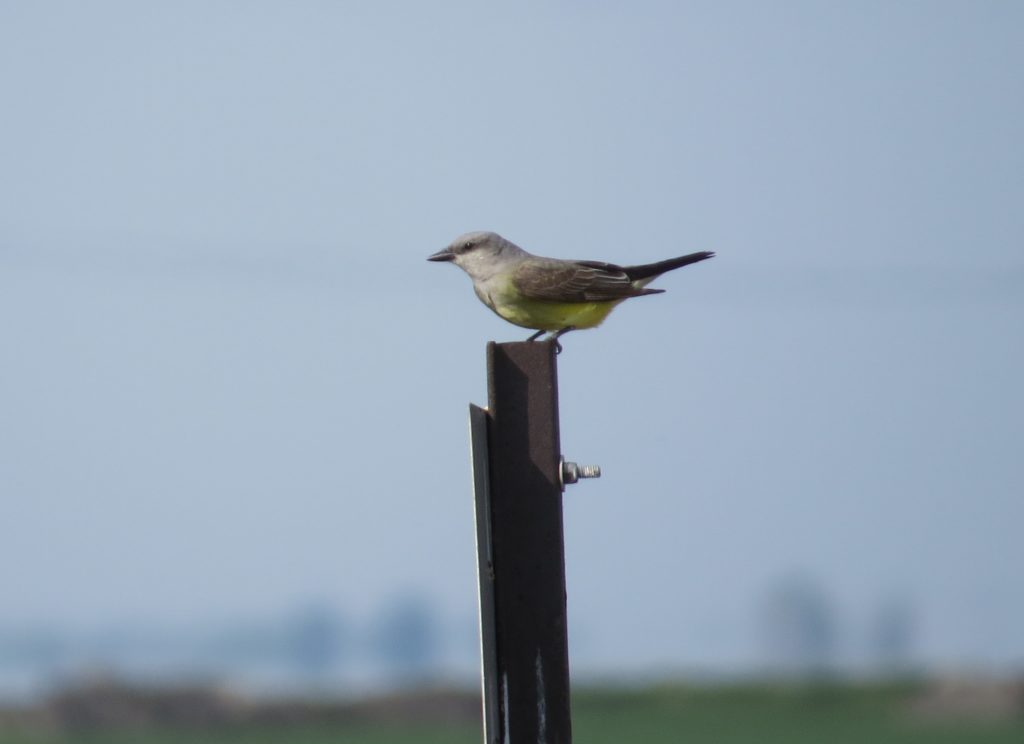 And who does not love seeing an Upland Sandpiper, especially one so crushable?
And who does not love seeing an Upland Sandpiper, especially one so crushable?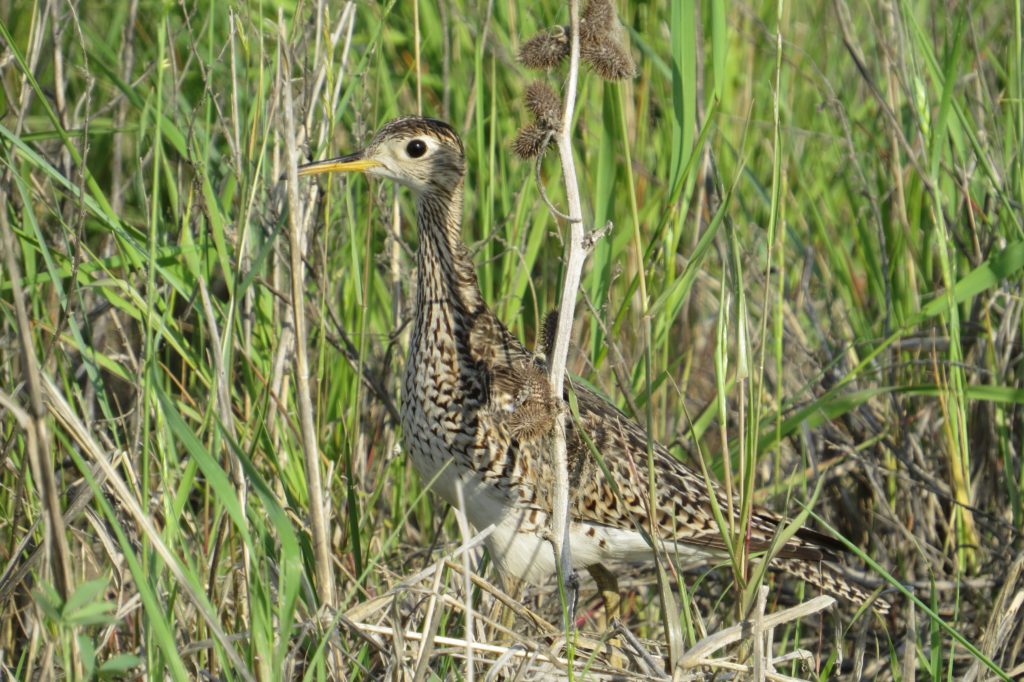
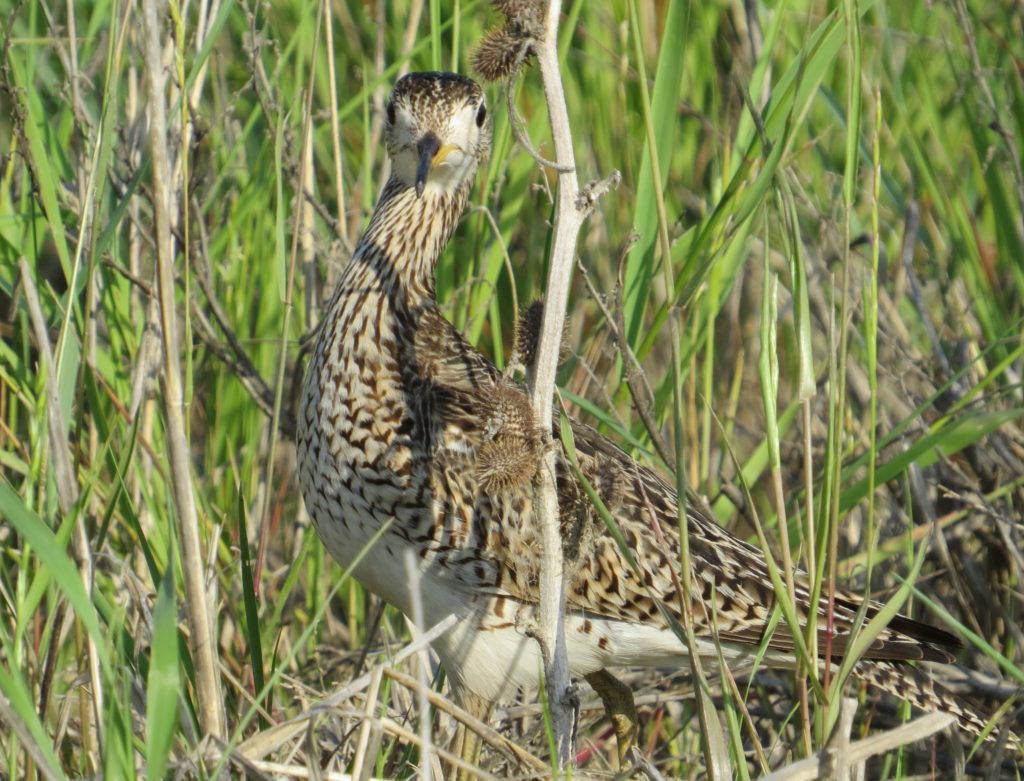 Steve and I felt pretty darn good about our trip and our nice haul of birds. We were completely satisfied, until….
Steve and I felt pretty darn good about our trip and our nice haul of birds. We were completely satisfied, until….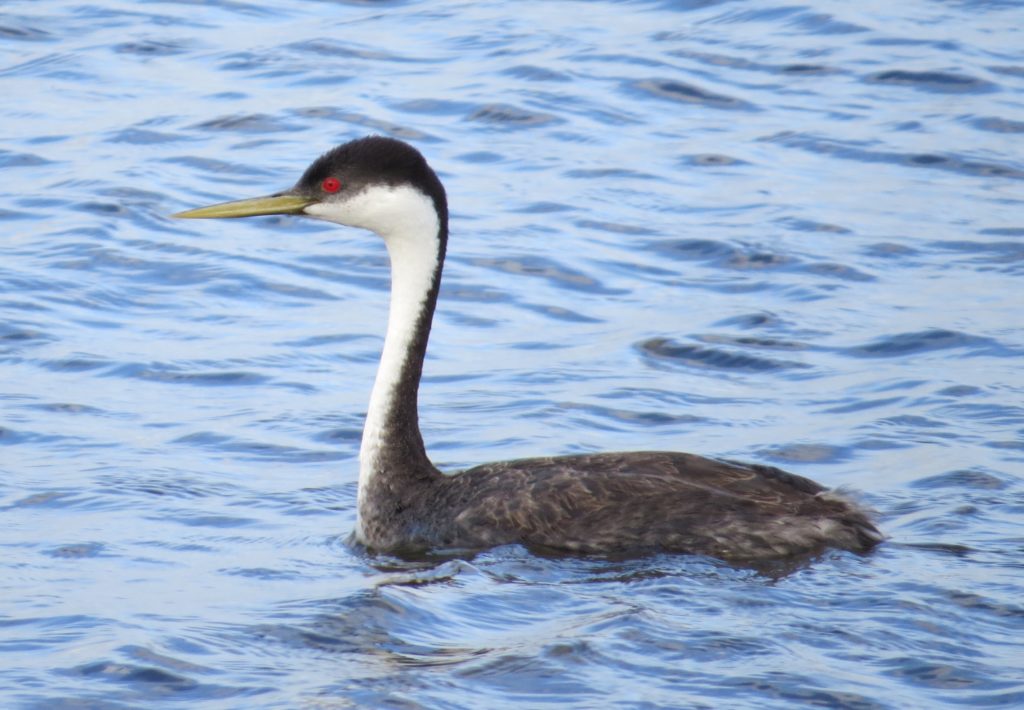 Steve and I did, however, see another casual species that was also discovered during this historic period of MN birding which I have failed to disclose in the timeline. A pair of Black-necked Stilts had set up shop in one of the shallow pools of the Impoundment. Considering I already had Black-necked Stilts for Grant County from several years ago and that Steve had just gotten this state bird recently, we just weren’t too fired up about it, especially after our double dip.
Steve and I did, however, see another casual species that was also discovered during this historic period of MN birding which I have failed to disclose in the timeline. A pair of Black-necked Stilts had set up shop in one of the shallow pools of the Impoundment. Considering I already had Black-necked Stilts for Grant County from several years ago and that Steve had just gotten this state bird recently, we just weren’t too fired up about it, especially after our double dip.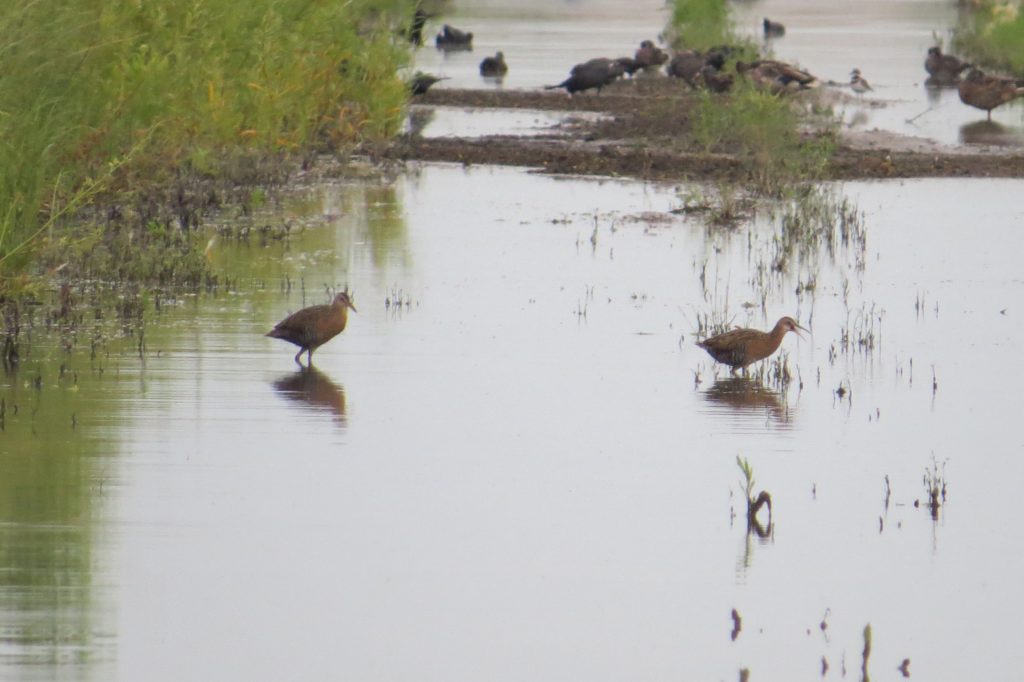 Look at the size of these things compared to the Mallards in the background. No wonder it’s the King of the Rails.
Look at the size of these things compared to the Mallards in the background. No wonder it’s the King of the Rails.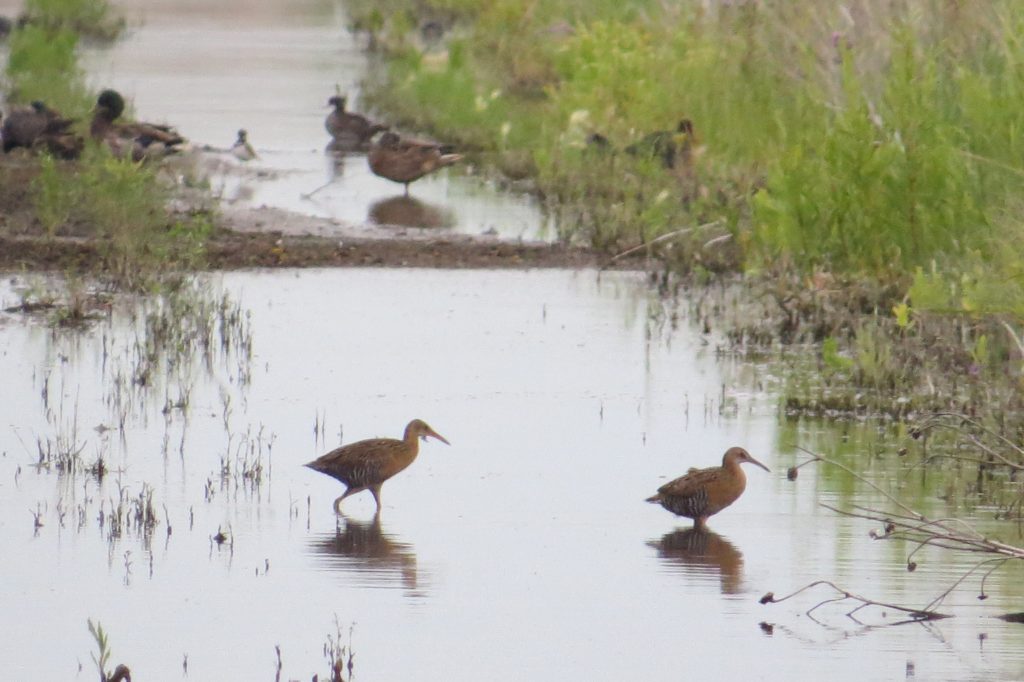
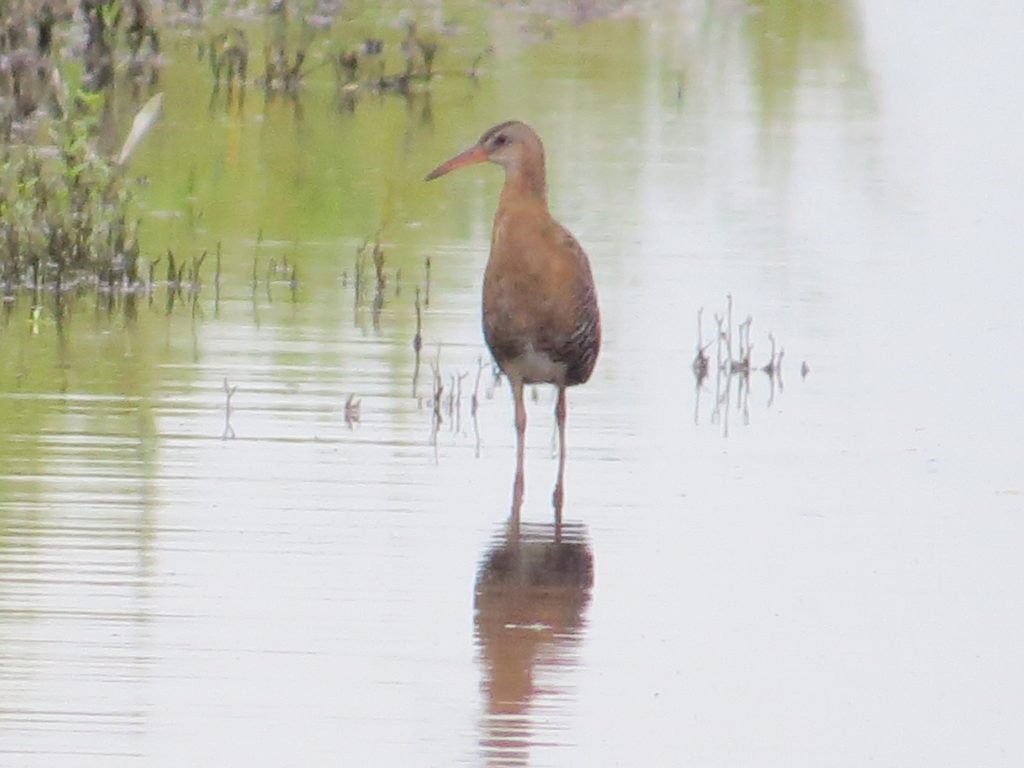 Birding is a roller coaster of emotions, and Steve and I were back on top after this sighting. Steve suggested we try for those Nelson’s Sparrows again. Despite our good fortune of the morning, I was skeptical we would find the Sparrows. But not looking certainly guarantees that outcome. So we walked the dike berm that we had a week ago. This time it definitely felt more Sparrowy–no wind, early morning, etc. We played the tape and didn’t get a response. Then a couple minutes later, I heard the recording, or what I thought was the recording, again. I asked Steve if he had left his phone app on. When he replied that he hadn’t we knew were hearing the real deal! We continued to work the area, and eventually we saw two Nelson’s Sparrows!
Birding is a roller coaster of emotions, and Steve and I were back on top after this sighting. Steve suggested we try for those Nelson’s Sparrows again. Despite our good fortune of the morning, I was skeptical we would find the Sparrows. But not looking certainly guarantees that outcome. So we walked the dike berm that we had a week ago. This time it definitely felt more Sparrowy–no wind, early morning, etc. We played the tape and didn’t get a response. Then a couple minutes later, I heard the recording, or what I thought was the recording, again. I asked Steve if he had left his phone app on. When he replied that he hadn’t we knew were hearing the real deal! We continued to work the area, and eventually we saw two Nelson’s Sparrows!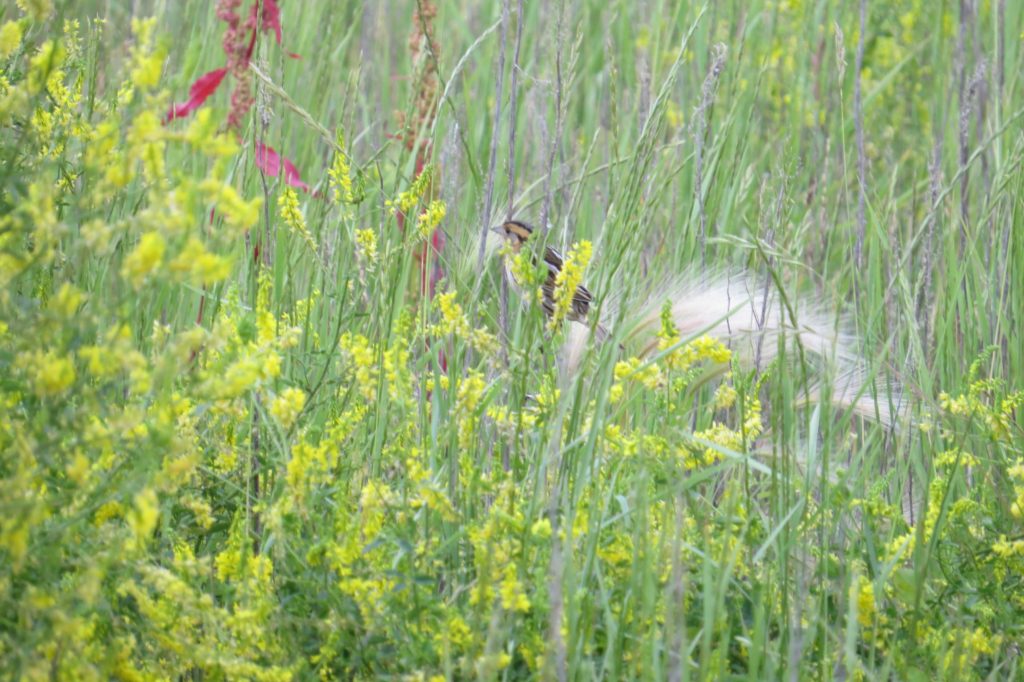 With some pishing we were able to get them to pop up for some great looks at these skulkers.
With some pishing we were able to get them to pop up for some great looks at these skulkers.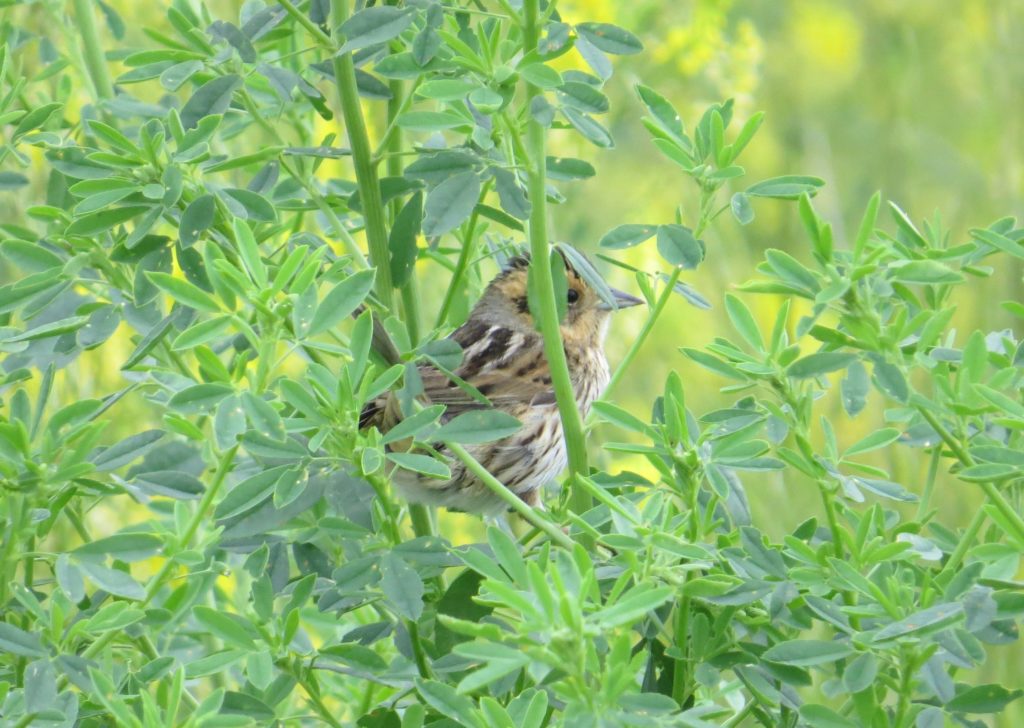
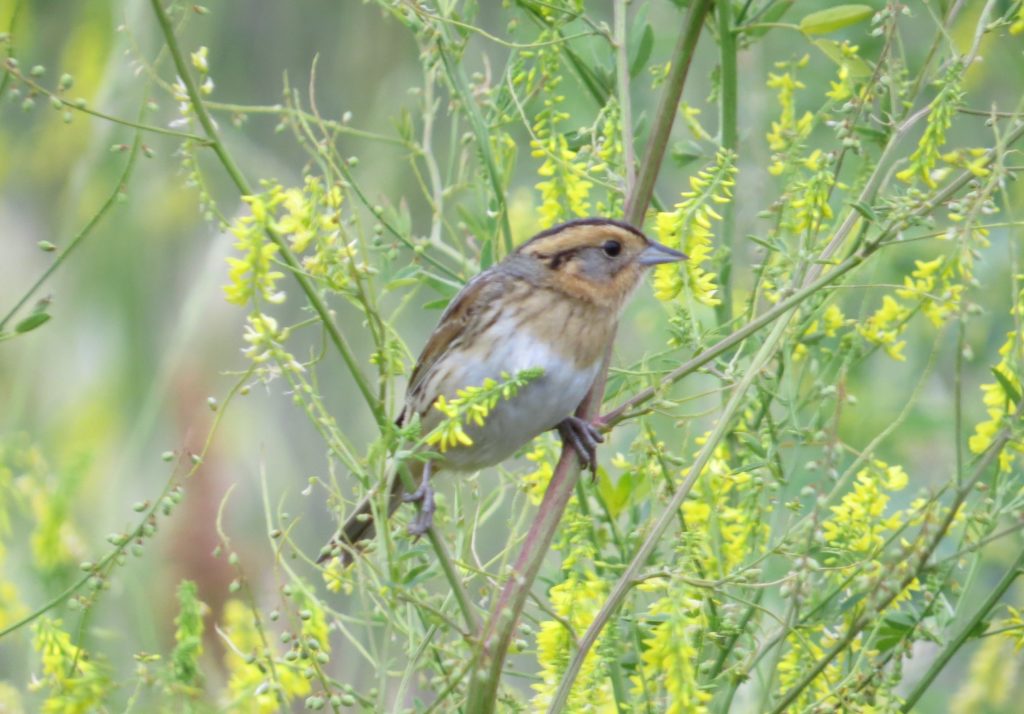 Steve and I followed these birds around for a bit, thoroughly soaking up the experience. I don’t think either of us ever expected to lifer on this bird with such good looks. We certainly didn’t expect to get this lifer in Grant County. This nighttime singer is often a heard-only bird that people trek to middle of nowhere (McGregor) to find in the middle of the night. We were stupefied. Talking it over on the ride home, we concluded that the Nelson’s Sparrow lifer experience topped the King Rails even though the Sparrow is a summer resident in our state. More than once I have been surprised by how much of an impact a Sparrow lifer has on me. A huge thanks goes out to Becca Engdahl for her find and her tips on locating it!
Steve and I followed these birds around for a bit, thoroughly soaking up the experience. I don’t think either of us ever expected to lifer on this bird with such good looks. We certainly didn’t expect to get this lifer in Grant County. This nighttime singer is often a heard-only bird that people trek to middle of nowhere (McGregor) to find in the middle of the night. We were stupefied. Talking it over on the ride home, we concluded that the Nelson’s Sparrow lifer experience topped the King Rails even though the Sparrow is a summer resident in our state. More than once I have been surprised by how much of an impact a Sparrow lifer has on me. A huge thanks goes out to Becca Engdahl for her find and her tips on locating it!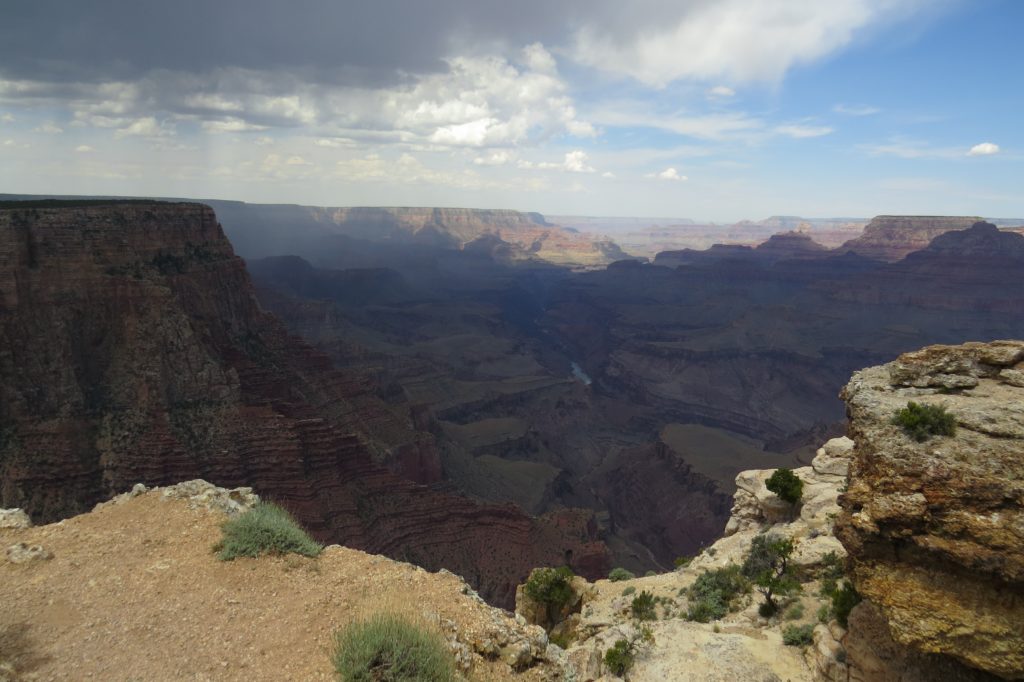 Technically speaking it was not a lifer for me as I had been here as a small child. Since I have no memory of it and I have a family of my own who hadn’t seen it, the time was right for a visit. Plus, the visit to Grand Canyon National Park was completely FREE thanks to the government’s Every Kid in a Park program where each 4th grade student in America can get his/her entire family and vehicle into any national park all summer long at no cost. The lack of entry fee was definitely the icing on the cake because this place is impressive regardless. The grandeur of the Grand Canyon and how it makes you feel when you are standing next to that vastness is nearly impossible to describe in words and capture in photographs. Hopefully these kids will at least remember the experience.
Technically speaking it was not a lifer for me as I had been here as a small child. Since I have no memory of it and I have a family of my own who hadn’t seen it, the time was right for a visit. Plus, the visit to Grand Canyon National Park was completely FREE thanks to the government’s Every Kid in a Park program where each 4th grade student in America can get his/her entire family and vehicle into any national park all summer long at no cost. The lack of entry fee was definitely the icing on the cake because this place is impressive regardless. The grandeur of the Grand Canyon and how it makes you feel when you are standing next to that vastness is nearly impossible to describe in words and capture in photographs. Hopefully these kids will at least remember the experience.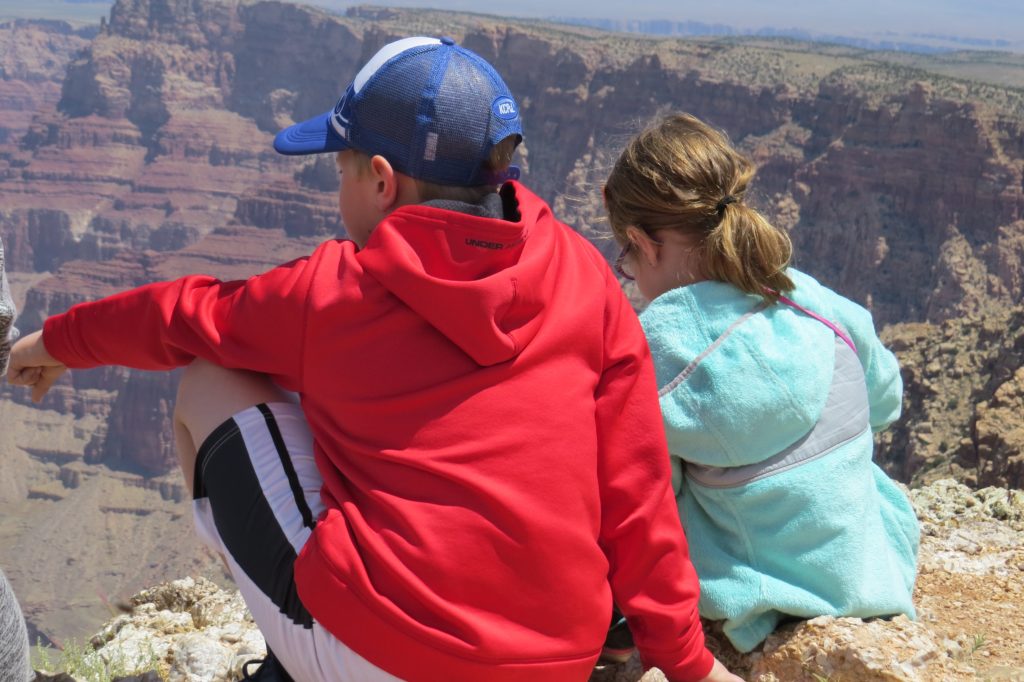
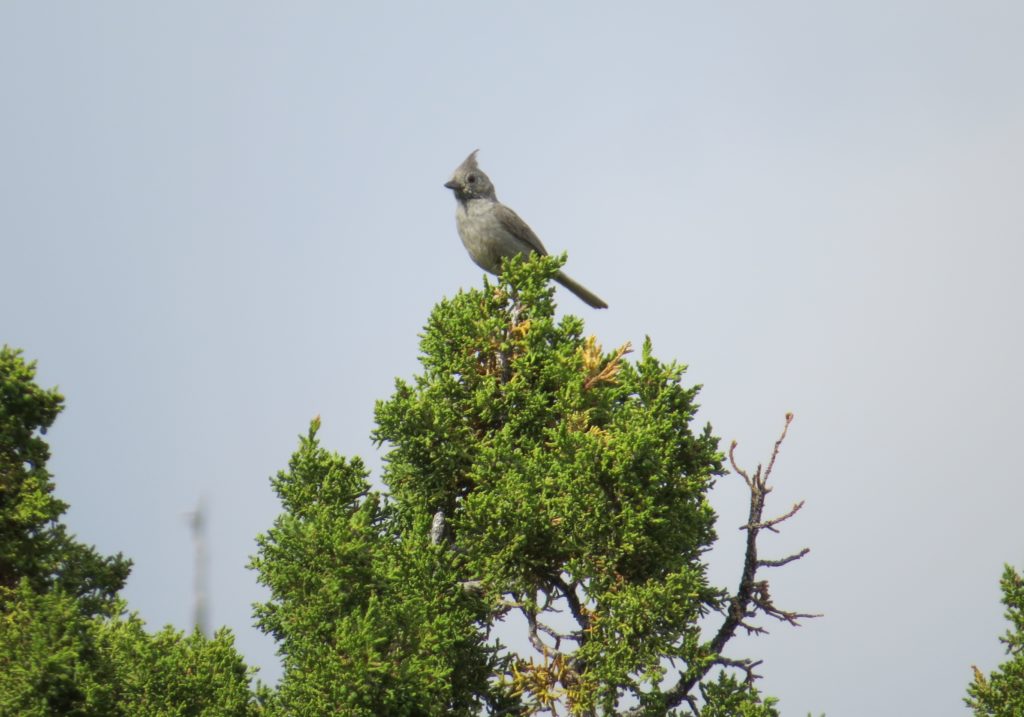
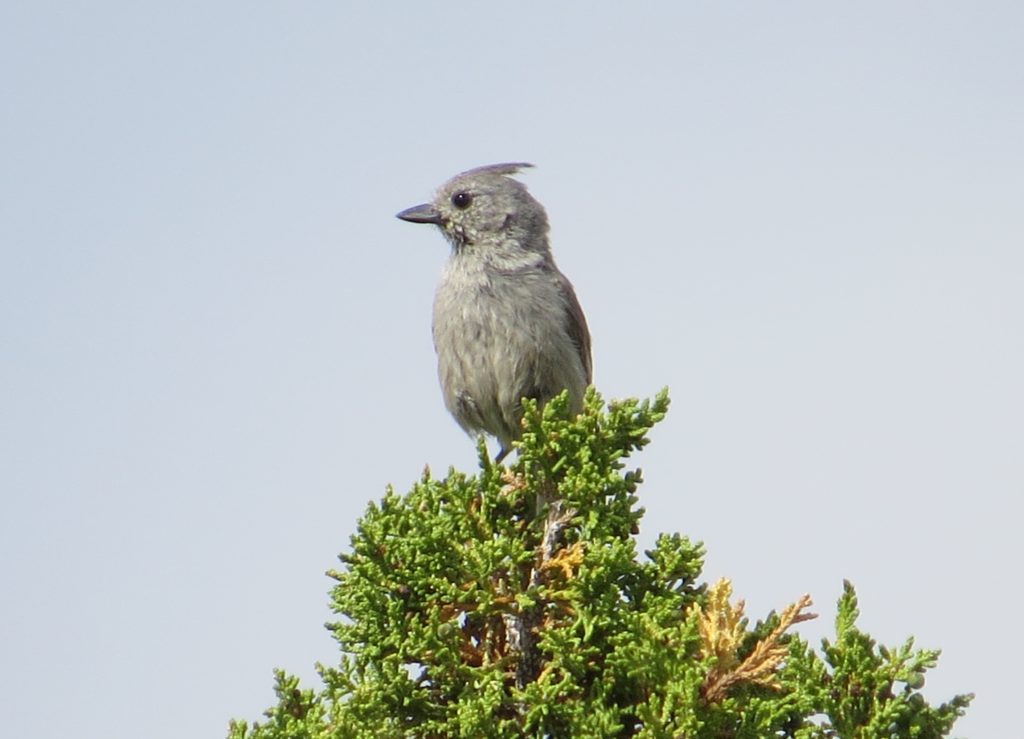 Tommy found me this bird while we were stopped for a different lifer. As I had been driving I knew to be vigilant for Pinyon Jays. There were a couple times while cruising at highway speeds that I thought I saw blue-colored birds cross the highway, but with no shoulder on which to pull off, I couldn’t stop to check. All doubt was erased at one point, though, when several blue-colored birds were flying across the highway in groups. I found a spot to pull over and observe my lifer Pinyon Jay. Photographing them proved impossible as the birds were between me and the sun. They also hid remarkably well in the junipers, only giving away there presence as they flushed away. This happened over and over as we probably saw over 50 in all, flushing in small groups. It was frustrating but still fun to see the behavior of this bird and hear its fun, laughing call.
Tommy found me this bird while we were stopped for a different lifer. As I had been driving I knew to be vigilant for Pinyon Jays. There were a couple times while cruising at highway speeds that I thought I saw blue-colored birds cross the highway, but with no shoulder on which to pull off, I couldn’t stop to check. All doubt was erased at one point, though, when several blue-colored birds were flying across the highway in groups. I found a spot to pull over and observe my lifer Pinyon Jay. Photographing them proved impossible as the birds were between me and the sun. They also hid remarkably well in the junipers, only giving away there presence as they flushed away. This happened over and over as we probably saw over 50 in all, flushing in small groups. It was frustrating but still fun to see the behavior of this bird and hear its fun, laughing call.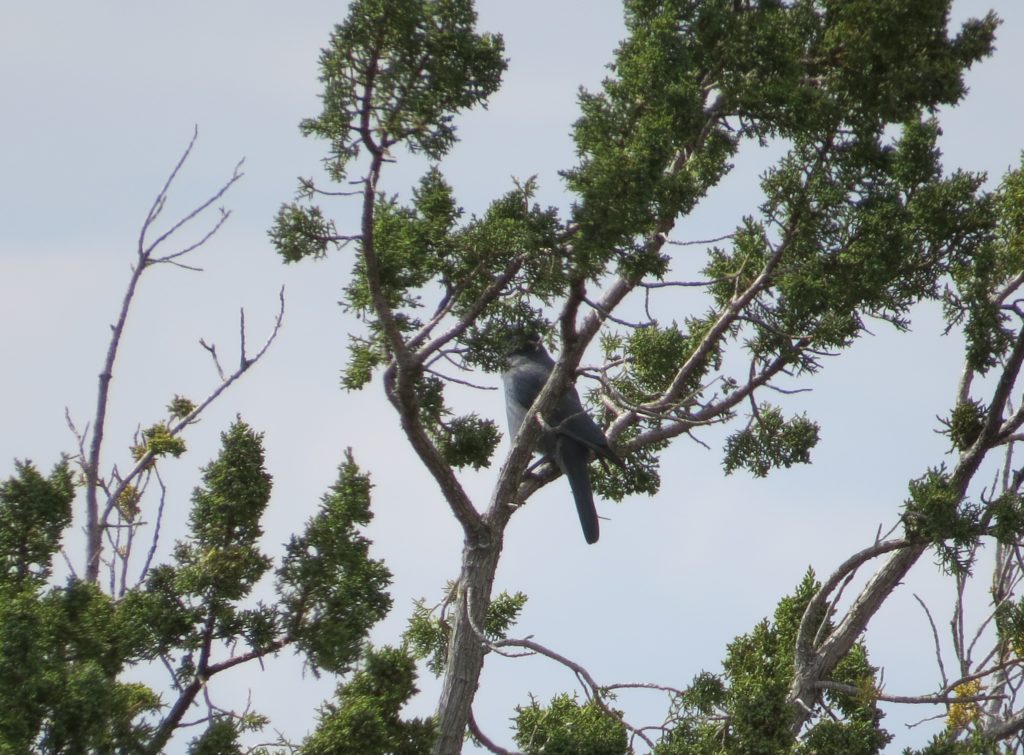
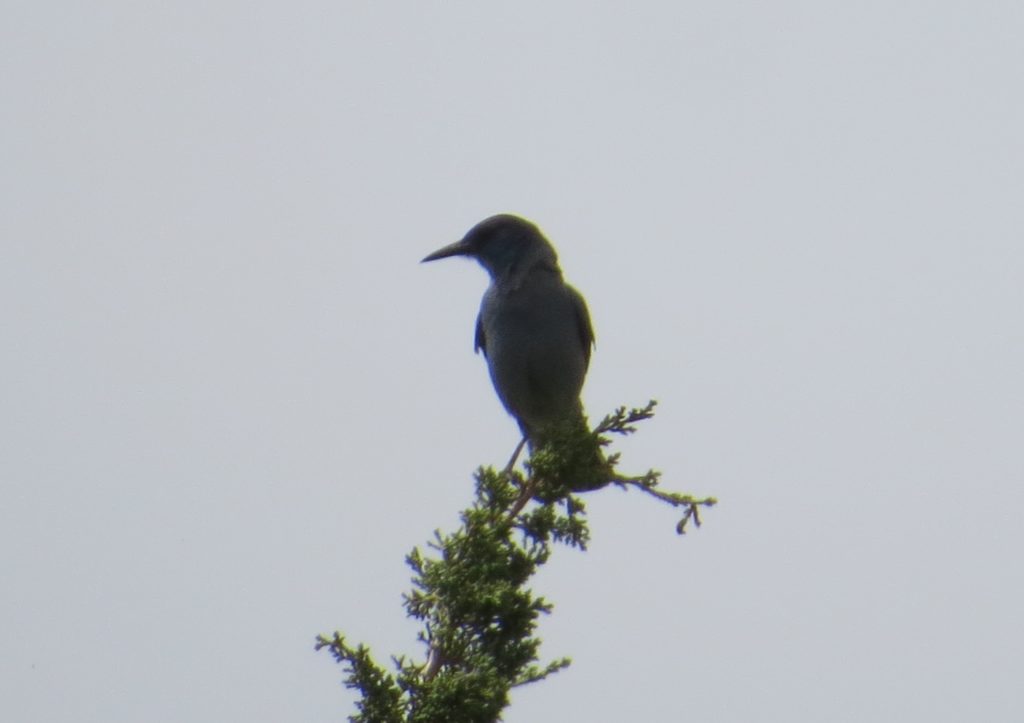 The morning after the Grand Canyon adventure, Tommy and I birded the Flagstaff area hitting up Elden Springs Road and the Schultz Pass Road. The birding was incredible, but since this is just a lifer post, we’ll stick to those. The first lifer was the Grace’s Warbler, a striking bird that loves the Pines.
The morning after the Grand Canyon adventure, Tommy and I birded the Flagstaff area hitting up Elden Springs Road and the Schultz Pass Road. The birding was incredible, but since this is just a lifer post, we’ll stick to those. The first lifer was the Grace’s Warbler, a striking bird that loves the Pines.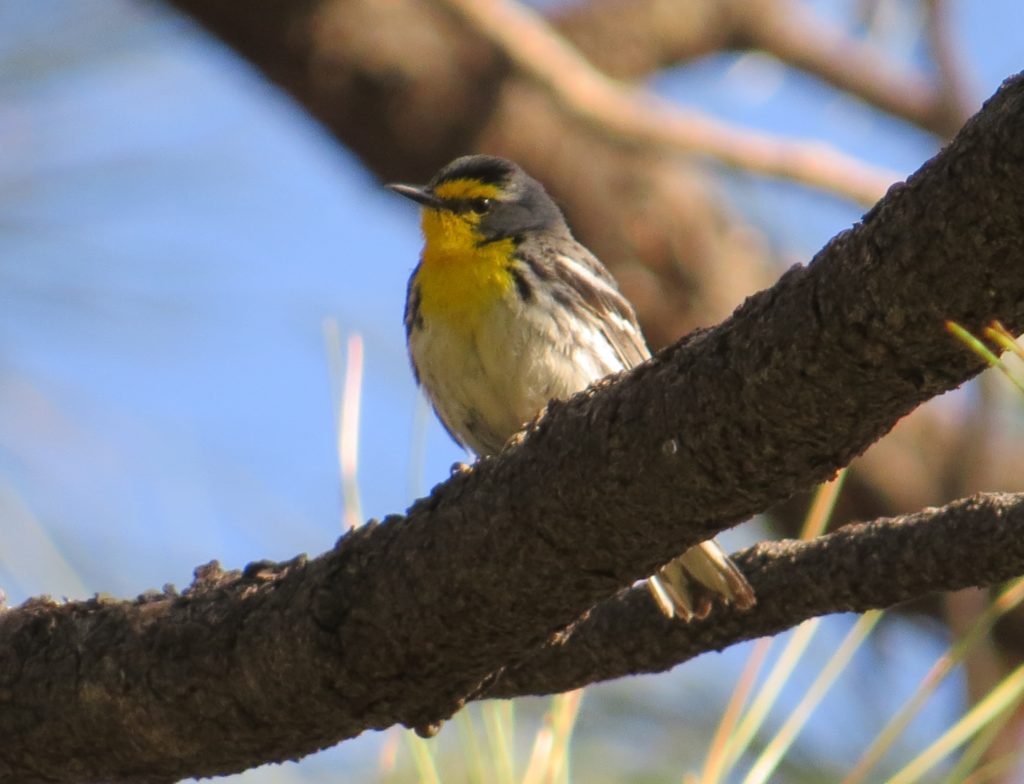
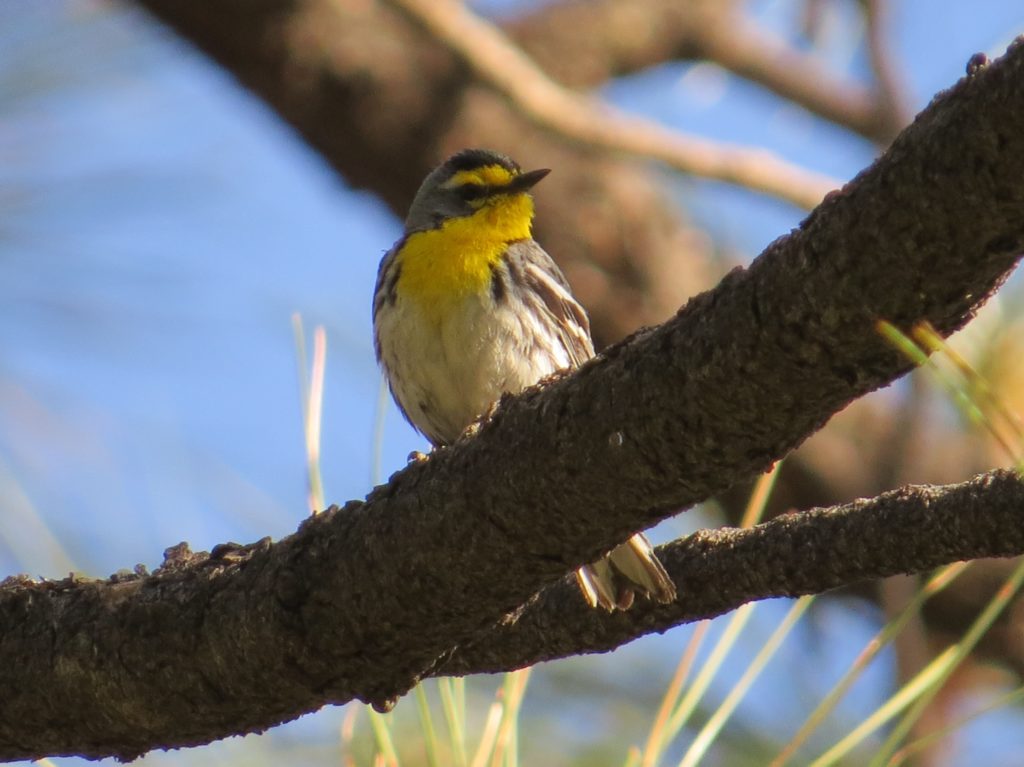 While lifering on this bird, I simultaneously lifered on Plumbeous Vireo. This is another bird that loves life in the Pines. Both my new lifers could be heard and seen at the same time, sometimes even in the same tree!
While lifering on this bird, I simultaneously lifered on Plumbeous Vireo. This is another bird that loves life in the Pines. Both my new lifers could be heard and seen at the same time, sometimes even in the same tree!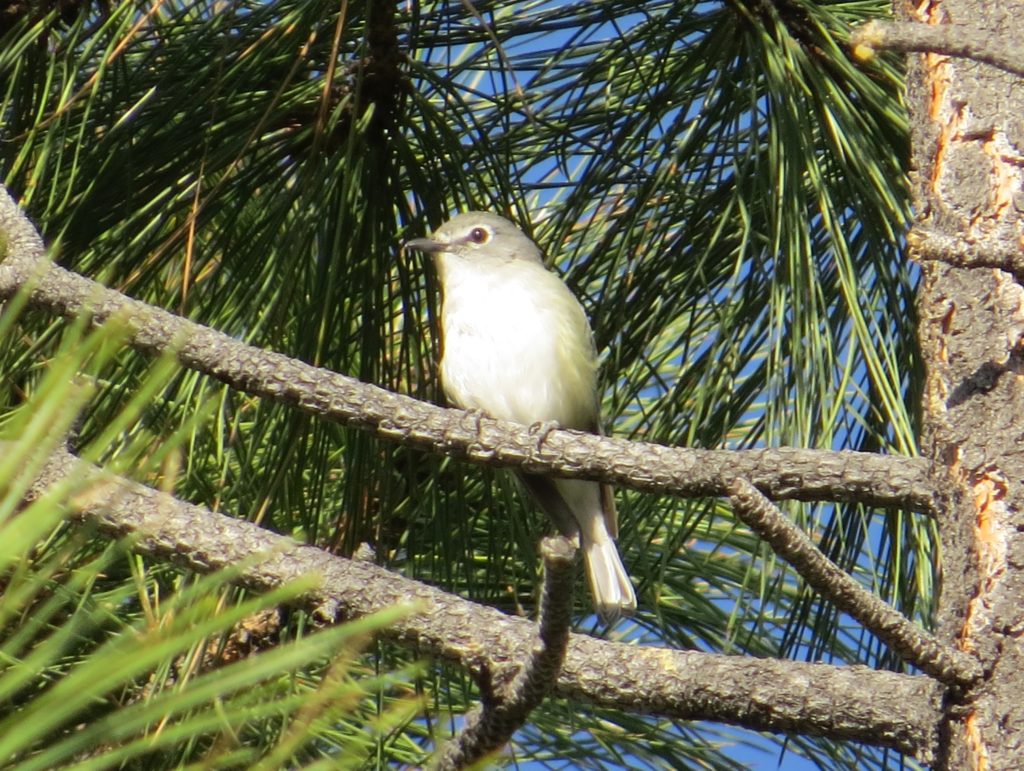
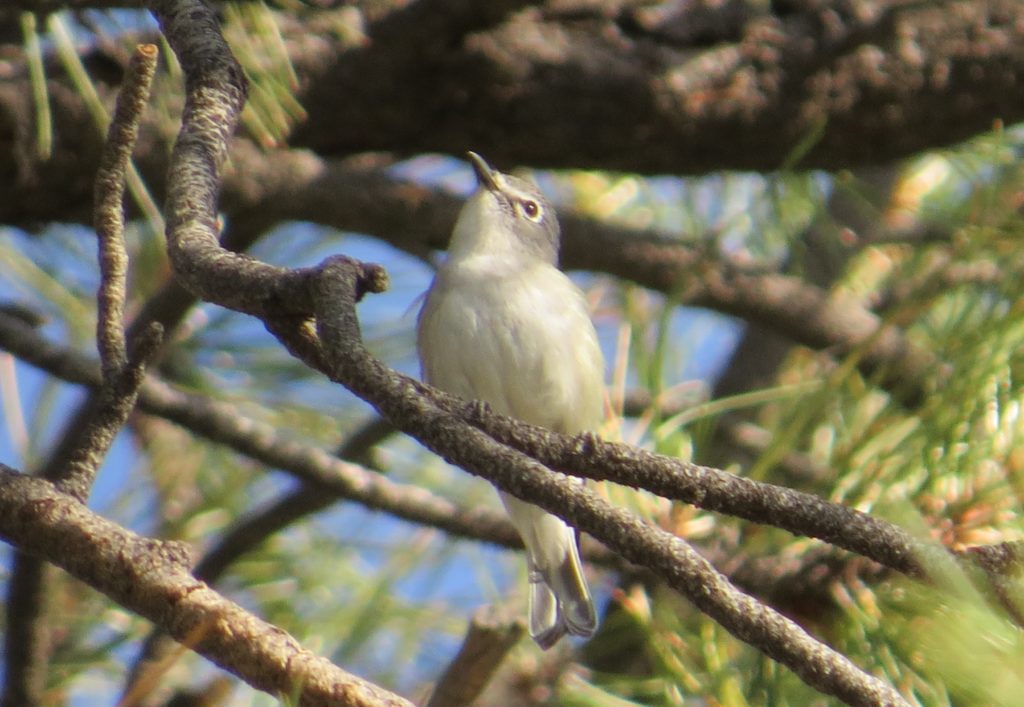 Elden Springs Road merges on to Schultz Pass Road, which was a reported location of numerous individuals of the bird I wanted to see most, the Red-faced Warbler. Tommy had me stop at a spot that looked like good habitat for this warbler–dense stands of Douglas Fir on a slope next to a somewhat open area of Aspens. Sure enough, Tommy picked out a singing Red-faced Warbler almost immediately. As we were trying to get visuals on it, Tommy spotted another lifer for me and one I had been hoping for–a male Williamson’s Sapsucker! Even though the Red-faced Warbler was my most wanted bird after the Flam, we know that would be a relatively easy bird along Schultz Pass Road. Therefore, we ditched the Red-face we had been hearing in an effort to track down the dapper and somewhat elusive Sapsucker. It sure was a tease at first and not offering up much to view.
Elden Springs Road merges on to Schultz Pass Road, which was a reported location of numerous individuals of the bird I wanted to see most, the Red-faced Warbler. Tommy had me stop at a spot that looked like good habitat for this warbler–dense stands of Douglas Fir on a slope next to a somewhat open area of Aspens. Sure enough, Tommy picked out a singing Red-faced Warbler almost immediately. As we were trying to get visuals on it, Tommy spotted another lifer for me and one I had been hoping for–a male Williamson’s Sapsucker! Even though the Red-faced Warbler was my most wanted bird after the Flam, we know that would be a relatively easy bird along Schultz Pass Road. Therefore, we ditched the Red-face we had been hearing in an effort to track down the dapper and somewhat elusive Sapsucker. It sure was a tease at first and not offering up much to view.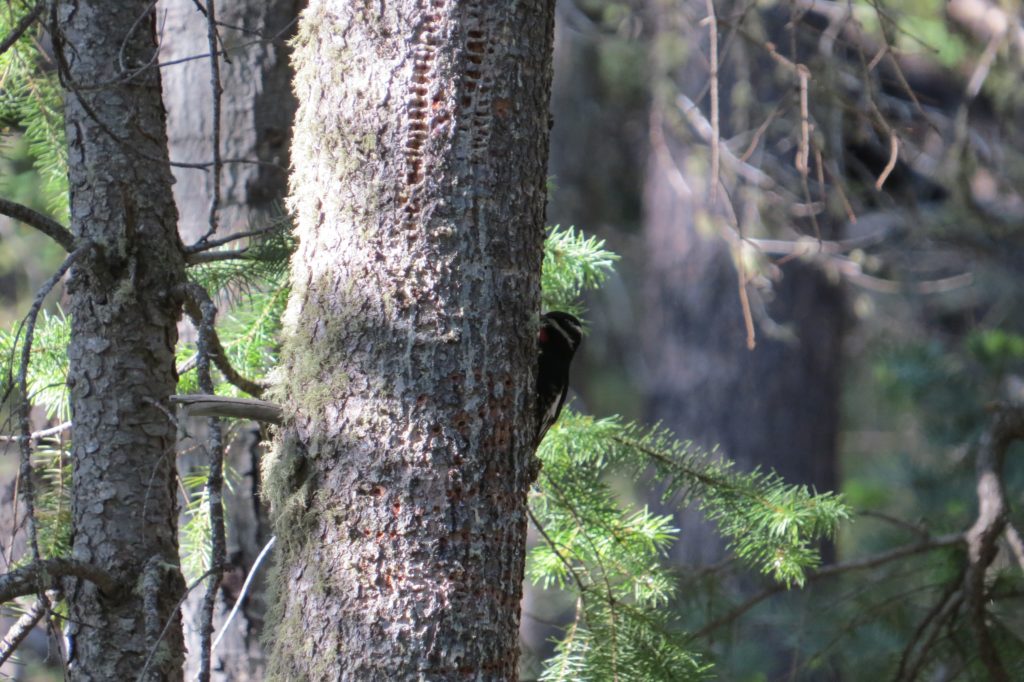 Eventually we got the full monty as it was too busy drilling sap wells to care about a couple of gawkers.
Eventually we got the full monty as it was too busy drilling sap wells to care about a couple of gawkers.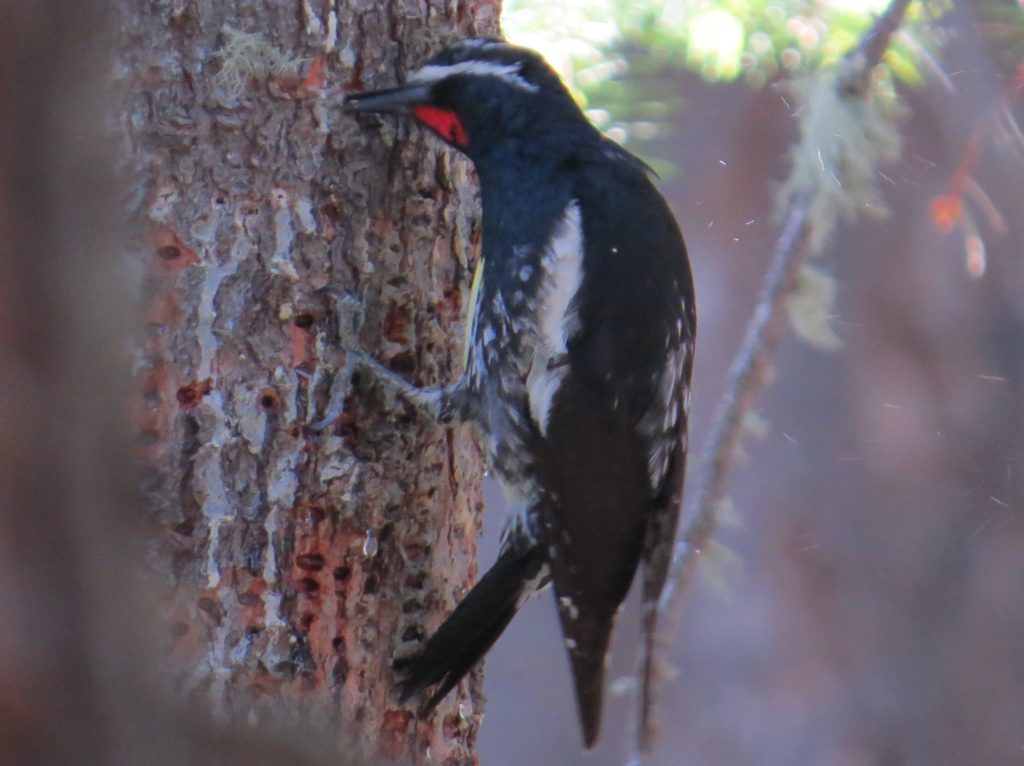
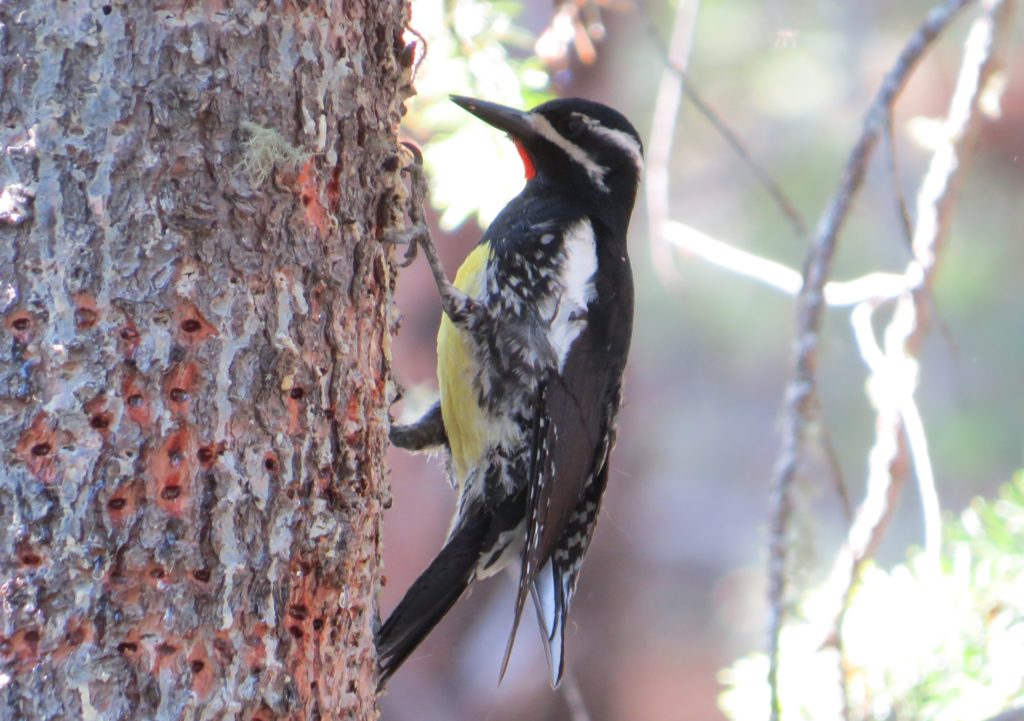 Once the Williamson’s was fully enjoyed, we turned our attention to the Red-faced Warbler. I was highly impatient to finally see this bird that we were hearing. And then it finally happened, and it was glorious.
Once the Williamson’s was fully enjoyed, we turned our attention to the Red-faced Warbler. I was highly impatient to finally see this bird that we were hearing. And then it finally happened, and it was glorious.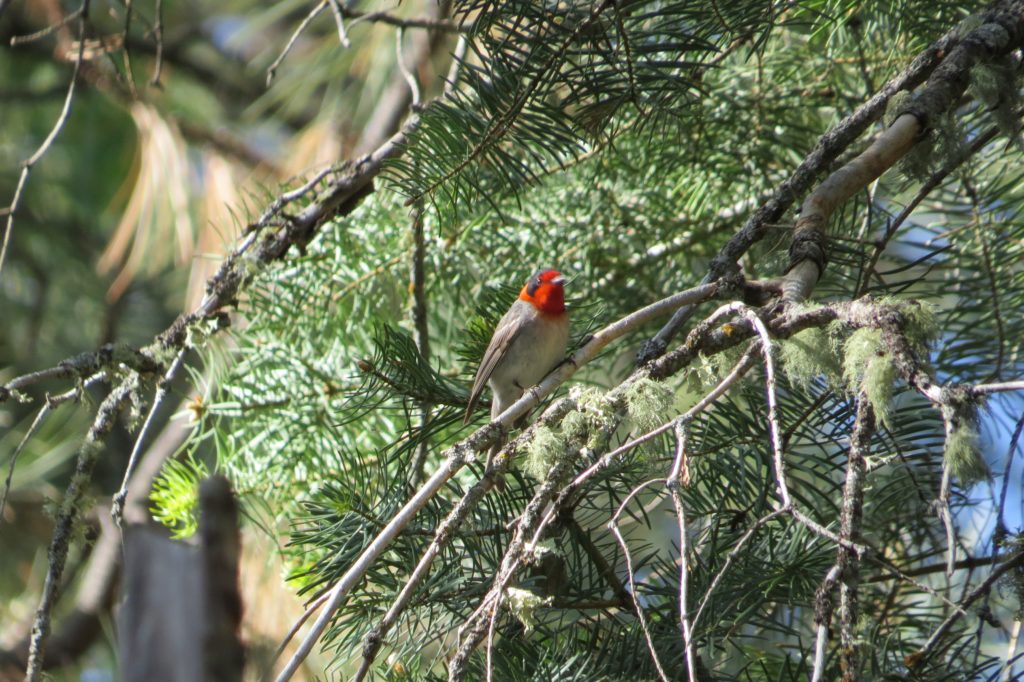 Adding to the pleasure of finally seeing this bird is that Red-faced Warblers are curious and therefore crushable.
Adding to the pleasure of finally seeing this bird is that Red-faced Warblers are curious and therefore crushable.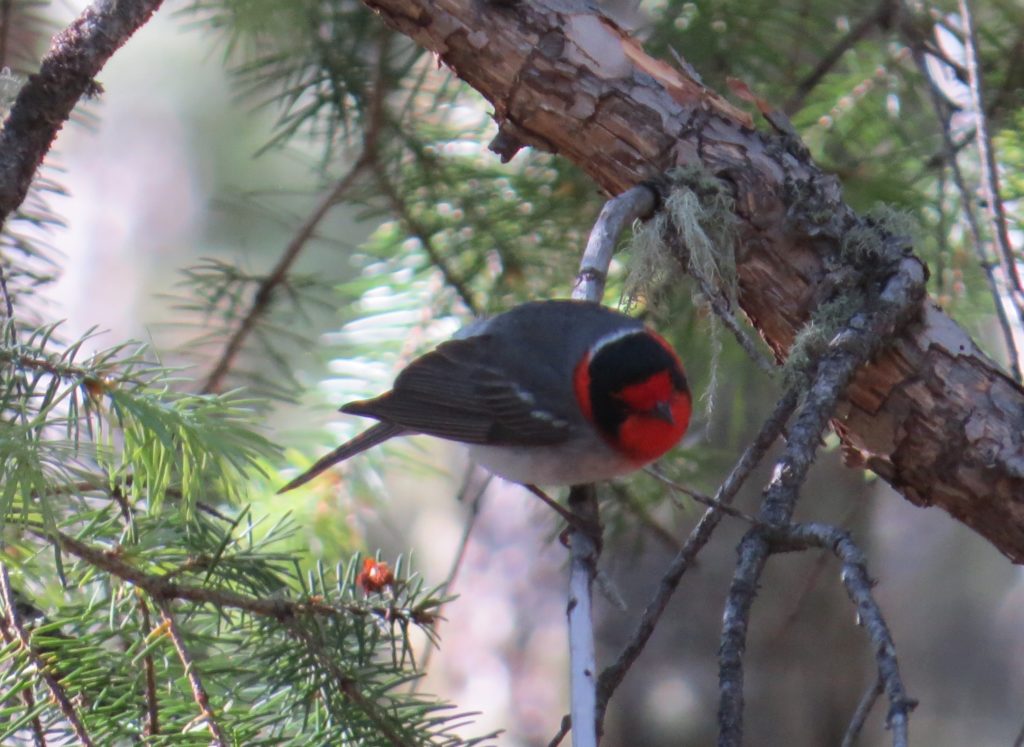
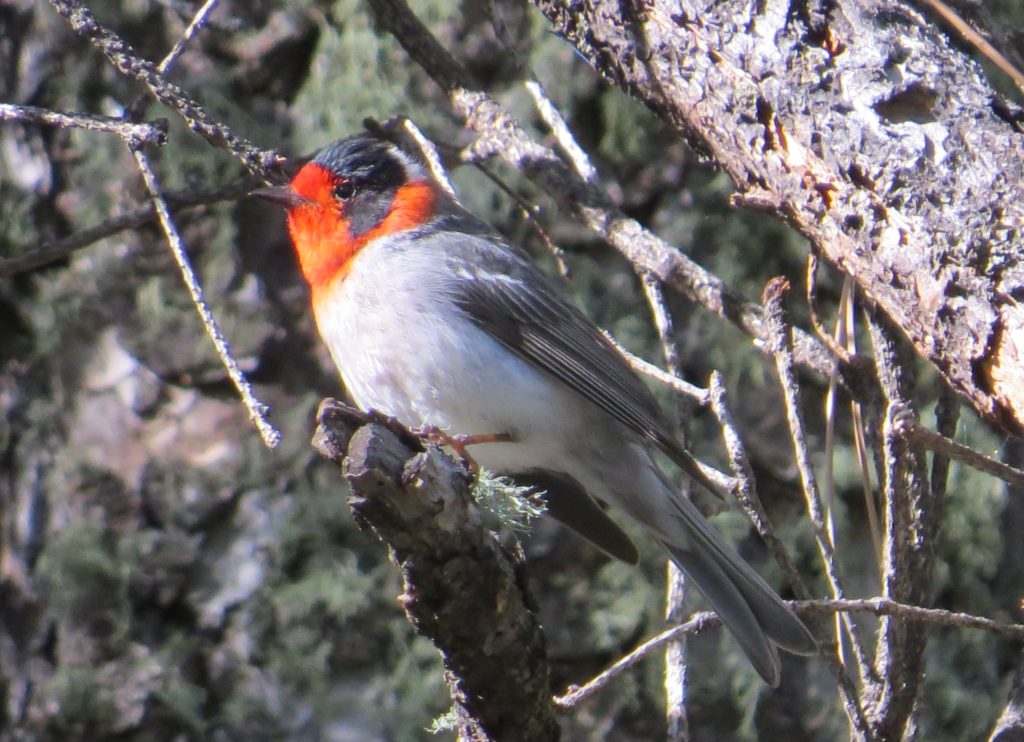
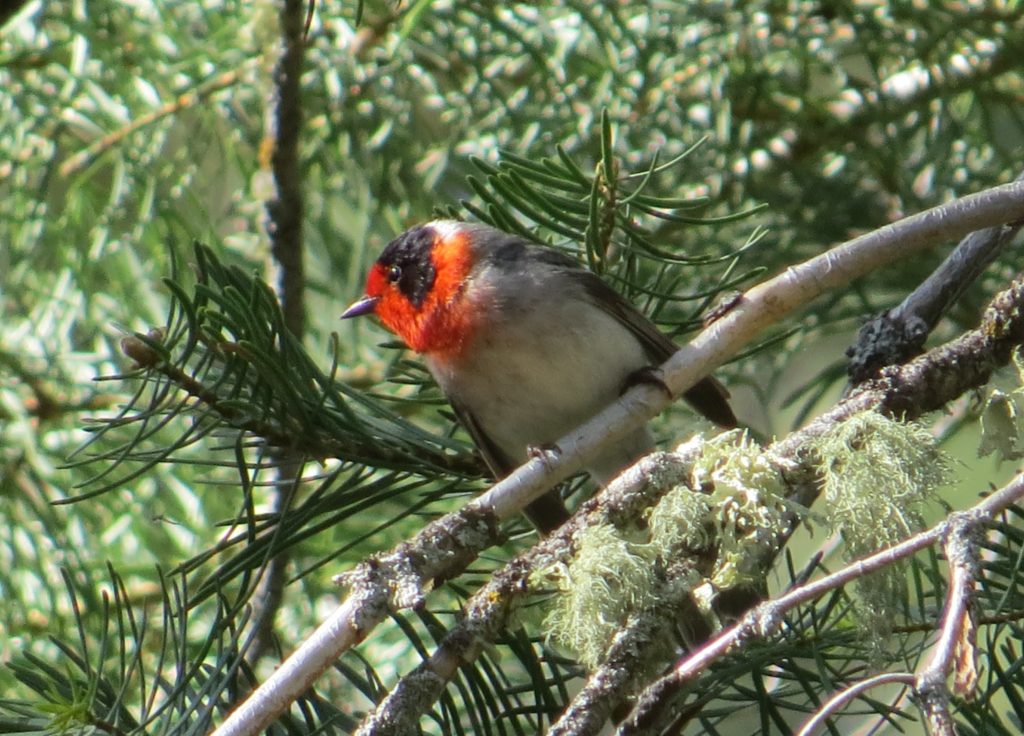 By the time we were done birding Schultz Pass Road, we had seen several of these Warblers. Each was just as exciting as the last. Even Tommy has to stop and look at each one, they are that captivating.
By the time we were done birding Schultz Pass Road, we had seen several of these Warblers. Each was just as exciting as the last. Even Tommy has to stop and look at each one, they are that captivating.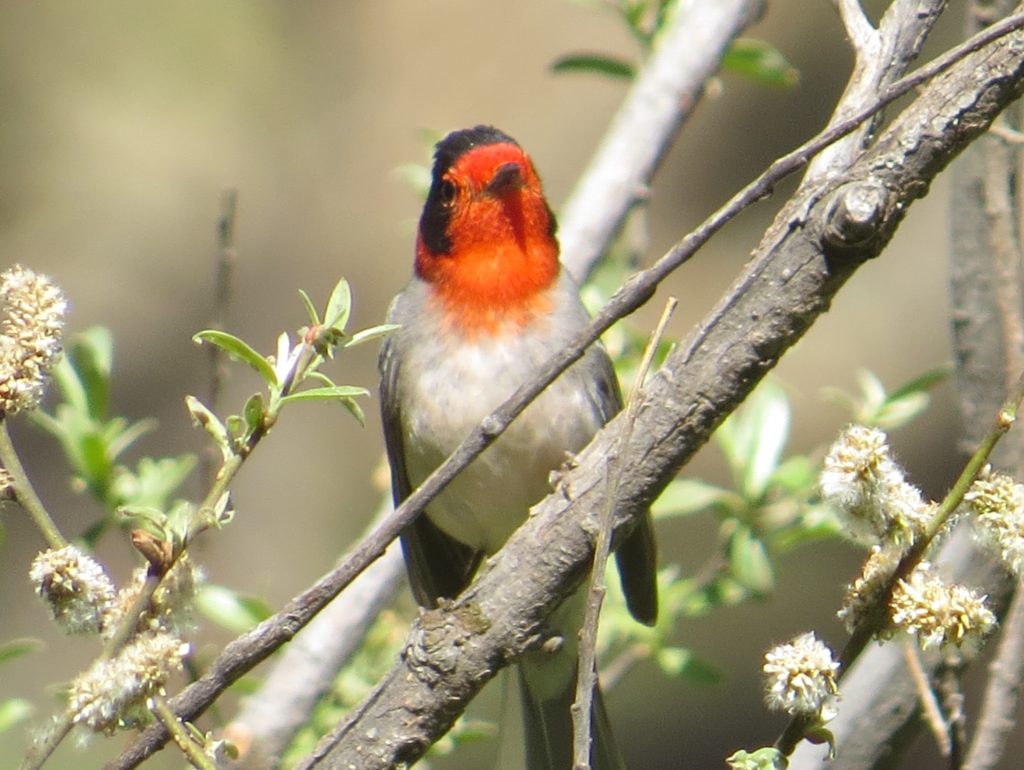 There were no more lifers on this morning of birding around Flagstaff. Tommy and I had found all my targets with relative ease, and there was really nothing left to go after. I’m kicking myself for not doing more research because MacGilivray’s Warblers breed in the area by Hart Prairie which is just northwest of Flagstaff. Oh well, something to add to my northern Arizona to-do list next time we come back to view the Grand Canyon (and the California Condors!)
There were no more lifers on this morning of birding around Flagstaff. Tommy and I had found all my targets with relative ease, and there was really nothing left to go after. I’m kicking myself for not doing more research because MacGilivray’s Warblers breed in the area by Hart Prairie which is just northwest of Flagstaff. Oh well, something to add to my northern Arizona to-do list next time we come back to view the Grand Canyon (and the California Condors!)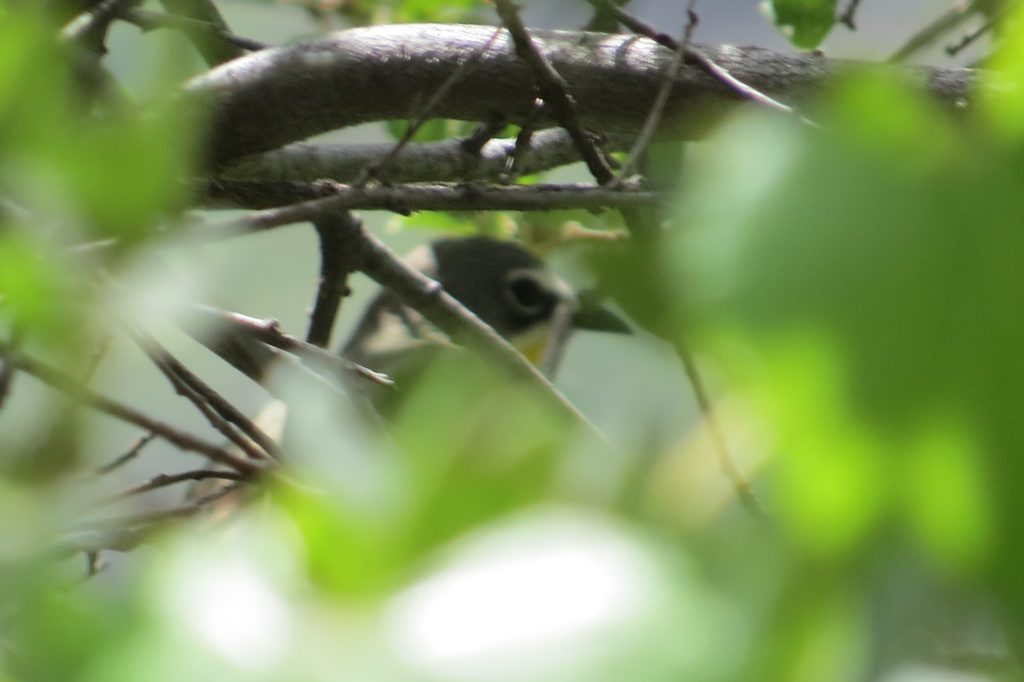 I’m not naive. I understand this is a typical experience with this bird species. It was still frustrating. At one point I could hear a Chat singing in the thicket right in front of me. I figured it had to be perched on top somewhere. So I climbed a rock, held the camera above my head, snapped a picture, and hoped for the best. Well, I got him. Can you see it?
I’m not naive. I understand this is a typical experience with this bird species. It was still frustrating. At one point I could hear a Chat singing in the thicket right in front of me. I figured it had to be perched on top somewhere. So I climbed a rock, held the camera above my head, snapped a picture, and hoped for the best. Well, I got him. Can you see it?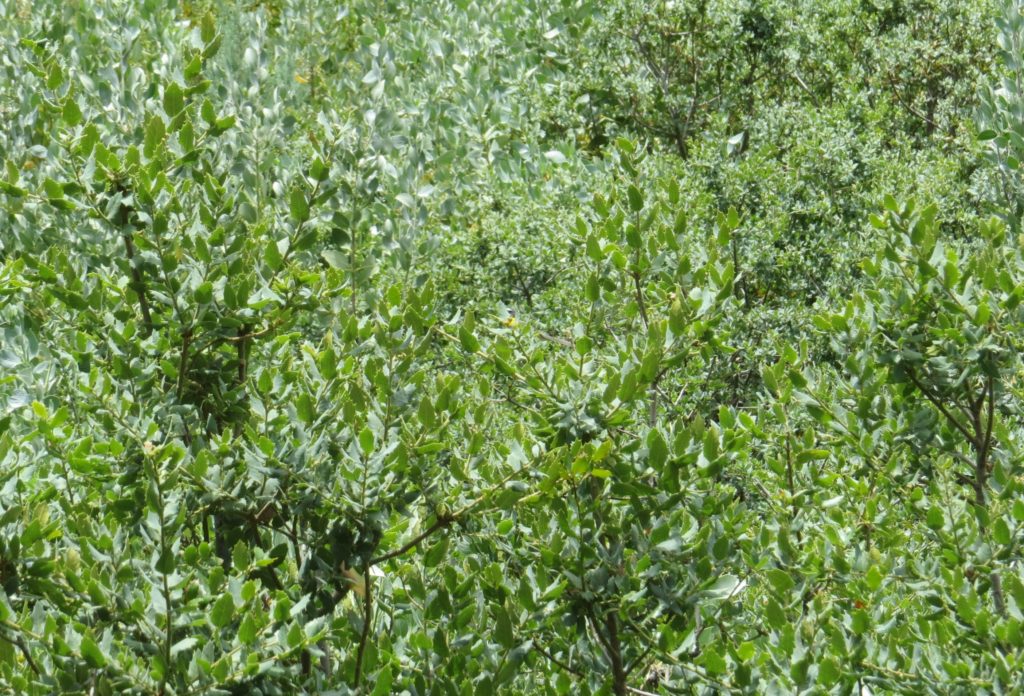 Here it is at a different perch. Same effect.
Here it is at a different perch. Same effect.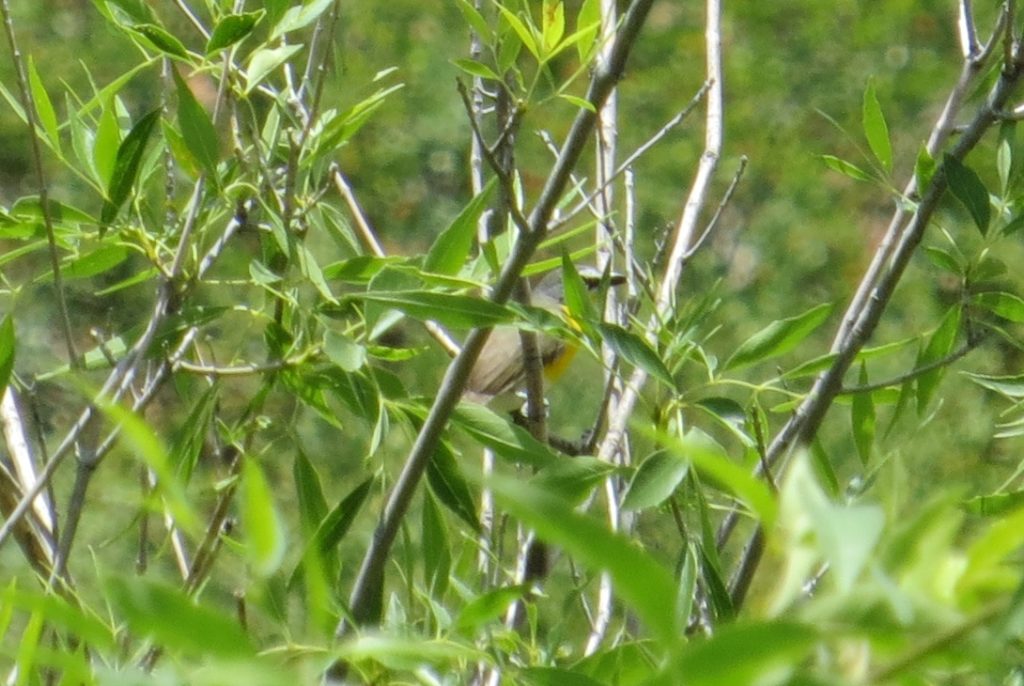 Yellow-breasted Chat is just one more bird to add to the list of ‘Better Looks Desired’ birds. At one point I saw a Chat fly into a tree in the distance, and I saw a fleck of yellow among the green leaves, so I just snapped photos of that yellow spot like crazy. Turns out I got a lot of photos of a yellow leaf instead. What an aggravating bird.
Yellow-breasted Chat is just one more bird to add to the list of ‘Better Looks Desired’ birds. At one point I saw a Chat fly into a tree in the distance, and I saw a fleck of yellow among the green leaves, so I just snapped photos of that yellow spot like crazy. Turns out I got a lot of photos of a yellow leaf instead. What an aggravating bird.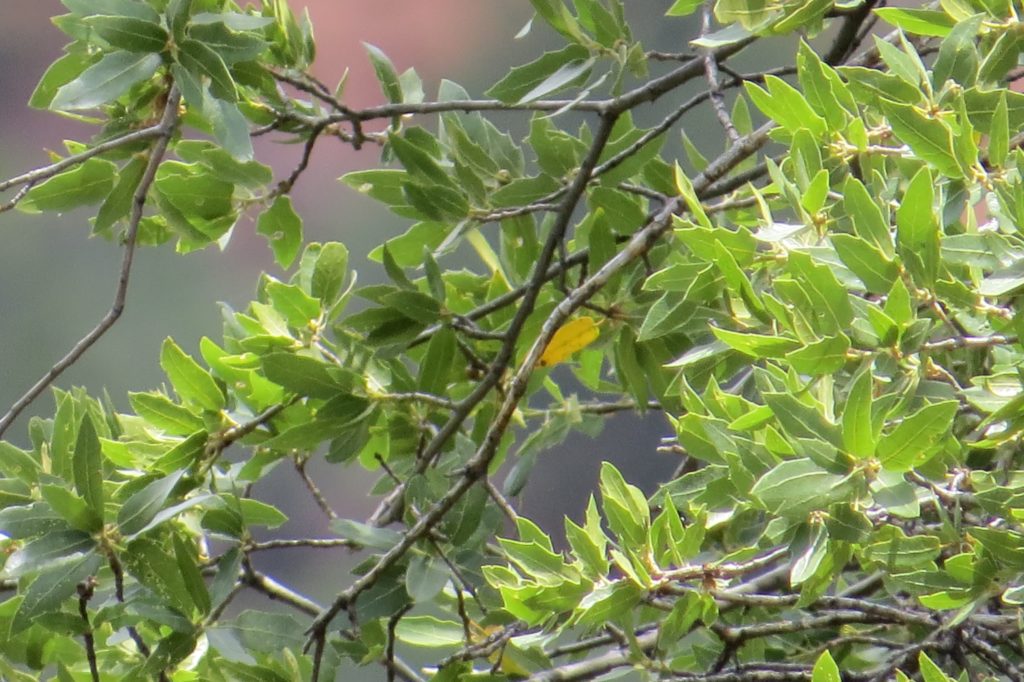 As we continued our drive to Sedona enjoying the views of the canyon walls from the bottom of Oak Creek Canyon, we decided to pull into the National Forest Service’s Grashopper Point recreation site. This was another fee area that we got into for free–thanks Evan. The draw of this site is that people like to cool off in Oak Creek here. More specifically, people cliff jump off a high rock face into a 15-foot wide creek below! Apparently this narrow creek is quite deep, allowing the people we saw jumping to come out unscathed. We did not attempt it. I was not completely sold on its safety.
As we continued our drive to Sedona enjoying the views of the canyon walls from the bottom of Oak Creek Canyon, we decided to pull into the National Forest Service’s Grashopper Point recreation site. This was another fee area that we got into for free–thanks Evan. The draw of this site is that people like to cool off in Oak Creek here. More specifically, people cliff jump off a high rock face into a 15-foot wide creek below! Apparently this narrow creek is quite deep, allowing the people we saw jumping to come out unscathed. We did not attempt it. I was not completely sold on its safety.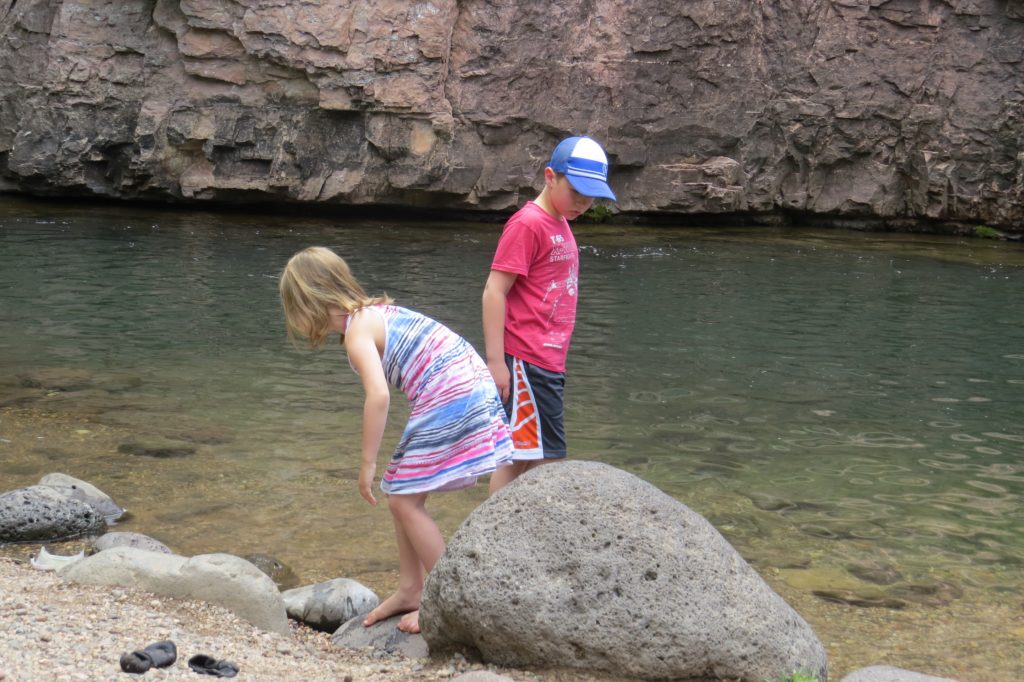 The deep part of the water is quite narrow as you can see the wading area takes up almost half the creek width. This spot where Evan and Marin are wading is where teenagers were jumping into the water from 15-20 feet up the rock face! As I kept an eye on my kids, I also kept an eye out for a Common Black-Hawk in the riparian corridor. Unfortunately one never materialized. I was also keeping an eye and an ear out for a family of Brown-crested Flycatchers that had been reported here. I had actually given up on them too, but seconds before we got in the car to leave I spied a silent flycatcher on top of a snag a long ways away. I snapped some photos and was pleasantly surprised to see I had captured my lifer Brown-crested Flycatcher!
The deep part of the water is quite narrow as you can see the wading area takes up almost half the creek width. This spot where Evan and Marin are wading is where teenagers were jumping into the water from 15-20 feet up the rock face! As I kept an eye on my kids, I also kept an eye out for a Common Black-Hawk in the riparian corridor. Unfortunately one never materialized. I was also keeping an eye and an ear out for a family of Brown-crested Flycatchers that had been reported here. I had actually given up on them too, but seconds before we got in the car to leave I spied a silent flycatcher on top of a snag a long ways away. I snapped some photos and was pleasantly surprised to see I had captured my lifer Brown-crested Flycatcher!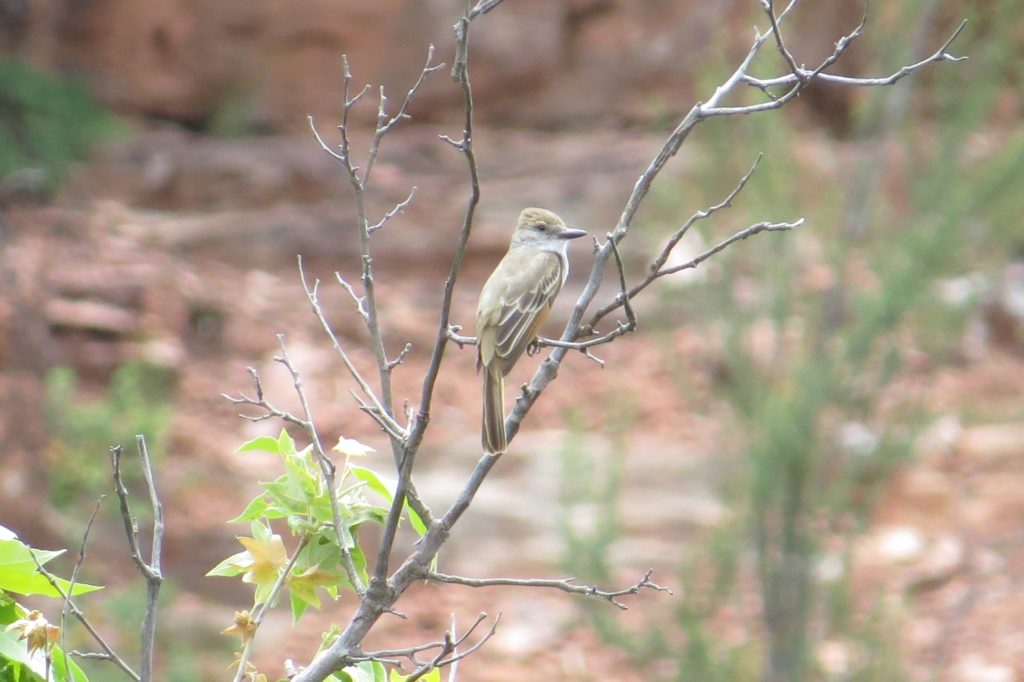 The Brown-crested Flycatcher is distinguished from the similar-looking Ash-throated Flycatcher which inhabits the same area by its larger bill, completely rufous tail underneath, and a brighter yellow belly. Thankfully, this Flycatcher turned around to make sure I could see all the appropriate field marks.
The Brown-crested Flycatcher is distinguished from the similar-looking Ash-throated Flycatcher which inhabits the same area by its larger bill, completely rufous tail underneath, and a brighter yellow belly. Thankfully, this Flycatcher turned around to make sure I could see all the appropriate field marks.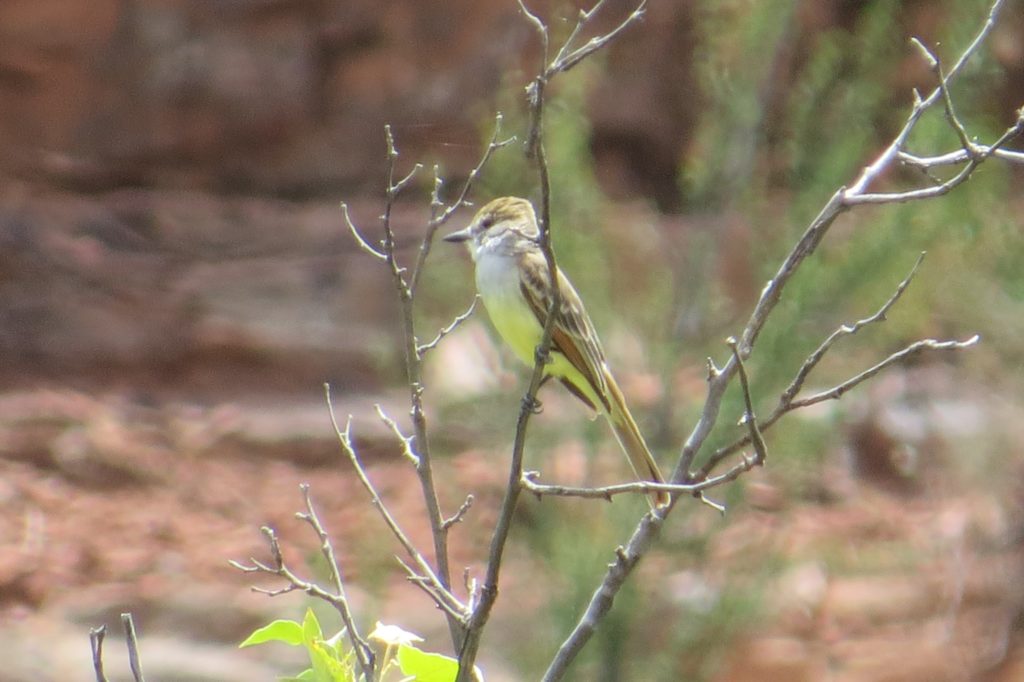 The lifering on this fifth trip to AZ was definitely a quality over quantity sort of thing. And unless I make a summer trip to SE AZ, the lifering will be significantly limited on subsequent trips to visit my parents in central AZ in the winter months. Regardless of lifers being available, good birds can ALWAYS be had in Arizona. In the next post, I’ll highlight my favorite non-lifers from this most recent trip.
The lifering on this fifth trip to AZ was definitely a quality over quantity sort of thing. And unless I make a summer trip to SE AZ, the lifering will be significantly limited on subsequent trips to visit my parents in central AZ in the winter months. Regardless of lifers being available, good birds can ALWAYS be had in Arizona. In the next post, I’ll highlight my favorite non-lifers from this most recent trip.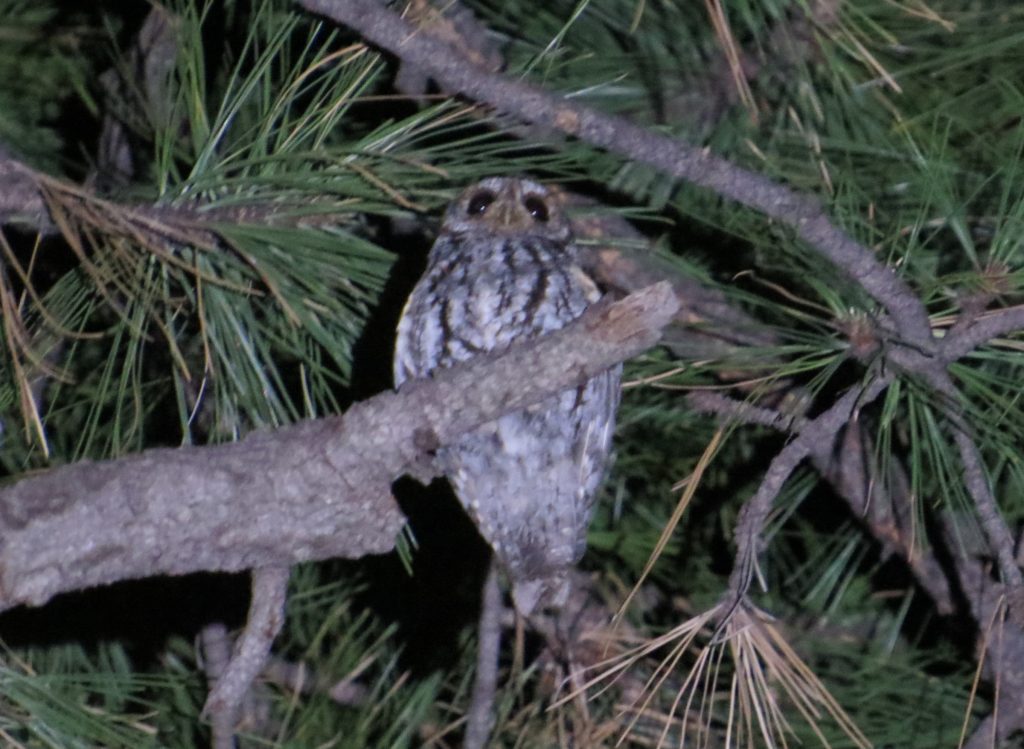
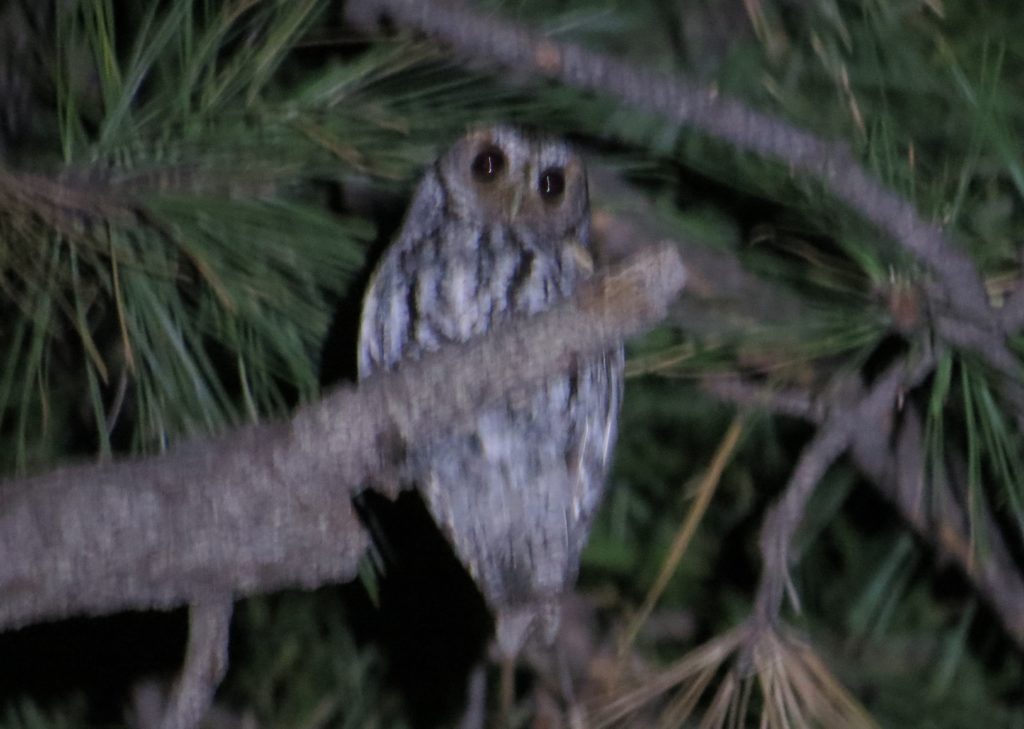
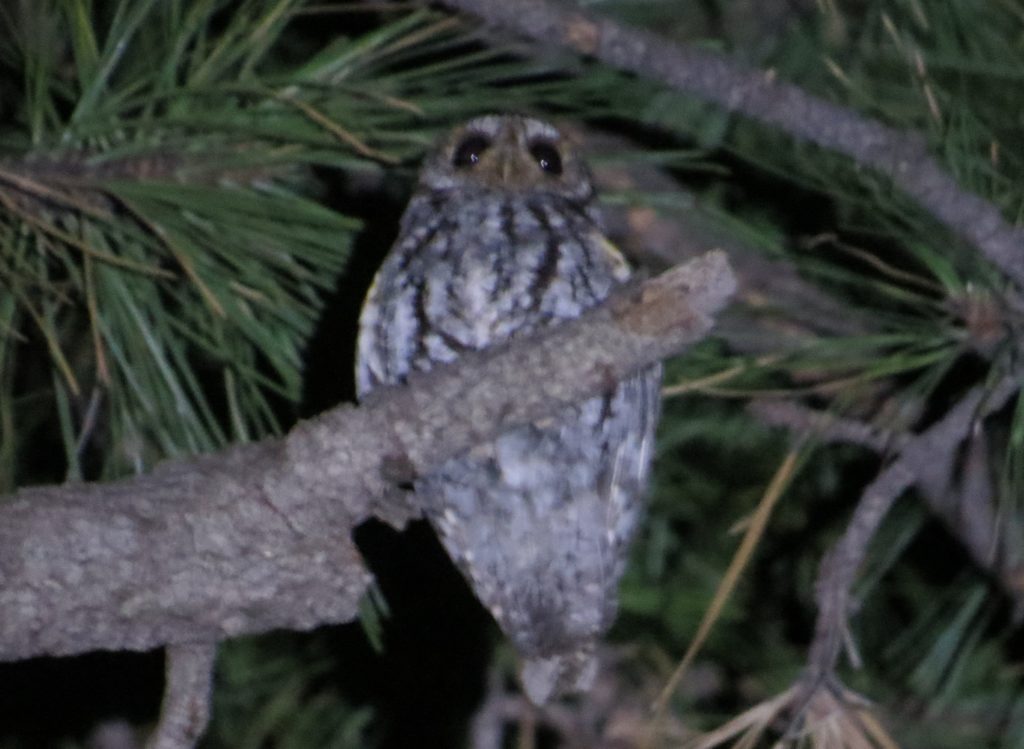
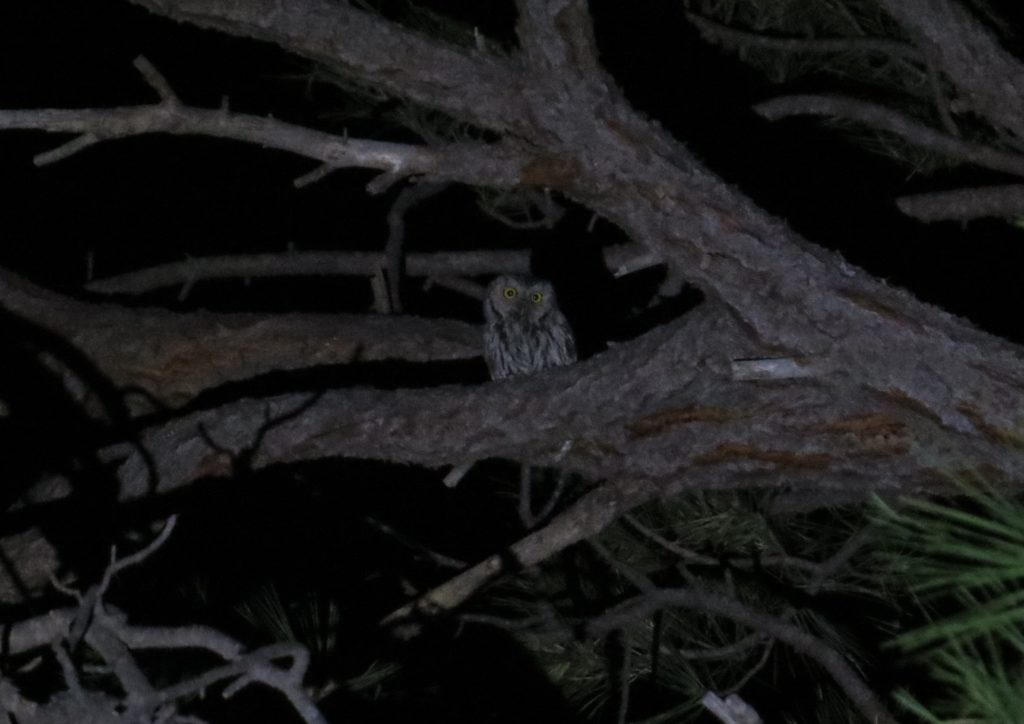
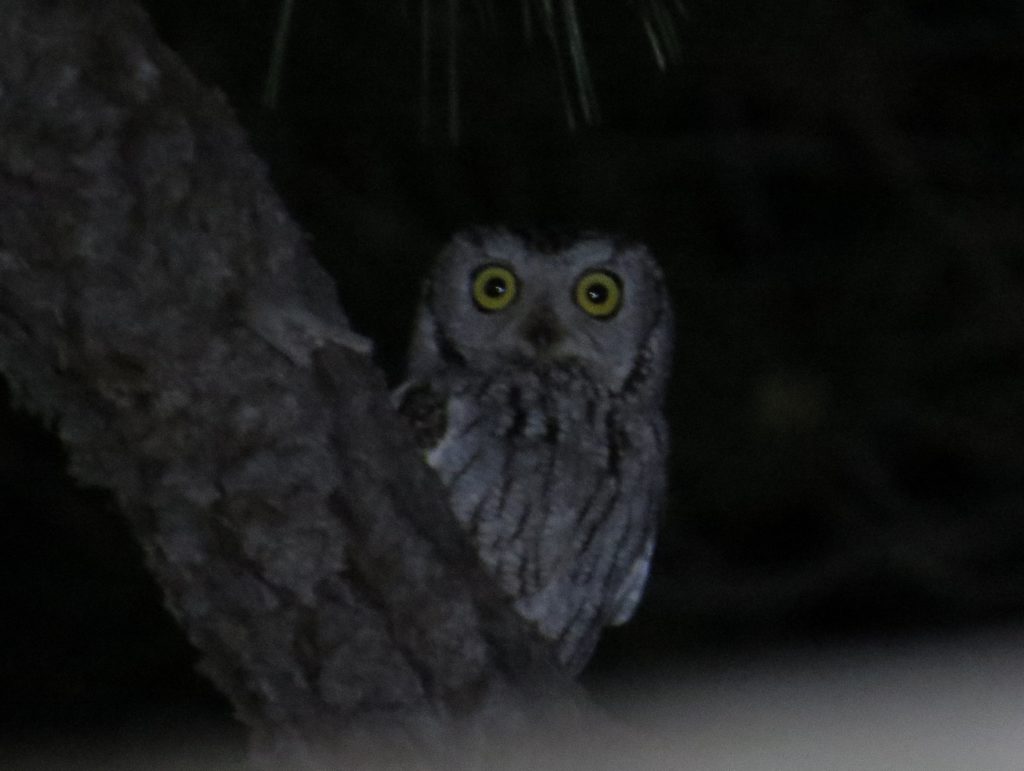 After the Screech-Owl fun, we kept up our search for Flams with no further sightings. A pair of dueting Great Horned Owls did give us a three-Owl night, however. With Flammulated Owl locked down and photo-documented as my 17th Owl lifer, the trip was a huge success. A fun coincidence is that the Flam was Tommy’s 17th Owl species for TOBY. I can’t thank Tommy enough for all the Owl species he has shown me (7 in all!). The next day we celebrated in a most appropriate way–eating at the Toasted Owl Cafe right by our resort in Flagstaff. It’s very good, by the way.
After the Screech-Owl fun, we kept up our search for Flams with no further sightings. A pair of dueting Great Horned Owls did give us a three-Owl night, however. With Flammulated Owl locked down and photo-documented as my 17th Owl lifer, the trip was a huge success. A fun coincidence is that the Flam was Tommy’s 17th Owl species for TOBY. I can’t thank Tommy enough for all the Owl species he has shown me (7 in all!). The next day we celebrated in a most appropriate way–eating at the Toasted Owl Cafe right by our resort in Flagstaff. It’s very good, by the way.
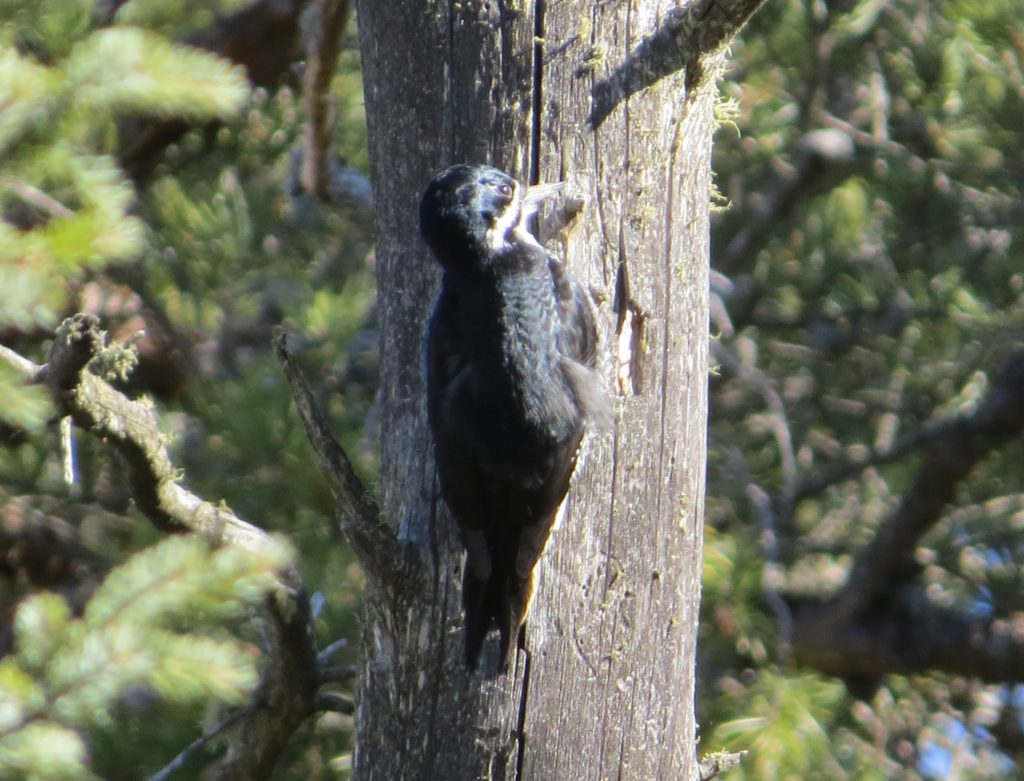 We carried on with our walk that had us traversing the same stretch of road several times. Then we heard drumming quite a ways from the Black-backed and knew it was a different bird. We repeated the drill of tracking down the source. Only this time it was different. John was the first one to get eyes on it and announced it was the American Three-toed Woodpecker and the male at that!
We carried on with our walk that had us traversing the same stretch of road several times. Then we heard drumming quite a ways from the Black-backed and knew it was a different bird. We repeated the drill of tracking down the source. Only this time it was different. John was the first one to get eyes on it and announced it was the American Three-toed Woodpecker and the male at that!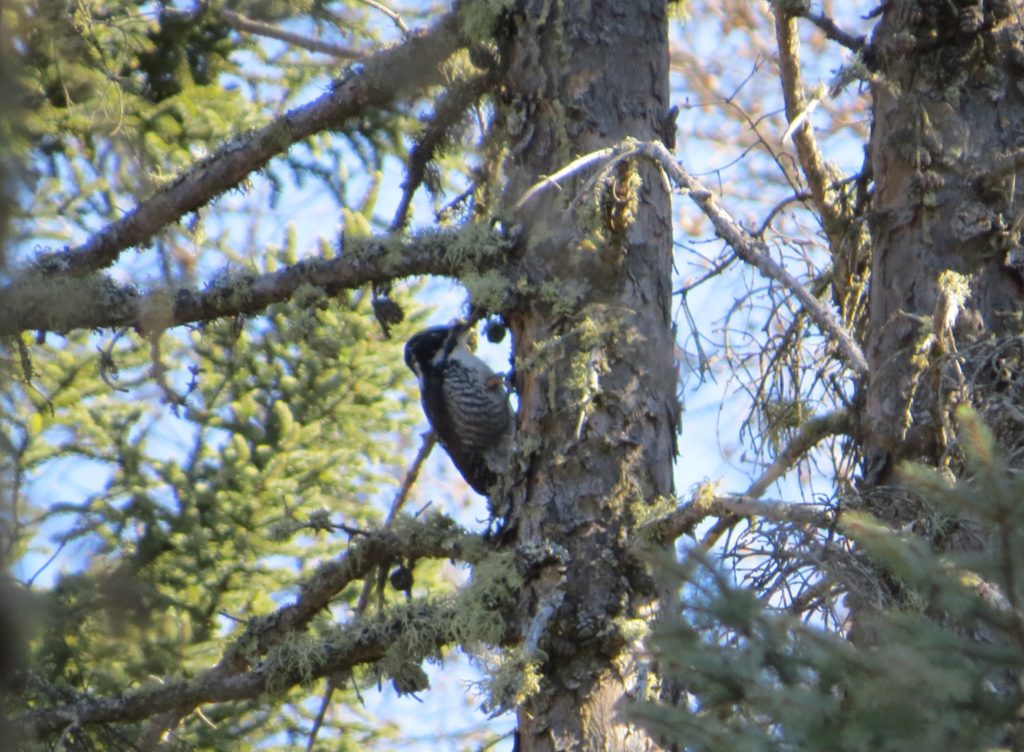 It was a huge lifer for me–there are only a handful of regular birds in Minnesota I can still add to my life list, and the icing on the cake was that this was a hometown bird. It really doesn’t get better than that, and I spent a lot of time soaking up the experience and taking lots of photos.
It was a huge lifer for me–there are only a handful of regular birds in Minnesota I can still add to my life list, and the icing on the cake was that this was a hometown bird. It really doesn’t get better than that, and I spent a lot of time soaking up the experience and taking lots of photos.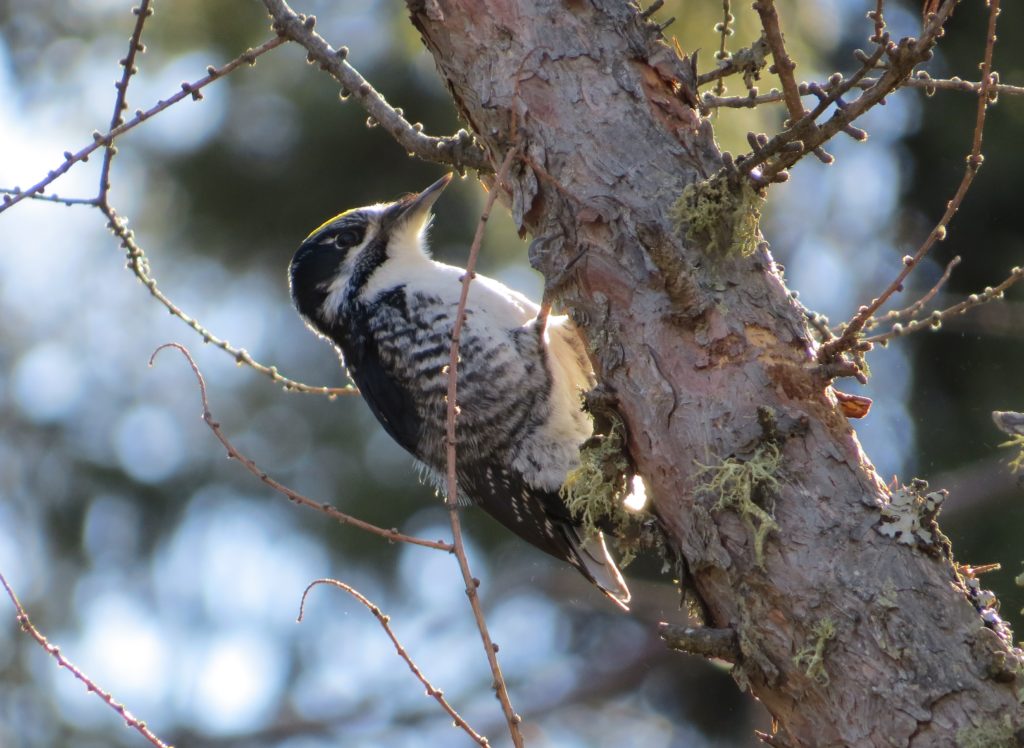
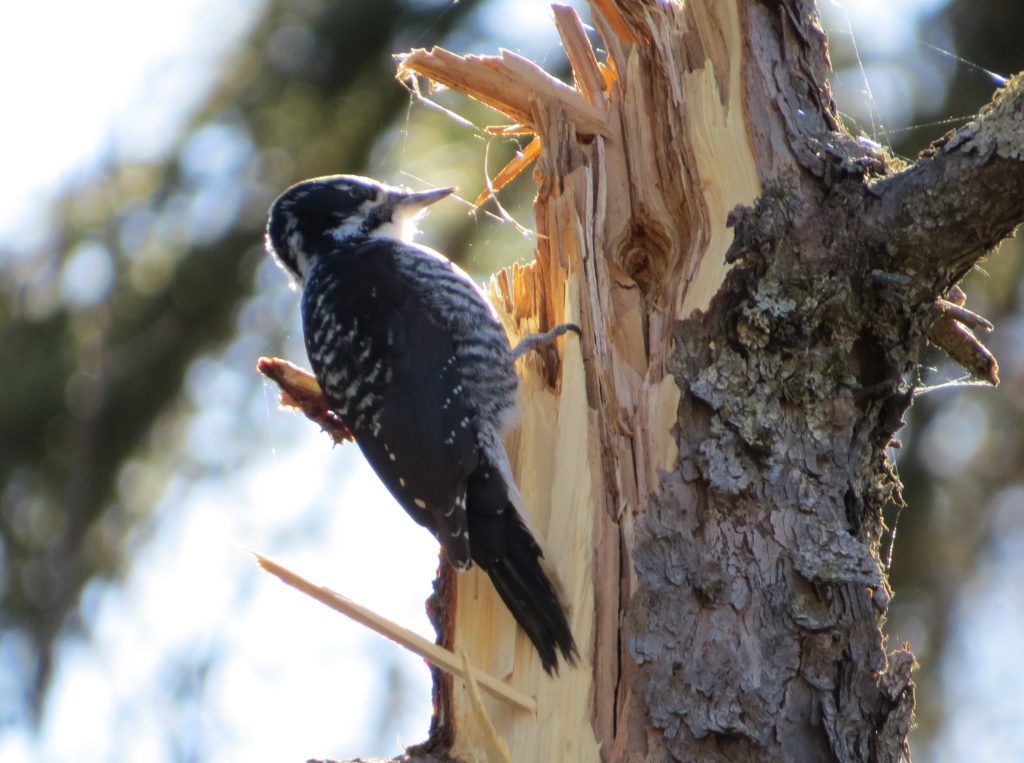 At one point this Woodpecker flew down and worked the bark along a downed tree. This bird was oblivious to my presence and let me approach within 5 feet as it frantically flaked bark to look for insects.
At one point this Woodpecker flew down and worked the bark along a downed tree. This bird was oblivious to my presence and let me approach within 5 feet as it frantically flaked bark to look for insects.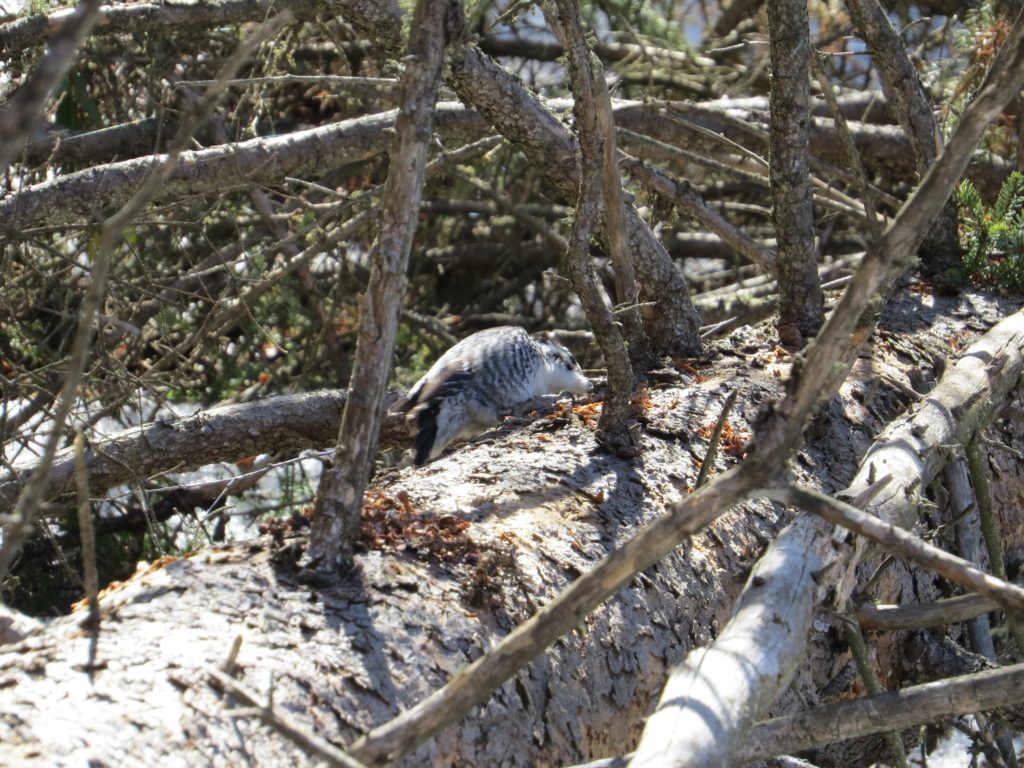
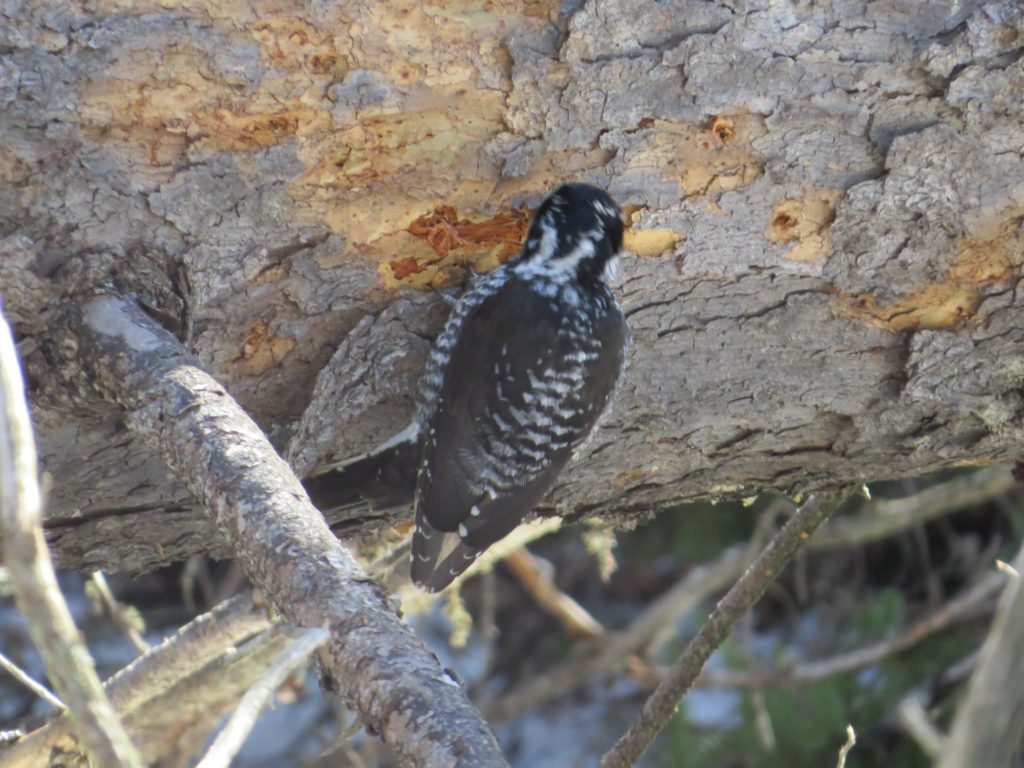
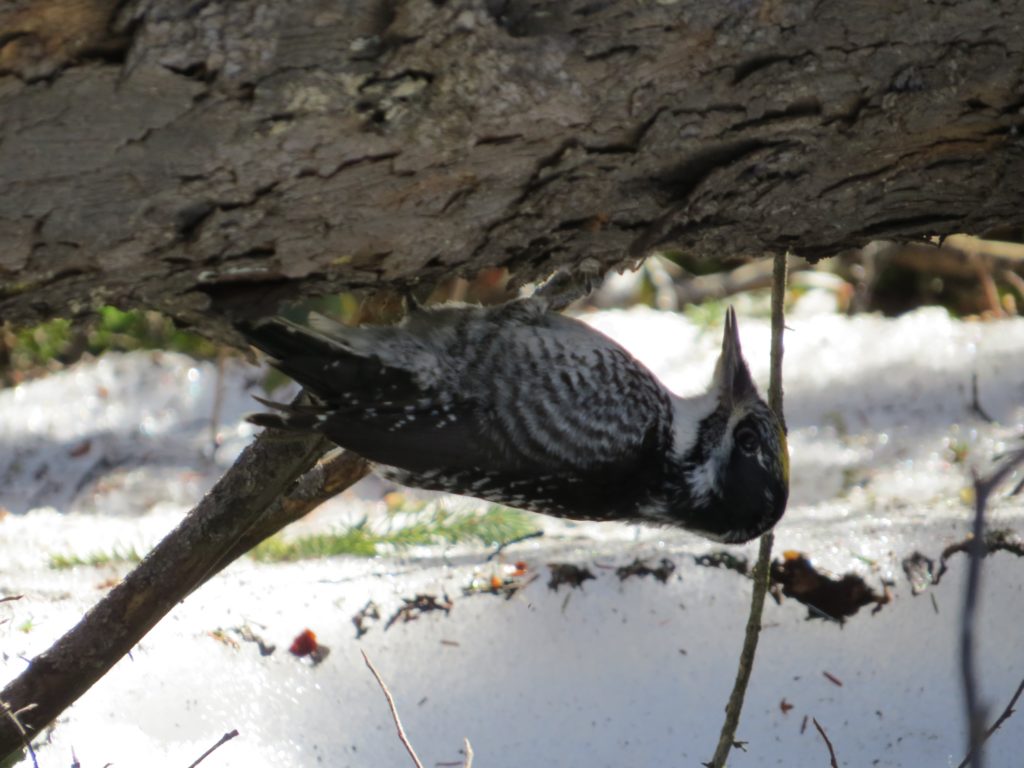
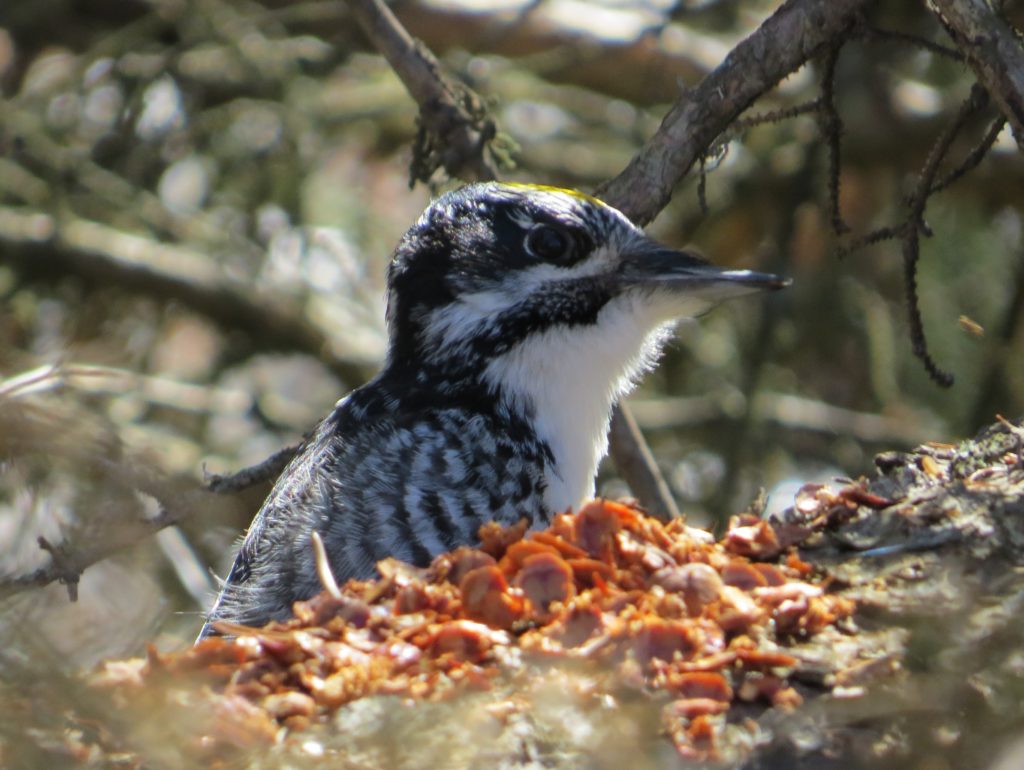 It was a beautiful day to be birding back home and enjoying a long-awaited lifer. John had gotten his fill long ago and left. Julie was quite patient as I spent an inordinate amount of time photographing this incredibly accommodating bird.
It was a beautiful day to be birding back home and enjoying a long-awaited lifer. John had gotten his fill long ago and left. Julie was quite patient as I spent an inordinate amount of time photographing this incredibly accommodating bird.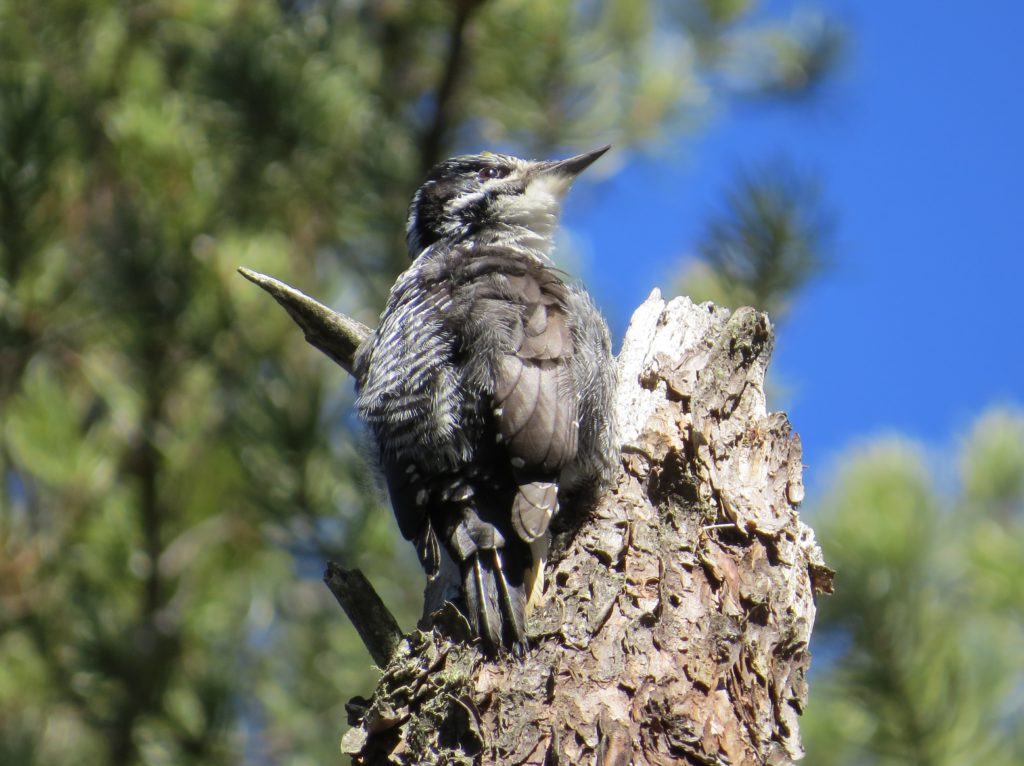 I did, finally, pry myself away and Julie and I wrapped up our birding for the day. However, I found myself back on this road the next morning because the allure of these Woodpeckers and the Spruce Grouse was just too strong. That second morning I decided to drive the stretch of road first with the windows down. Unlike the day before, the action started almost immediately. I heard the unmistakable rattle call of TWO Black-backed Woodpeckers that seemed to be chasing each other around in some sort of courtship dance. I got lucky enough to catch them on the same tree together.
I did, finally, pry myself away and Julie and I wrapped up our birding for the day. However, I found myself back on this road the next morning because the allure of these Woodpeckers and the Spruce Grouse was just too strong. That second morning I decided to drive the stretch of road first with the windows down. Unlike the day before, the action started almost immediately. I heard the unmistakable rattle call of TWO Black-backed Woodpeckers that seemed to be chasing each other around in some sort of courtship dance. I got lucky enough to catch them on the same tree together.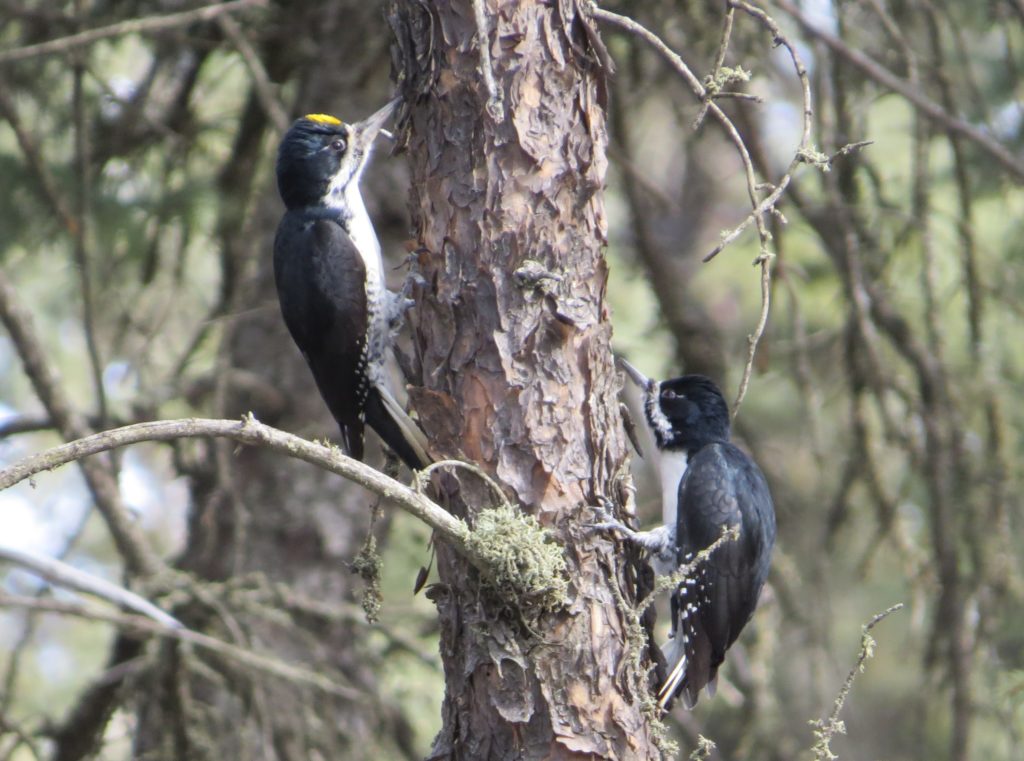 Then all craziness broke loose (as if it hadn’t already). There were now four Woodpeckers chasing each other around. As I tried to make sense of it all, another unexpected sighting happened–Sparky Stensaas came bursting out of the woods with a large camera and tripod in hot pursuit of this action. All of this action was just nuts. I started photographing two Woodpeckers on a dead snag and realized I had the male Black-backed and male Three-toed together on the same tree!
Then all craziness broke loose (as if it hadn’t already). There were now four Woodpeckers chasing each other around. As I tried to make sense of it all, another unexpected sighting happened–Sparky Stensaas came bursting out of the woods with a large camera and tripod in hot pursuit of this action. All of this action was just nuts. I started photographing two Woodpeckers on a dead snag and realized I had the male Black-backed and male Three-toed together on the same tree!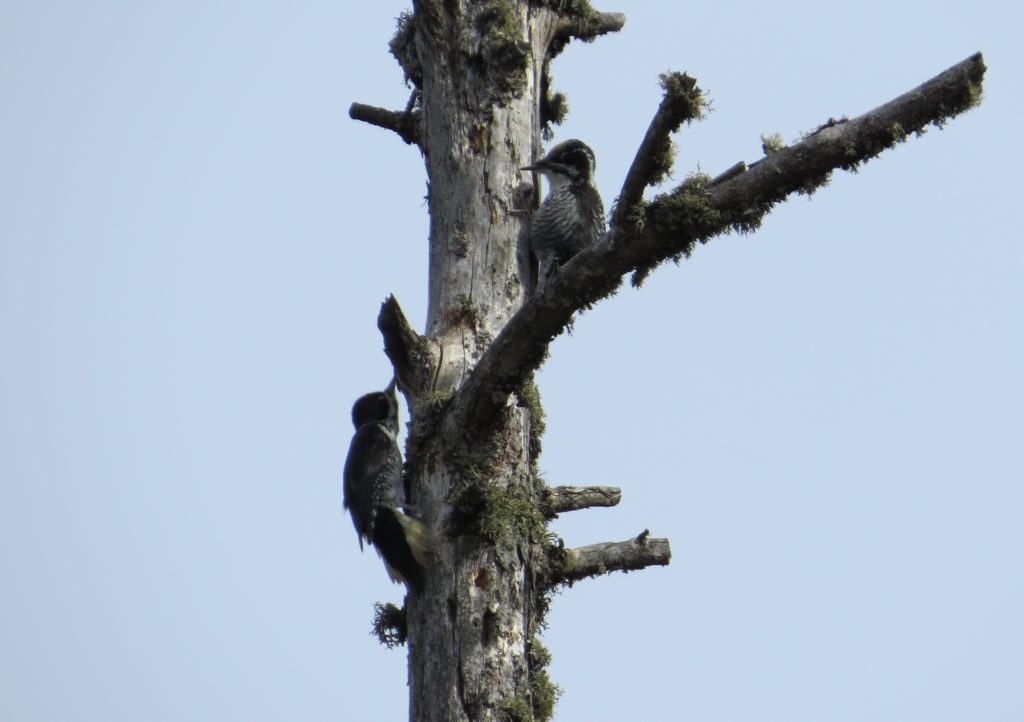
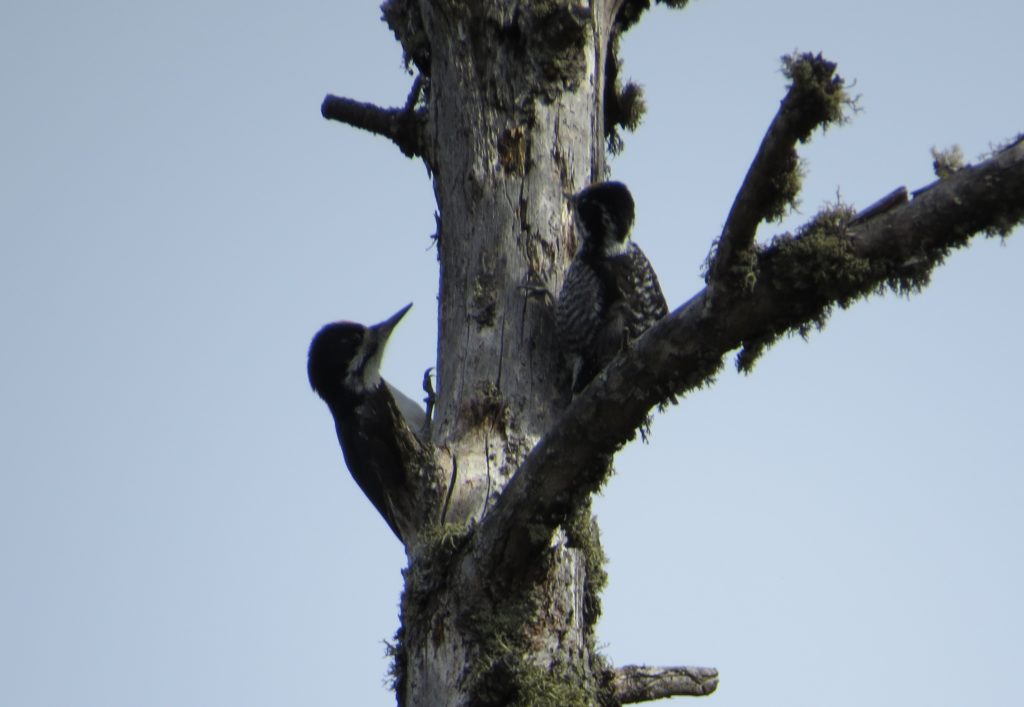 And in the end, one Woodpecker clearly won out.
And in the end, one Woodpecker clearly won out.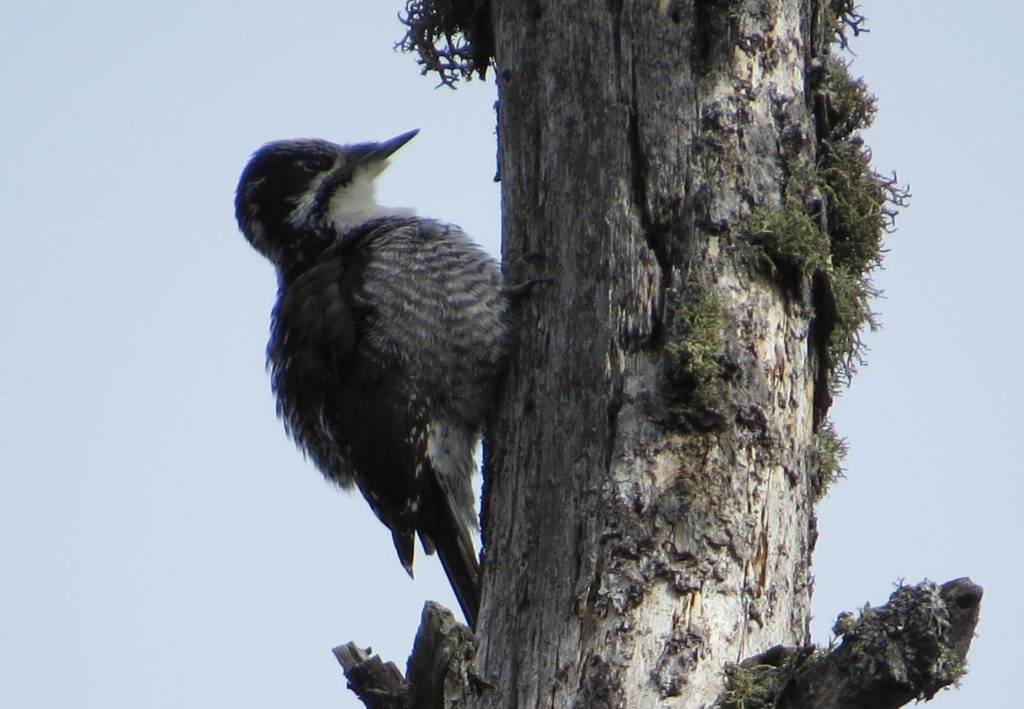 Eventually, the Woodpeckers (and Sparky) dispersed into the woods and the excitement was over. Later on, Julie Grahn and Dee Kuder showed up, and along with Sparky we all enjoyed the Spruce Grouse show that was highlighted in the last post. A huge thank you goes out to Julie Grahn for finding and reporting these birds and assisting me in finding them. It was an incredible experience–I couldn’t have asked for a better way to get this lifer.
Eventually, the Woodpeckers (and Sparky) dispersed into the woods and the excitement was over. Later on, Julie Grahn and Dee Kuder showed up, and along with Sparky we all enjoyed the Spruce Grouse show that was highlighted in the last post. A huge thank you goes out to Julie Grahn for finding and reporting these birds and assisting me in finding them. It was an incredible experience–I couldn’t have asked for a better way to get this lifer.
 Since that comment was written, I have knocked off all those ducks but one–the Barrow’s Goldeneye, a bird considered casual in Minnesota occurring roughly every 5 years. As I am getting to the end of my normal MN birds, BAGO was rapidly moving its way up to the top of the list of my most-wanted birds. Last year I chased a female BAGO in Fergus Falls but failed. This year there have been a couple other reports but nothing I considered reliable and therefore chaseable. Well, a little over two weeks ago, Adam Roesch birded at the Mississippi River in Champlin–quite aways upstream from his beloved patch–and made a stunning discovery. Among the myriad of Common Goldeneye, Adam found and photographed a beautiful male Barrow’s Goldeneye. And with that find, Adam submitted his first ever eBird checklist. Talk about an entrance.
Since that comment was written, I have knocked off all those ducks but one–the Barrow’s Goldeneye, a bird considered casual in Minnesota occurring roughly every 5 years. As I am getting to the end of my normal MN birds, BAGO was rapidly moving its way up to the top of the list of my most-wanted birds. Last year I chased a female BAGO in Fergus Falls but failed. This year there have been a couple other reports but nothing I considered reliable and therefore chaseable. Well, a little over two weeks ago, Adam Roesch birded at the Mississippi River in Champlin–quite aways upstream from his beloved patch–and made a stunning discovery. Among the myriad of Common Goldeneye, Adam found and photographed a beautiful male Barrow’s Goldeneye. And with that find, Adam submitted his first ever eBird checklist. Talk about an entrance.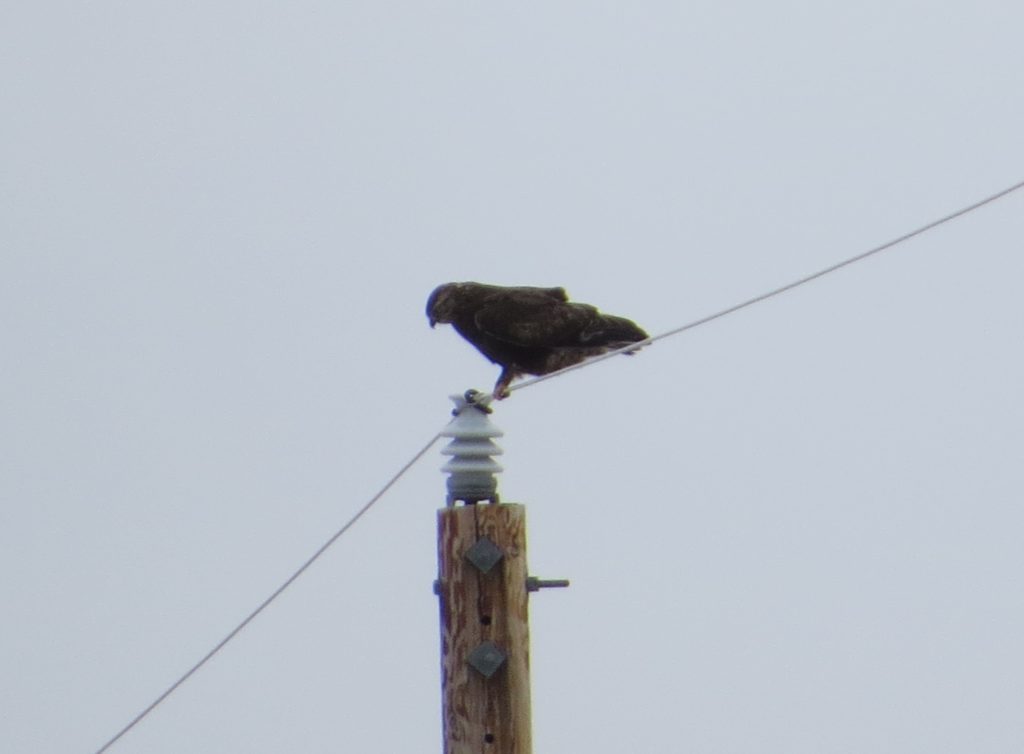
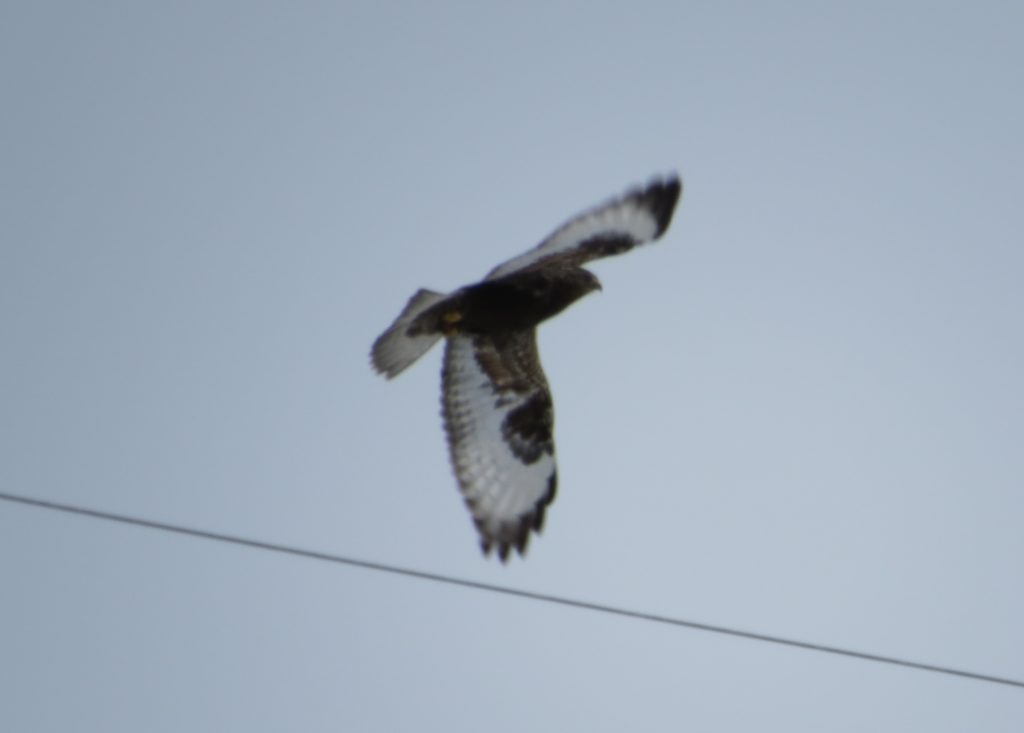 For the second time in as many weekends, we arrived at Anoka’s Peninsula Point Park to scan the Mississippi for the good Goldeneye.
For the second time in as many weekends, we arrived at Anoka’s Peninsula Point Park to scan the Mississippi for the good Goldeneye.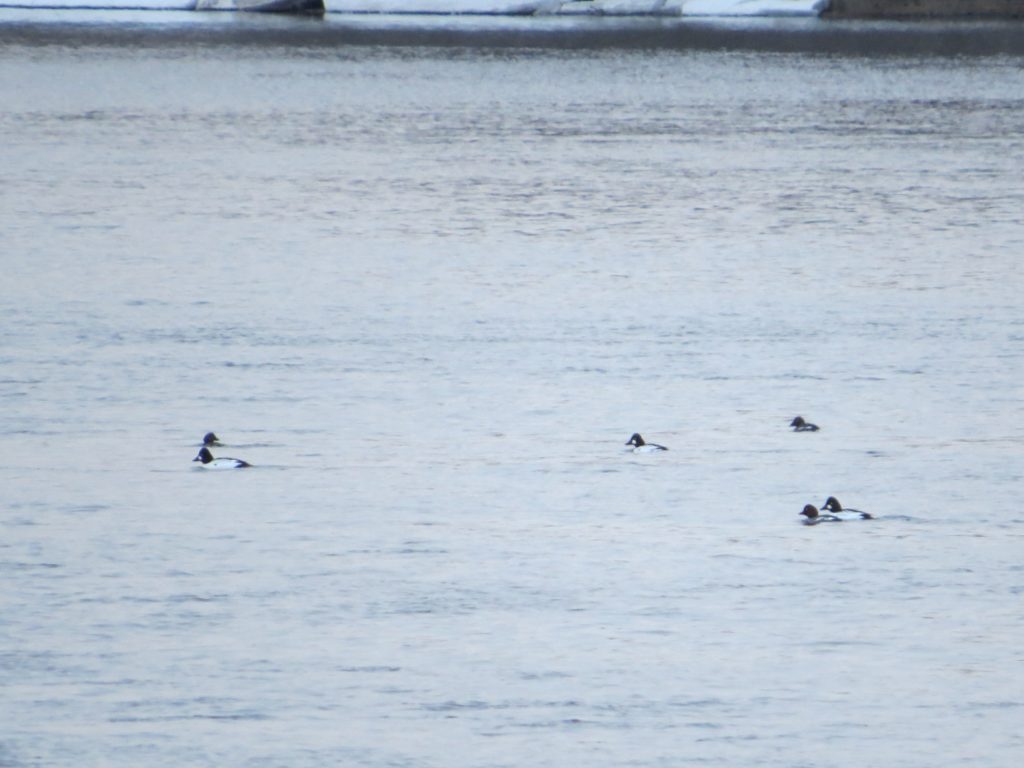
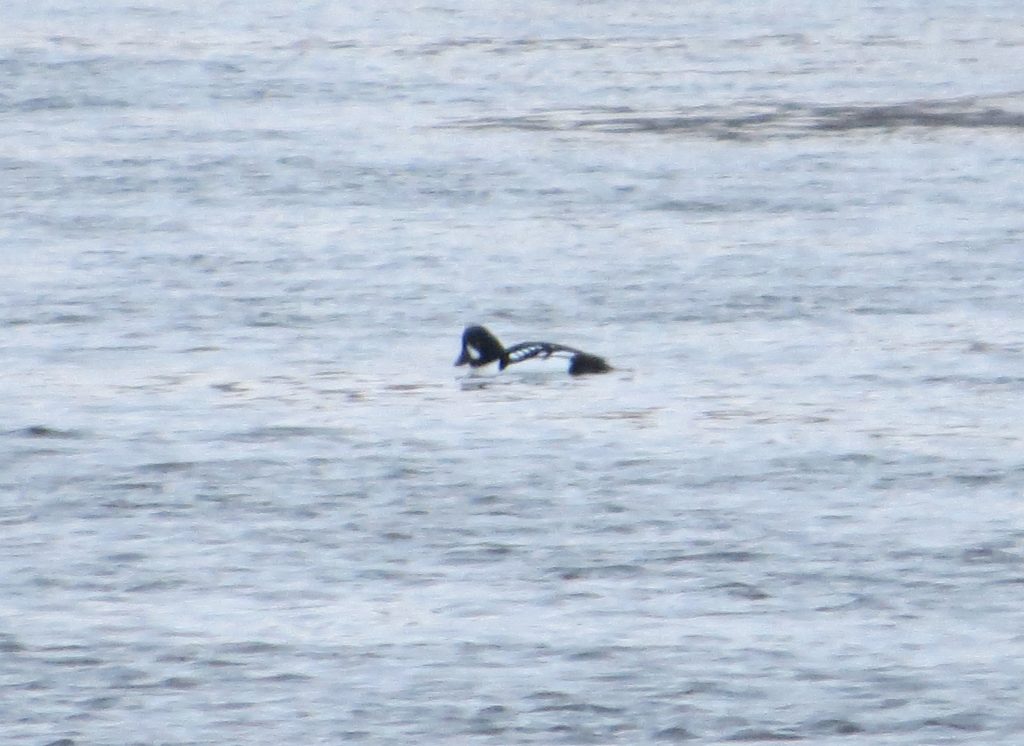 There’s just something that I absolutely love about getting duck lifers in the cold months.
There’s just something that I absolutely love about getting duck lifers in the cold months.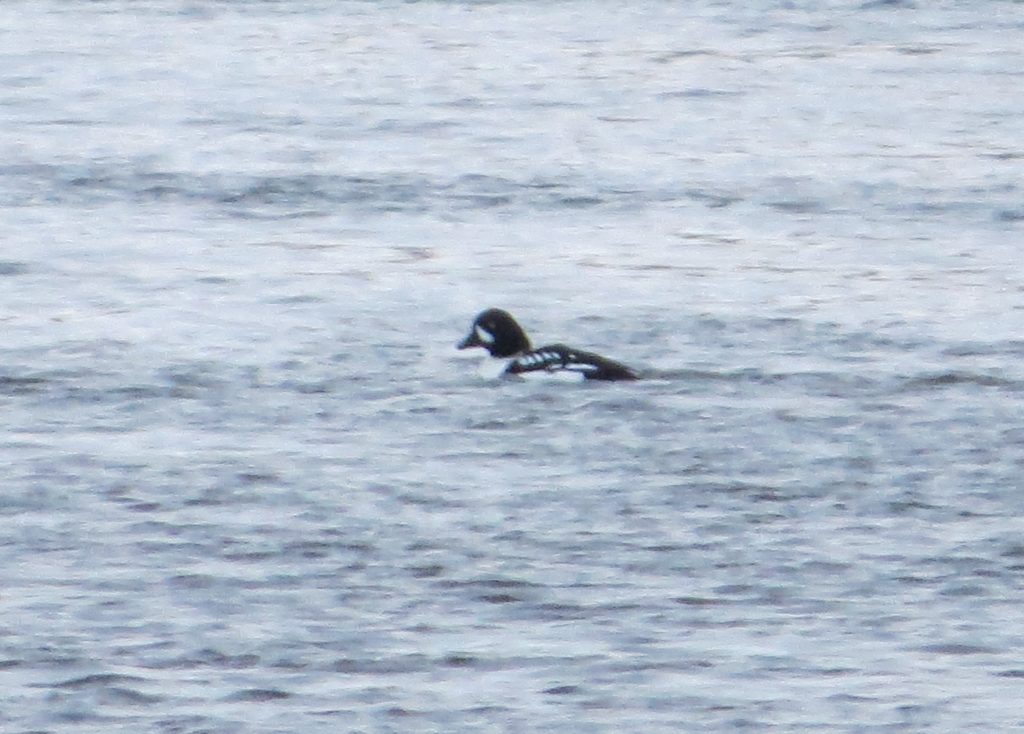
 I’m not lying. This skyline view of Minneapolis is literally what this Snowy Owl can see from its bizarre winter territory. I am used to looking for Snowies in urban environments, but nothing quite like this. Snowy Owls aren’t that hard to spot in places like this, yet I was having a hard time, a really hard time. I finally ran into another birder who clued me in to this sneaky Snowy’s hideout.
I’m not lying. This skyline view of Minneapolis is literally what this Snowy Owl can see from its bizarre winter territory. I am used to looking for Snowies in urban environments, but nothing quite like this. Snowy Owls aren’t that hard to spot in places like this, yet I was having a hard time, a really hard time. I finally ran into another birder who clued me in to this sneaky Snowy’s hideout. See it? Yeah, I didn’t either without help.
See it? Yeah, I didn’t either without help.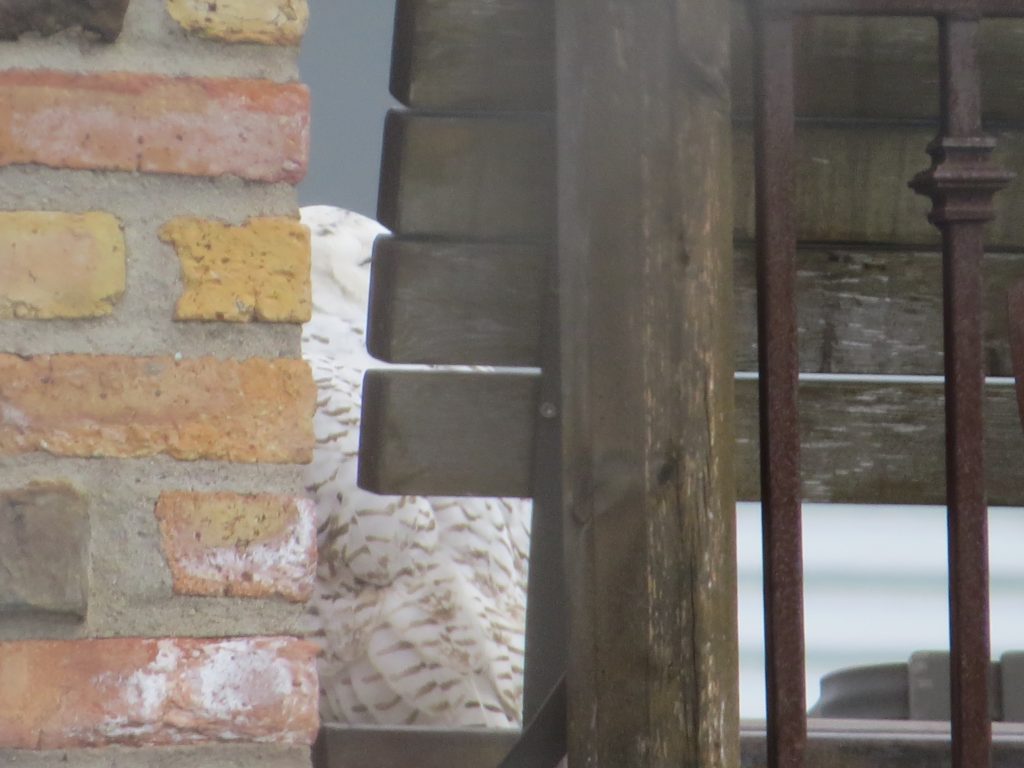 Never have I seen an Owl, Snowy or otherwise, so well fortified. Camouflaged, yes, but not entrenched. I tried every which angle and every side of the building for a shot.
Never have I seen an Owl, Snowy or otherwise, so well fortified. Camouflaged, yes, but not entrenched. I tried every which angle and every side of the building for a shot.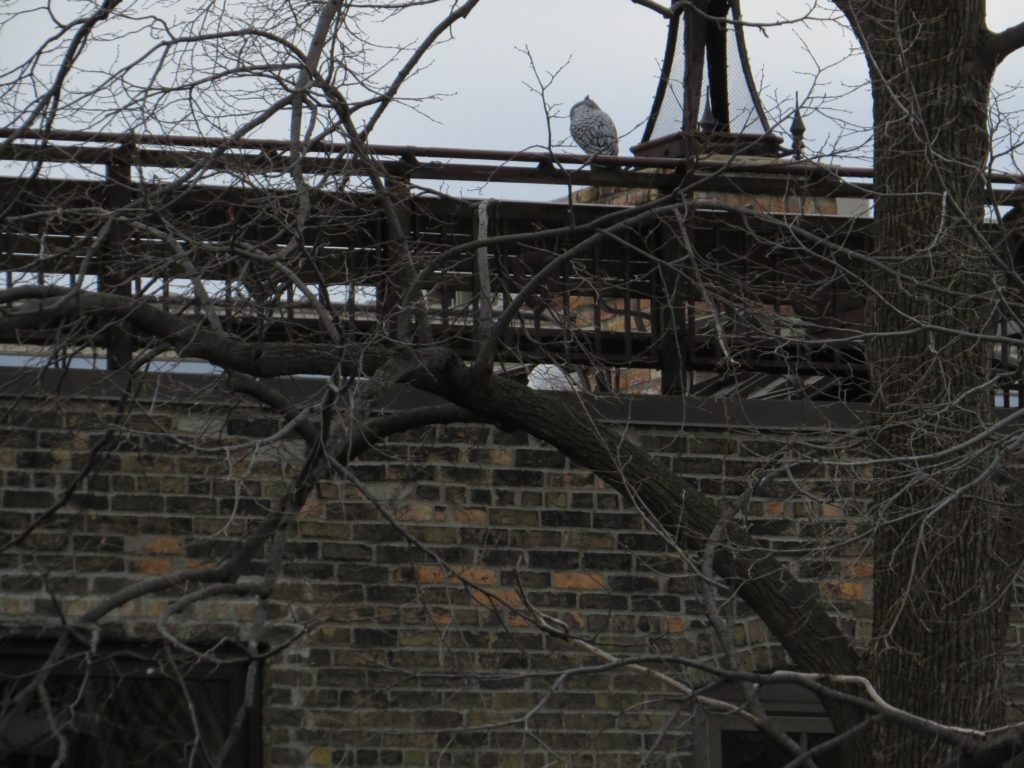
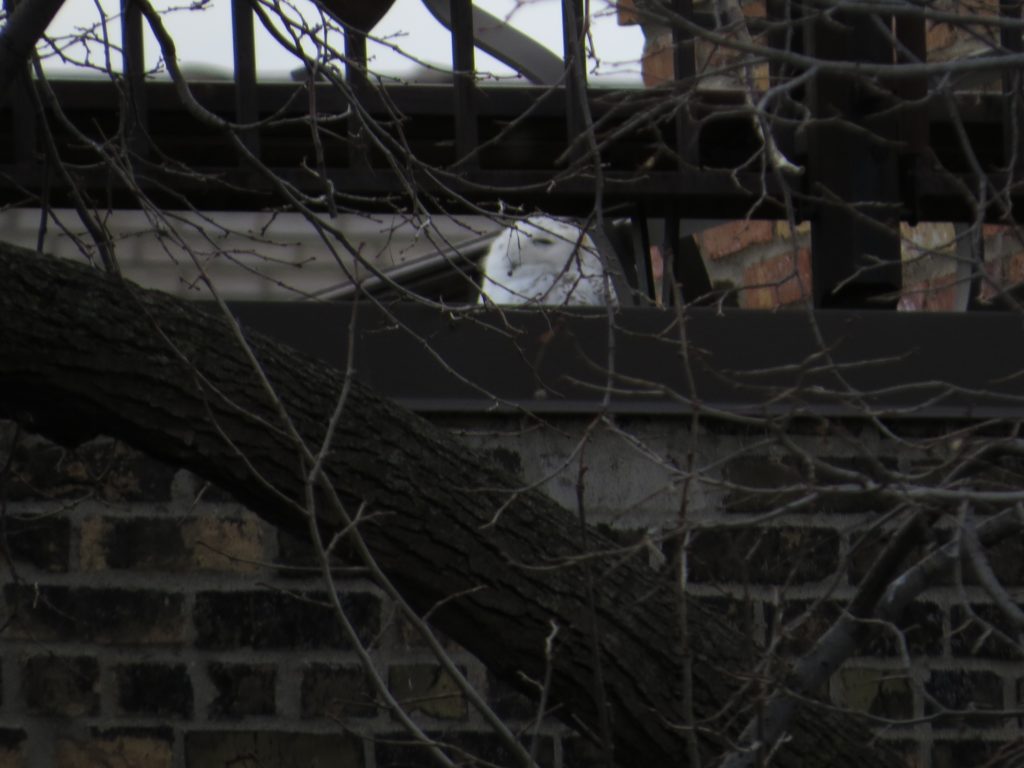 The non-birding-totally-birding metro trip was a success by any standard. It was back to rural west-cental MN where more adventure awaited in the days to come. We’ll save that for the next post, but to close things out, here’s a Great Horned Owl the kids and I saw on the ride back home.
The non-birding-totally-birding metro trip was a success by any standard. It was back to rural west-cental MN where more adventure awaited in the days to come. We’ll save that for the next post, but to close things out, here’s a Great Horned Owl the kids and I saw on the ride back home.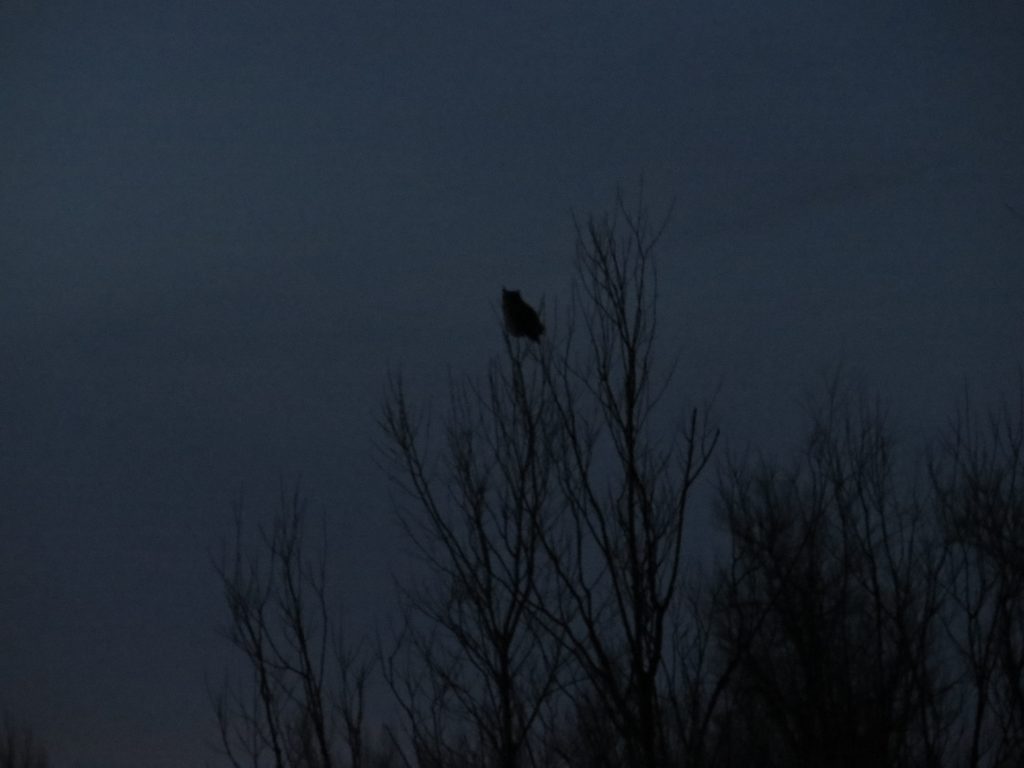
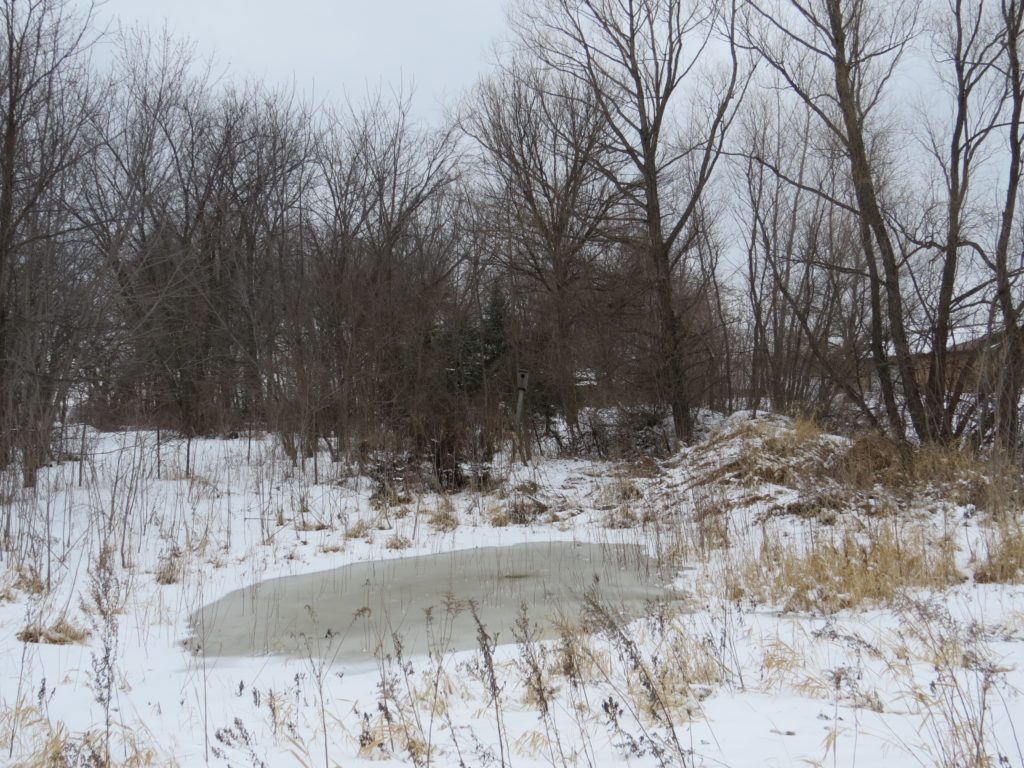 The homeowner, Kathy, assured Jeff the Owl was there regularly; it would just be a matter of me finding a time to make the 2-hour trip. Funny thing when you are a parent, your time no longer belongs to you–work and kid activities keep us hopping and out of the house most every day and now on weekends too. Birding definitely takes a back seat. I was feeling the need to get this done though; bird in the hand and whatnot. With Melissa being gone on a trip all weekend, I was staring at some serious single-parenting. The red Screech dream was seemingly out of reach. So I did what any serious Owler would do: cashed in some comp time and took me an Owliday mid-week.
The homeowner, Kathy, assured Jeff the Owl was there regularly; it would just be a matter of me finding a time to make the 2-hour trip. Funny thing when you are a parent, your time no longer belongs to you–work and kid activities keep us hopping and out of the house most every day and now on weekends too. Birding definitely takes a back seat. I was feeling the need to get this done though; bird in the hand and whatnot. With Melissa being gone on a trip all weekend, I was staring at some serious single-parenting. The red Screech dream was seemingly out of reach. So I did what any serious Owler would do: cashed in some comp time and took me an Owliday mid-week.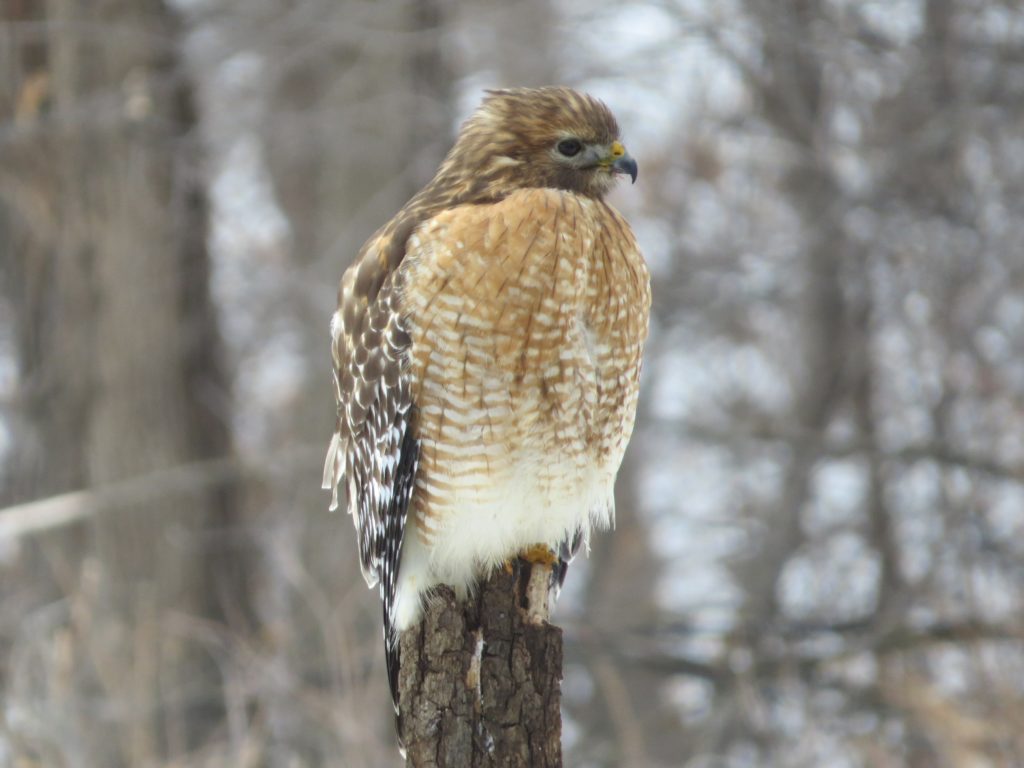
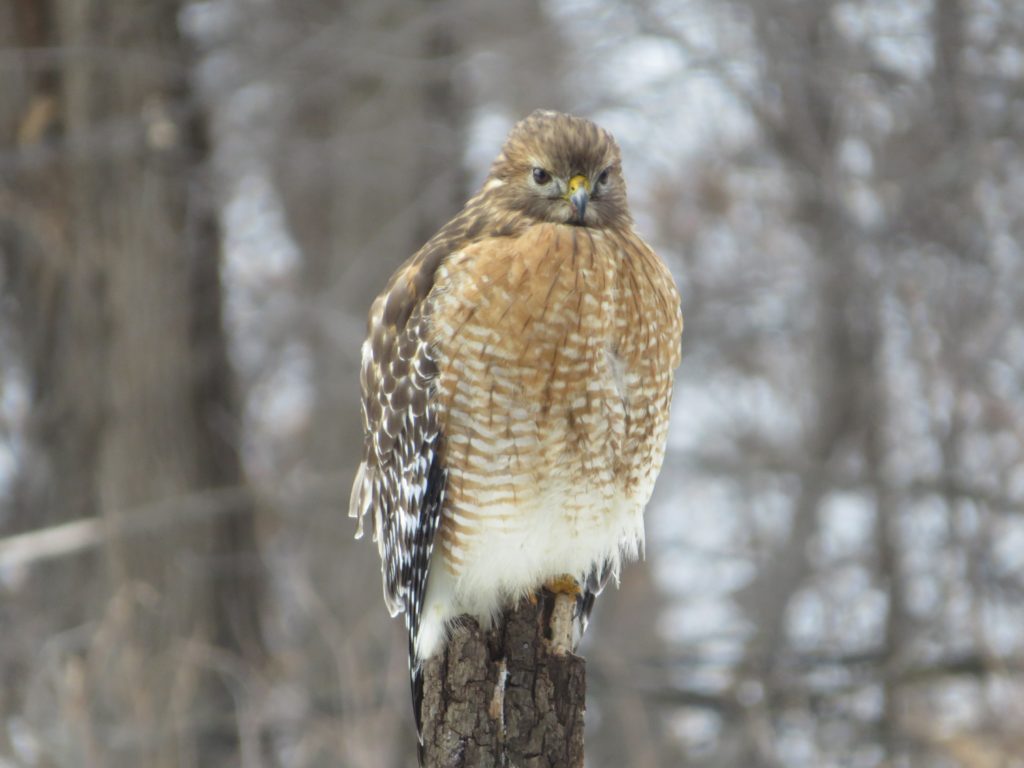 These photos were shot through glass. Like Jeff, Steve is an accomplished photographer who ushered me into his photo blind where I could photograph the Hawk without a glass barrier. Unfortunately, the Hawk got a bit nervous and flew into some tangles. But have a look at that tail!
These photos were shot through glass. Like Jeff, Steve is an accomplished photographer who ushered me into his photo blind where I could photograph the Hawk without a glass barrier. Unfortunately, the Hawk got a bit nervous and flew into some tangles. But have a look at that tail!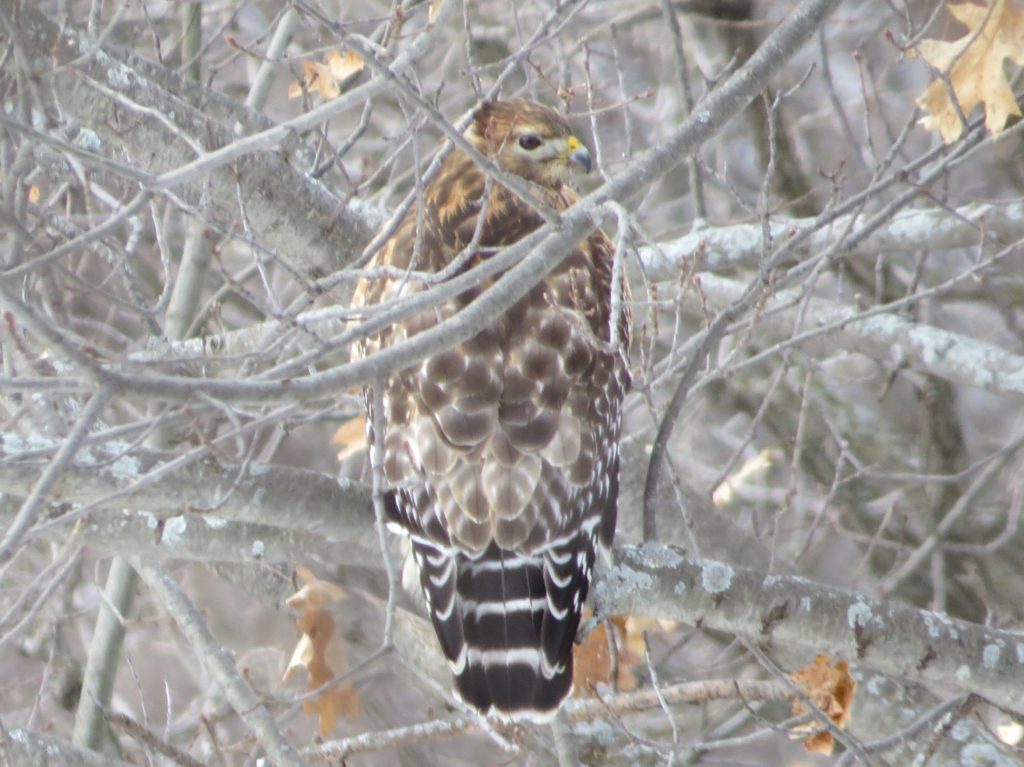 I very quickly learned that Steve, a retired dentist, was taking our birding mission very seriously. While the main object was to get me the red Screech, Steve did not want to send his newest guest away without getting some other good birds too. He was off to a stellar start. In many ways I felt like I was in a parallel birding world to my experiences in Arizona. Jeff was the MN Tommy and Steve was the MN Gordon. Like in Arizona, there was one main mission for the day–get Josh the red Screech. That didn’t mean we couldn’t enjoy a little action while we waited, like this American Black Duck among the 500+ Mallards it was with at the Shakopee Mill Pond. Black Ducks have been really good to me this year.
I very quickly learned that Steve, a retired dentist, was taking our birding mission very seriously. While the main object was to get me the red Screech, Steve did not want to send his newest guest away without getting some other good birds too. He was off to a stellar start. In many ways I felt like I was in a parallel birding world to my experiences in Arizona. Jeff was the MN Tommy and Steve was the MN Gordon. Like in Arizona, there was one main mission for the day–get Josh the red Screech. That didn’t mean we couldn’t enjoy a little action while we waited, like this American Black Duck among the 500+ Mallards it was with at the Shakopee Mill Pond. Black Ducks have been really good to me this year.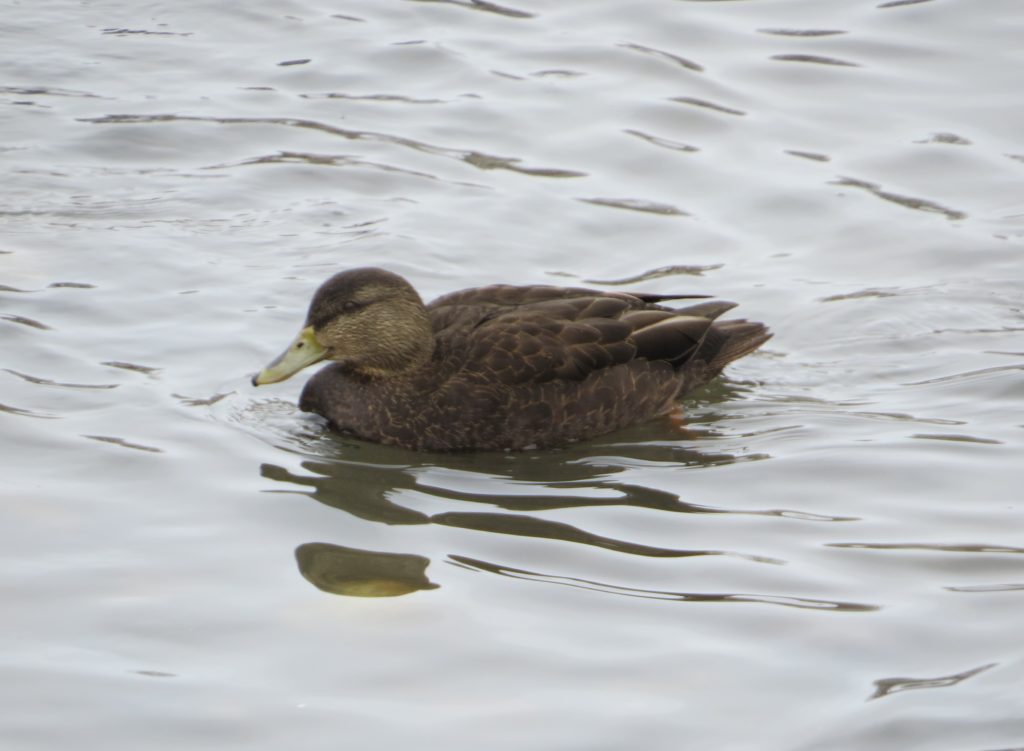 The open water was a good chance to pick up some FOYs as I still struggle to reach that barrier of 50 species. Belted Kingfisher, American Coot, Ring-necked Duck, and Lesser Scaup were all new for the year. Ducks do not hold the attention for long, so we were off to do some backroads exploring while we waited for a sighting update on the red Screech. We were told it pops out of the hole of the Wood Duck box regularly on sunny days. This day was dreadfully cloudy, so we were hearing nothing in regards to the Owl. Just like Tommy, Jeff was really wanting to get me the target Owl bad. We discussed an alternative option in St. Paul, but that was quite far away and no one had seen Screech- Owls in that spot for months. As the hours ticked on, we were all wondering if the day’s objective would be a bust. Jeff figured our best shot was still with this homeowner, so he messaged her to ask if we could poke around the property to try to turn it up. With an affirmative answer, we were on our way to at least make an attempt.
The open water was a good chance to pick up some FOYs as I still struggle to reach that barrier of 50 species. Belted Kingfisher, American Coot, Ring-necked Duck, and Lesser Scaup were all new for the year. Ducks do not hold the attention for long, so we were off to do some backroads exploring while we waited for a sighting update on the red Screech. We were told it pops out of the hole of the Wood Duck box regularly on sunny days. This day was dreadfully cloudy, so we were hearing nothing in regards to the Owl. Just like Tommy, Jeff was really wanting to get me the target Owl bad. We discussed an alternative option in St. Paul, but that was quite far away and no one had seen Screech- Owls in that spot for months. As the hours ticked on, we were all wondering if the day’s objective would be a bust. Jeff figured our best shot was still with this homeowner, so he messaged her to ask if we could poke around the property to try to turn it up. With an affirmative answer, we were on our way to at least make an attempt.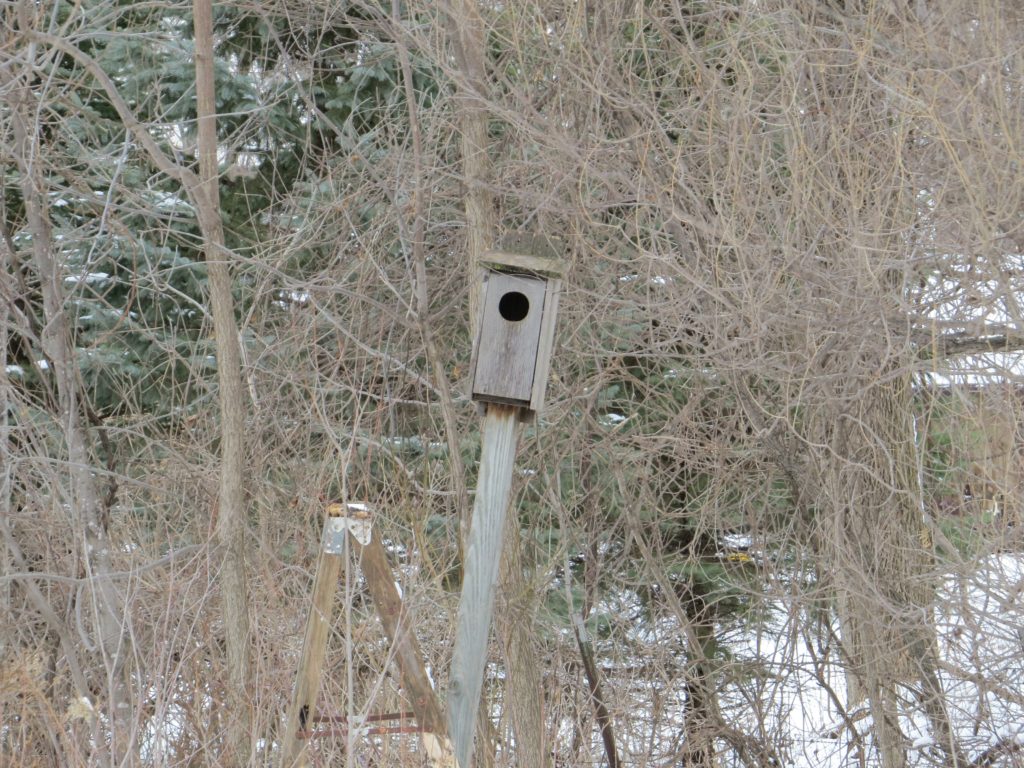 Knowing there was a red Screech in there made for some impatient waiting. The Owl was not being cooperative at all while we watched and waited. We were so close to meeting the big objective, but it just wasn’t happening and the impatience of all was festering. Would we have come this far only to fail? What’s that they say? When a door closes, open a window?
Knowing there was a red Screech in there made for some impatient waiting. The Owl was not being cooperative at all while we watched and waited. We were so close to meeting the big objective, but it just wasn’t happening and the impatience of all was festering. Would we have come this far only to fail? What’s that they say? When a door closes, open a window?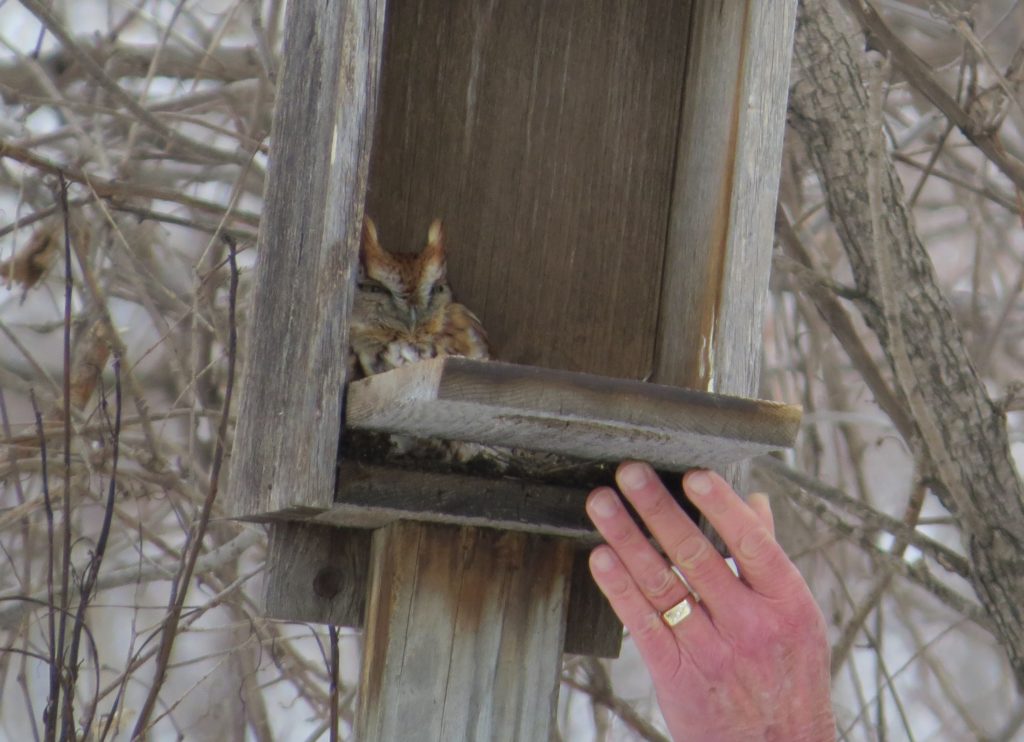
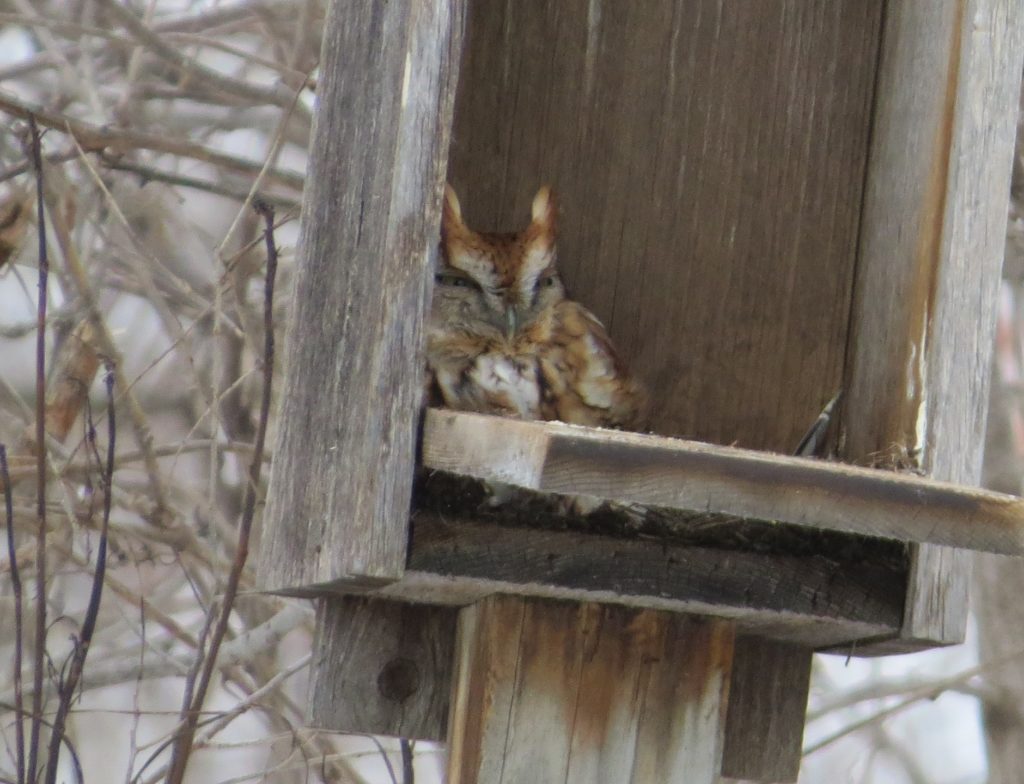
 We thought this Owl was going to let us photograph it in this position for a little while, but after a half minute or so, it had enough of this nonsense and flew straight toward us and directly into to the hole of another Wood Duck box. We never did see it again and decided to leave it alone. High on a successful trip, we continued to hang out by that little pond and talk Owls with Mike and Kathy. We thanked them profusely and were finally on our way. With a few hours of daylight left, the day was still wide open with possibility.
We thought this Owl was going to let us photograph it in this position for a little while, but after a half minute or so, it had enough of this nonsense and flew straight toward us and directly into to the hole of another Wood Duck box. We never did see it again and decided to leave it alone. High on a successful trip, we continued to hang out by that little pond and talk Owls with Mike and Kathy. We thanked them profusely and were finally on our way. With a few hours of daylight left, the day was still wide open with possibility.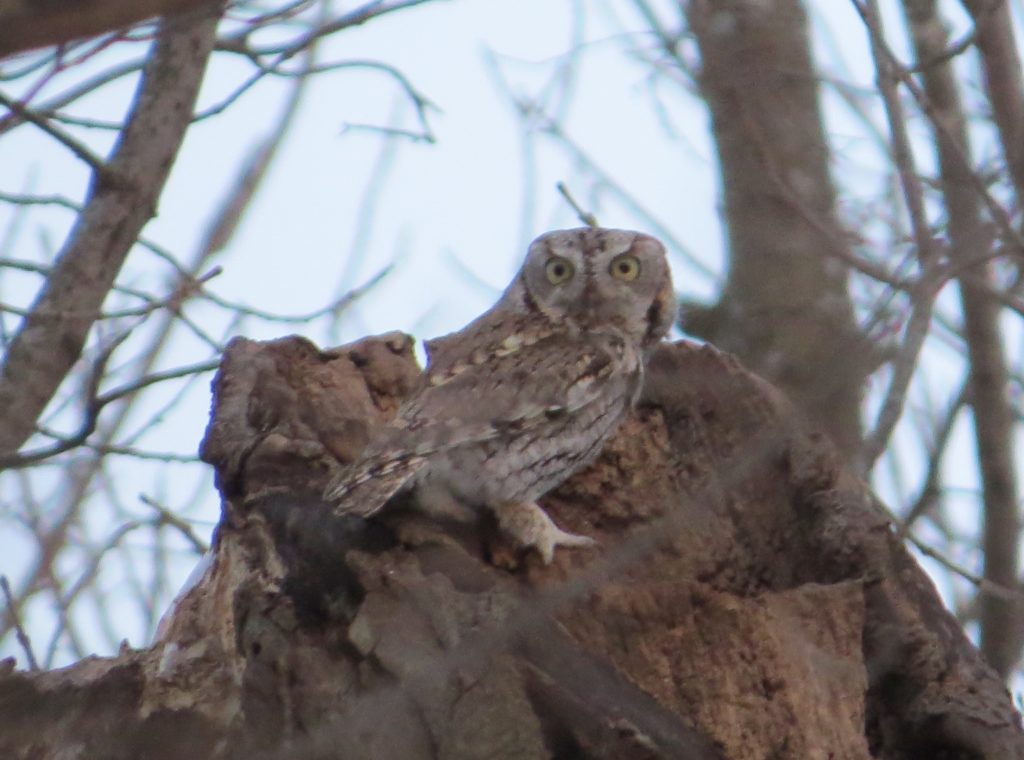 Quality over quantity is what this birding year is all about this year. This day definitely embodied that as a lifer* Owl was had with a couple of bonus Owls all while having fun with friends. A huge thanks to Jeff Grotte for setting everything up and making a fun day off, to Steve Brown for the other good birds and the selfless enthusiasm, and most importantly a big thank you to Mike and Kathy for sharing their special yard bird with us. There will be more Owling with Jeff and possibly Steve in the months to come. But first, I have a duck to track down.
Quality over quantity is what this birding year is all about this year. This day definitely embodied that as a lifer* Owl was had with a couple of bonus Owls all while having fun with friends. A huge thanks to Jeff Grotte for setting everything up and making a fun day off, to Steve Brown for the other good birds and the selfless enthusiasm, and most importantly a big thank you to Mike and Kathy for sharing their special yard bird with us. There will be more Owling with Jeff and possibly Steve in the months to come. But first, I have a duck to track down. When I pulled up to the boat launch at Lake Waconia Regional Park, I saw a Carver County Sheriff truck trailering a patrol boat. I thought it was odd since no one would be on the lake on a day like this nor could a boat be launched in the rapidly building ice. Strange. I didn’t think about it much more and set about my business of finding my target. Watching the sea swells and facing into the sub-zero windchills was brutal even for being dressed for the elements. Scans of the big lake were intermittent and necessitated warm-up sessions in the car. Having no luck seeing the duck (which was there that morning), I asked Julie for any tips on where to stare into that blue abyss to find this duck. In giving me directions, Julie also reminded me of the ongoing search for a paddleboarder that went missing two week prior. The dots started connecting in my head regarding the Sheriff’s trailered boat, trucks driving slowly along the shoreline who I had thought were also looking for the Scoter, and my own vague recollection of a news report I had seen. It was suddenly a grim realization that I should be looking for more than just my bird.
When I pulled up to the boat launch at Lake Waconia Regional Park, I saw a Carver County Sheriff truck trailering a patrol boat. I thought it was odd since no one would be on the lake on a day like this nor could a boat be launched in the rapidly building ice. Strange. I didn’t think about it much more and set about my business of finding my target. Watching the sea swells and facing into the sub-zero windchills was brutal even for being dressed for the elements. Scans of the big lake were intermittent and necessitated warm-up sessions in the car. Having no luck seeing the duck (which was there that morning), I asked Julie for any tips on where to stare into that blue abyss to find this duck. In giving me directions, Julie also reminded me of the ongoing search for a paddleboarder that went missing two week prior. The dots started connecting in my head regarding the Sheriff’s trailered boat, trucks driving slowly along the shoreline who I had thought were also looking for the Scoter, and my own vague recollection of a news report I had seen. It was suddenly a grim realization that I should be looking for more than just my bird.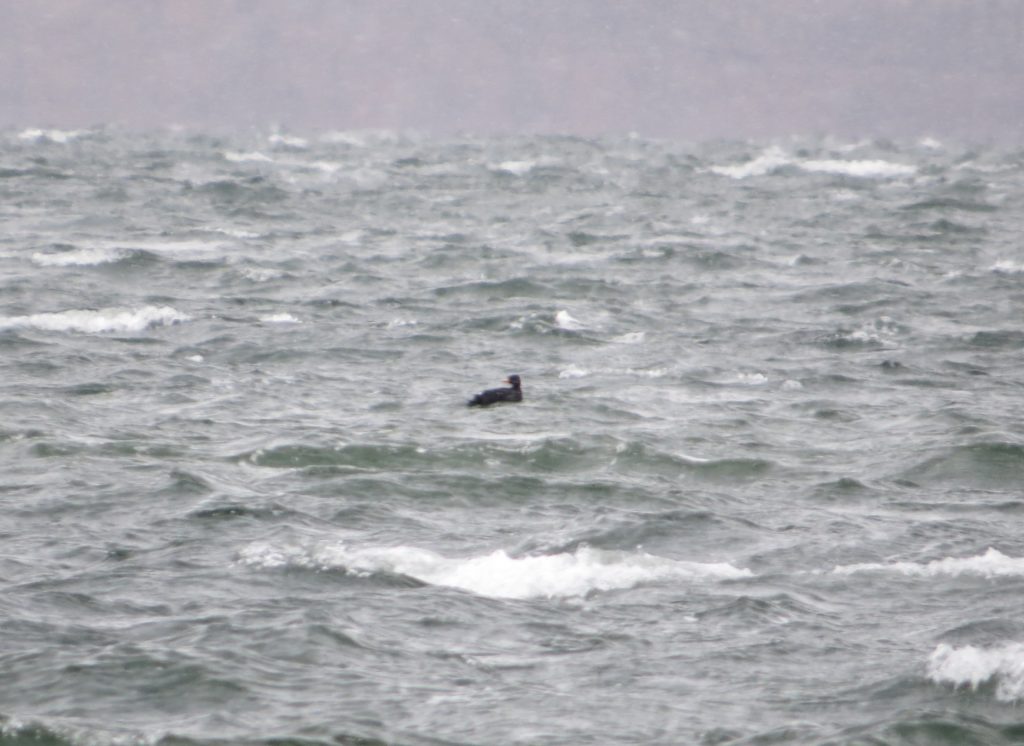 The incredible distance, the numb fingers, and disappearing/reappearing bird made picture-taking a nightmare. Regardless, I was thrilled to finally add this bird and see an adult male at that, a gender/plumage combo that is rarely ever seen in the state.
The incredible distance, the numb fingers, and disappearing/reappearing bird made picture-taking a nightmare. Regardless, I was thrilled to finally add this bird and see an adult male at that, a gender/plumage combo that is rarely ever seen in the state.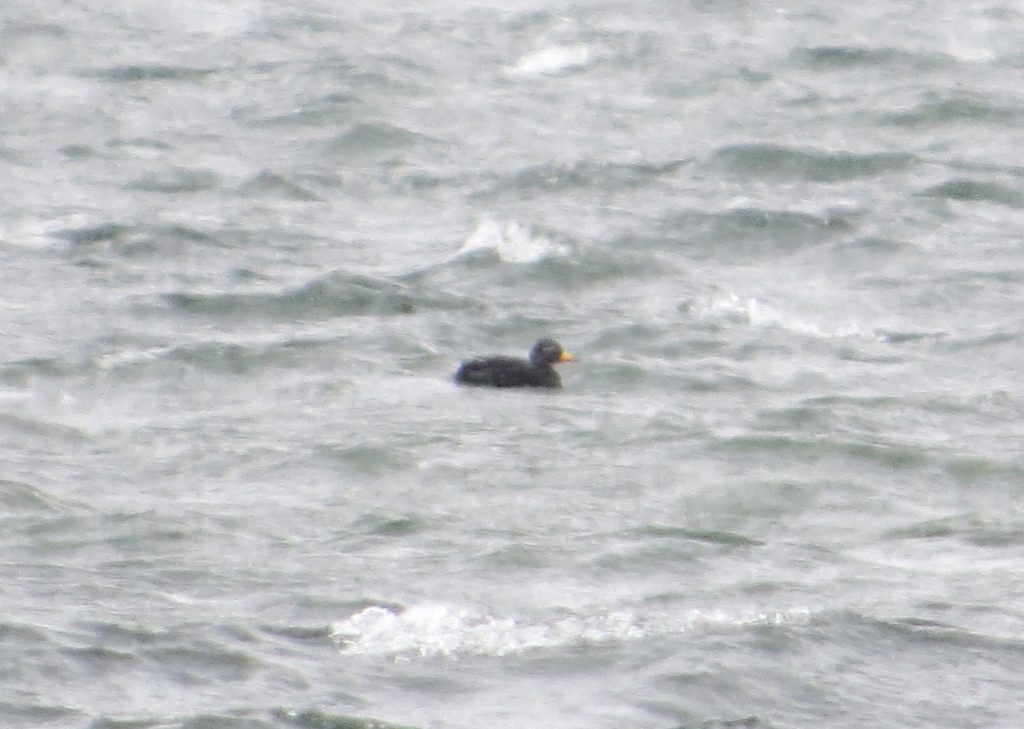
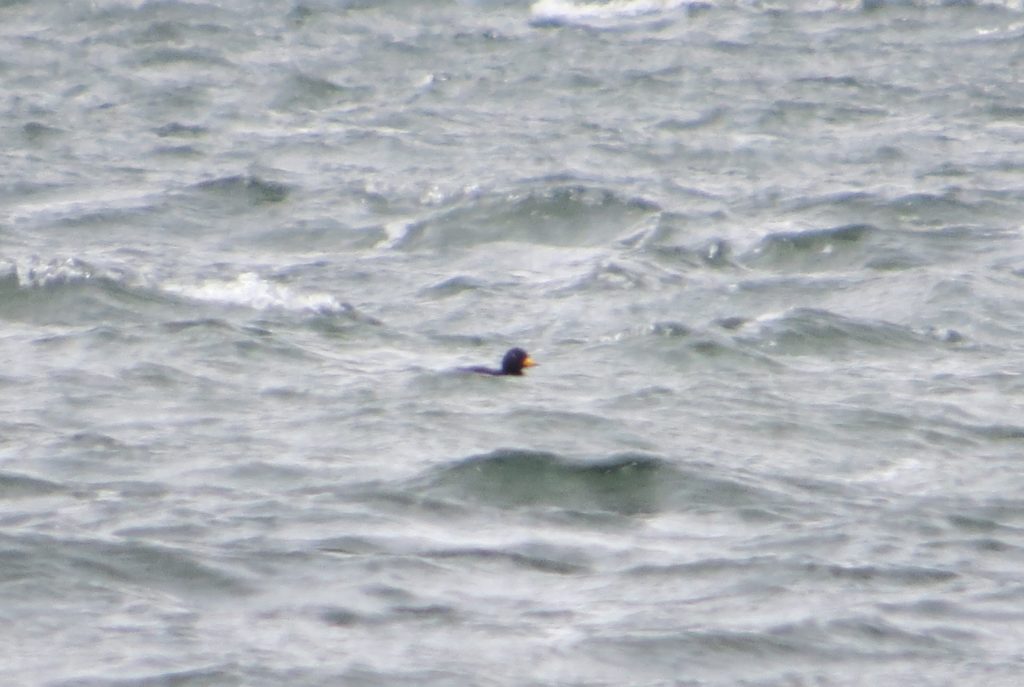
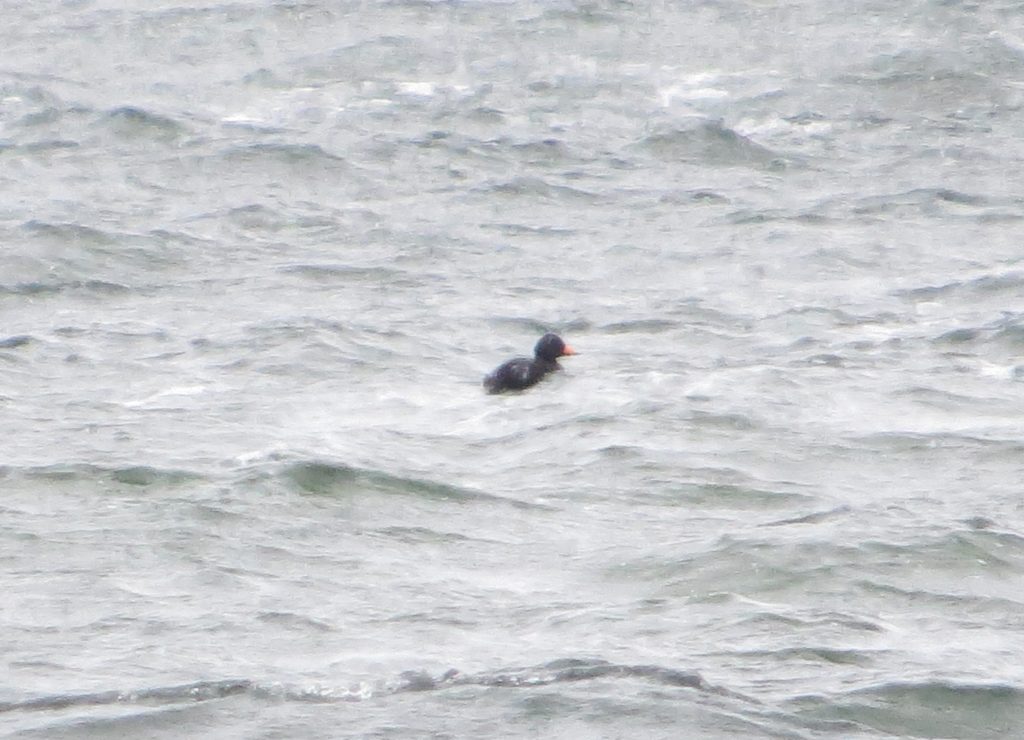 The excitement of this new addition was tempered by a Sheriff’s helicopter making constant circles around the lake the whole time I was there, undoubtedly desperate to find this man on this last day of open water. The man was just a couple years younger than me with two young kids and another on the way. He had gone out to pursue his passion of wildlife photography from his paddleboard. And here I was at the same body of water just a couple weeks later pursuing mine. Life really is unfair. The whole ride back to work it was hard not to wonder if I sometimes take unnecessary risks in the pursuit of my hobby. Then again, a life lived with no adventure is a life not fully lived. Seize the day.
The excitement of this new addition was tempered by a Sheriff’s helicopter making constant circles around the lake the whole time I was there, undoubtedly desperate to find this man on this last day of open water. The man was just a couple years younger than me with two young kids and another on the way. He had gone out to pursue his passion of wildlife photography from his paddleboard. And here I was at the same body of water just a couple weeks later pursuing mine. Life really is unfair. The whole ride back to work it was hard not to wonder if I sometimes take unnecessary risks in the pursuit of my hobby. Then again, a life lived with no adventure is a life not fully lived. Seize the day.
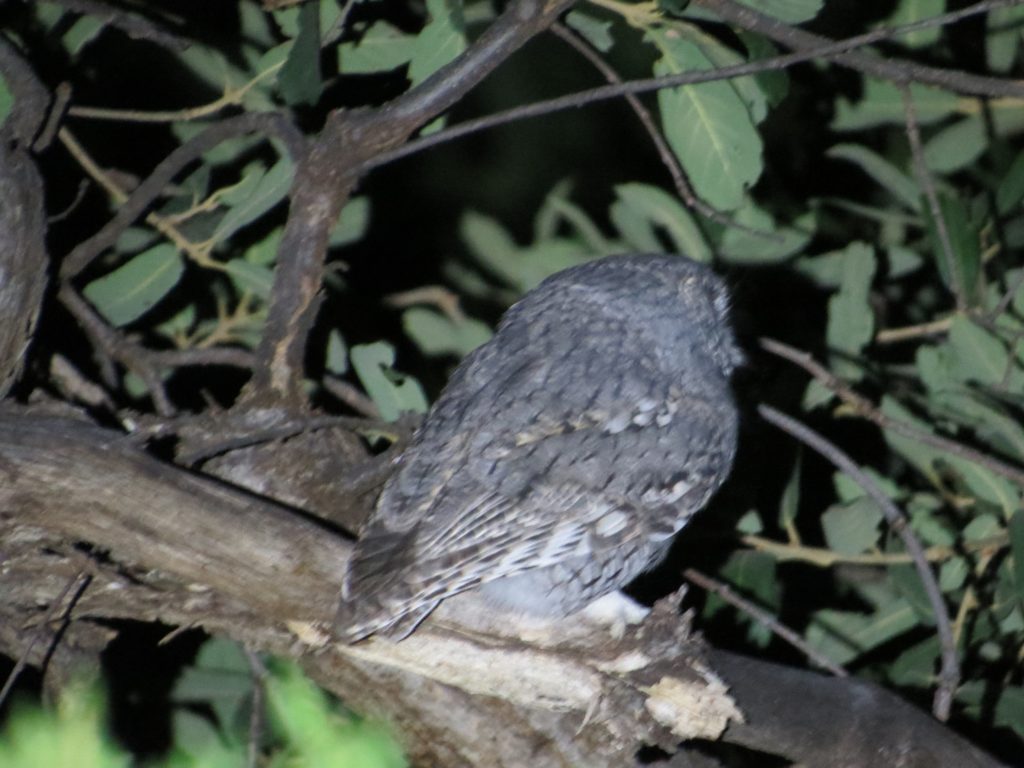 As we crept along the canyon hillside to get in a better position to see the Owl’s face, it suddenly flew off! We could not find it again. The satisfaction of getting the lifer was muted by the Owl showing us his bad side and only briefly at that. Would this be my lifer sighting–the side view of a bird? The discouragement was returning the longer we weren’t finding it. Again, Tommy never panicked or wavered; he just kept that flashlight moving. And then I heard him say those awesome words that I have heard him say so many times before, “Hey, Josh!”
As we crept along the canyon hillside to get in a better position to see the Owl’s face, it suddenly flew off! We could not find it again. The satisfaction of getting the lifer was muted by the Owl showing us his bad side and only briefly at that. Would this be my lifer sighting–the side view of a bird? The discouragement was returning the longer we weren’t finding it. Again, Tommy never panicked or wavered; he just kept that flashlight moving. And then I heard him say those awesome words that I have heard him say so many times before, “Hey, Josh!”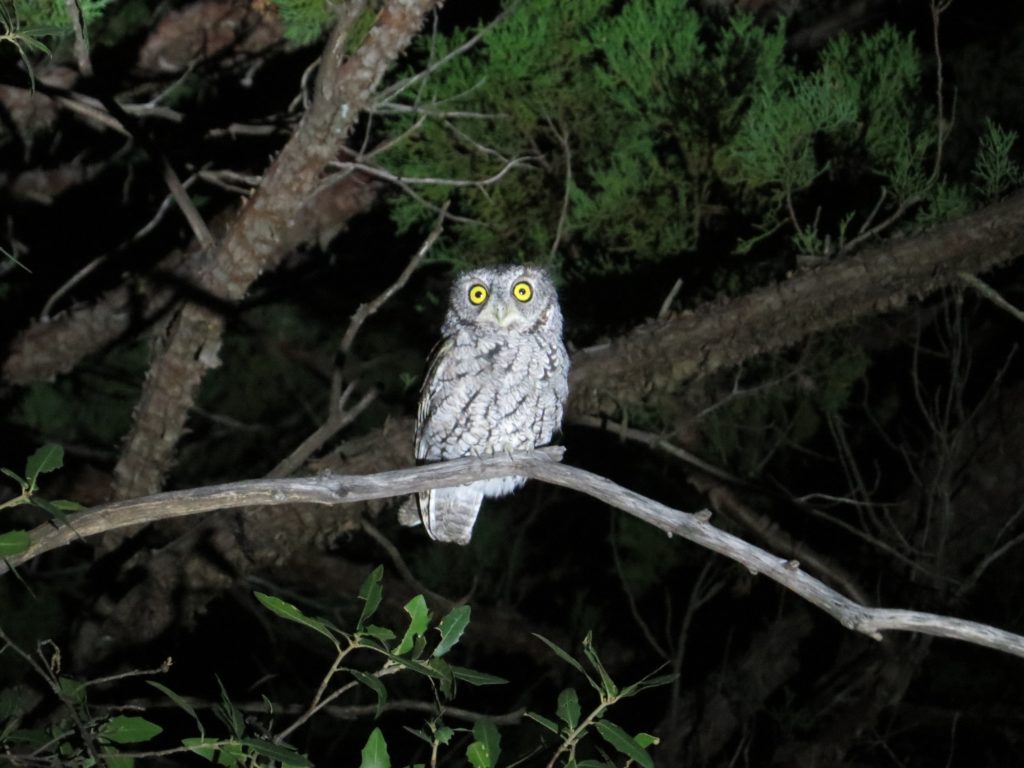 This, this is what I had been waiting/hoping for. Tommy did it.
This, this is what I had been waiting/hoping for. Tommy did it.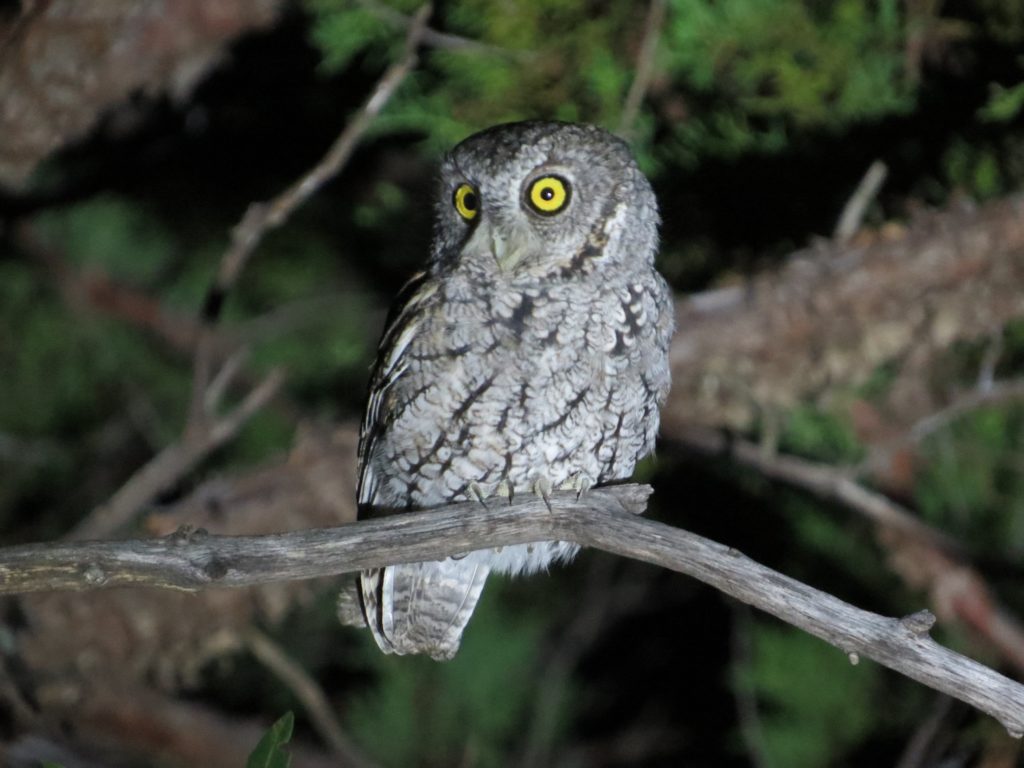 This Owl was very cooperative (finally) and just let us enjoy the show.
This Owl was very cooperative (finally) and just let us enjoy the show.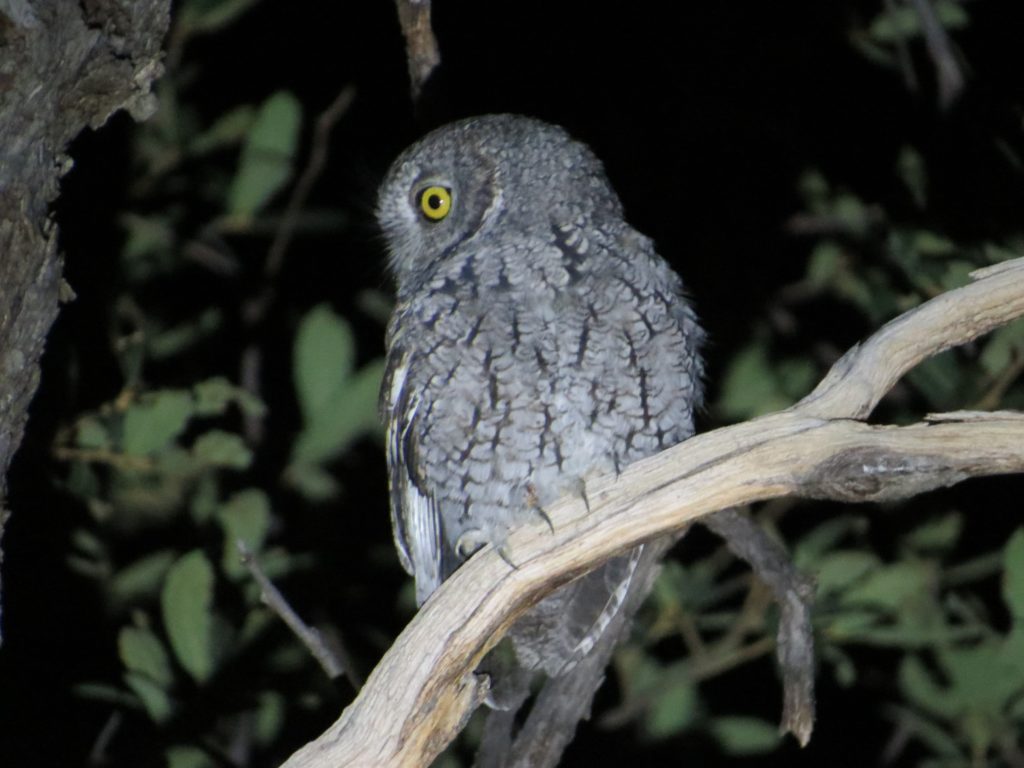
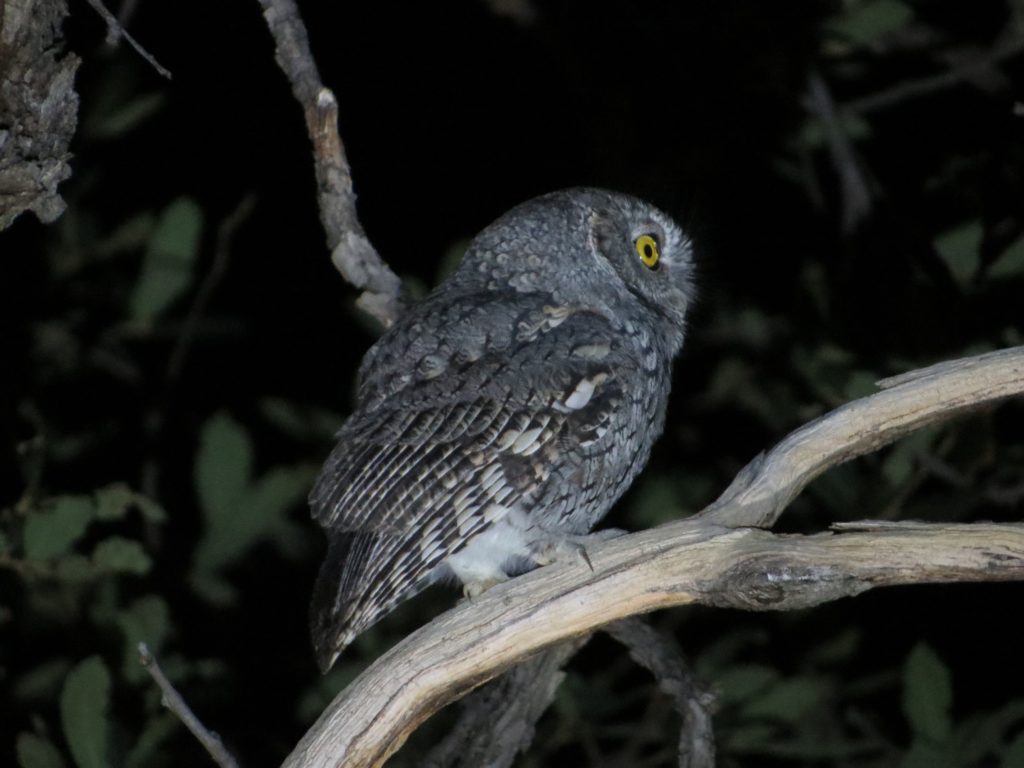 Maybe I had it backwards. Maybe it was the Owl who was enjoying the show of four happy birders who had just succeeded on their mission.
Maybe I had it backwards. Maybe it was the Owl who was enjoying the show of four happy birders who had just succeeded on their mission.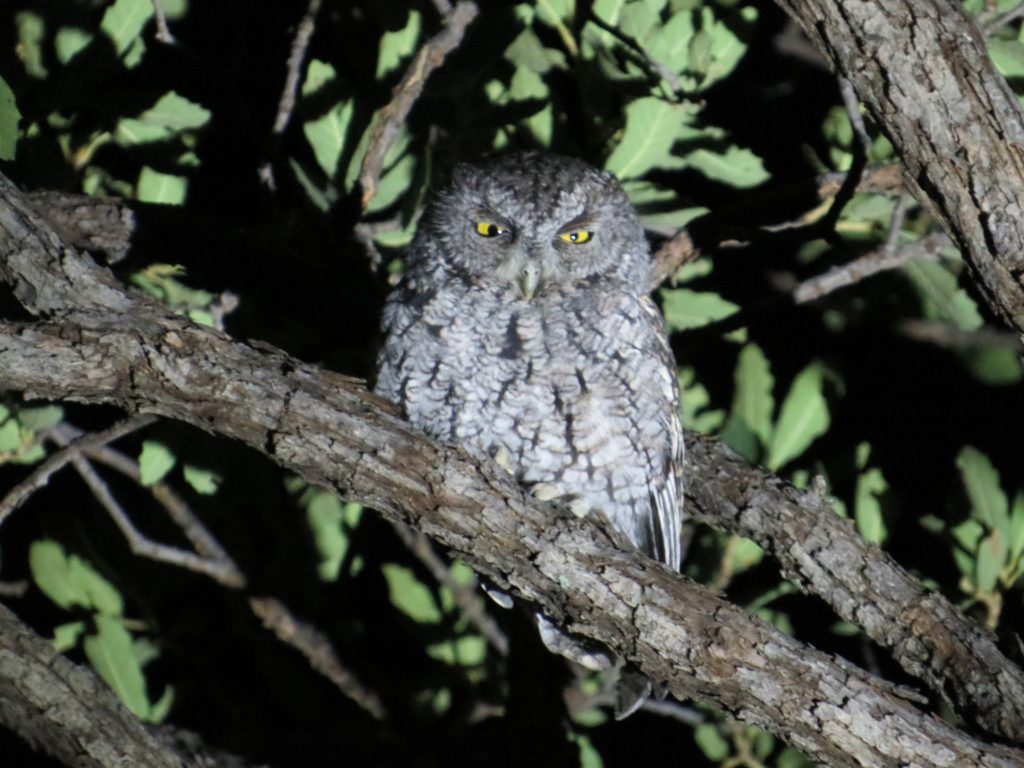
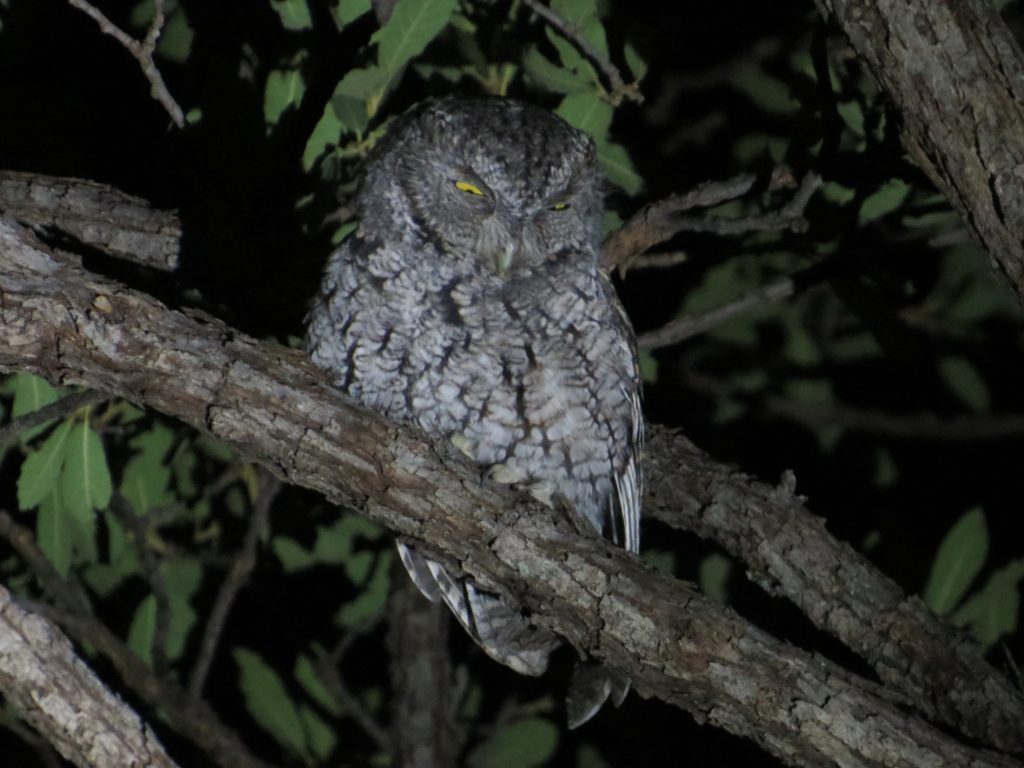
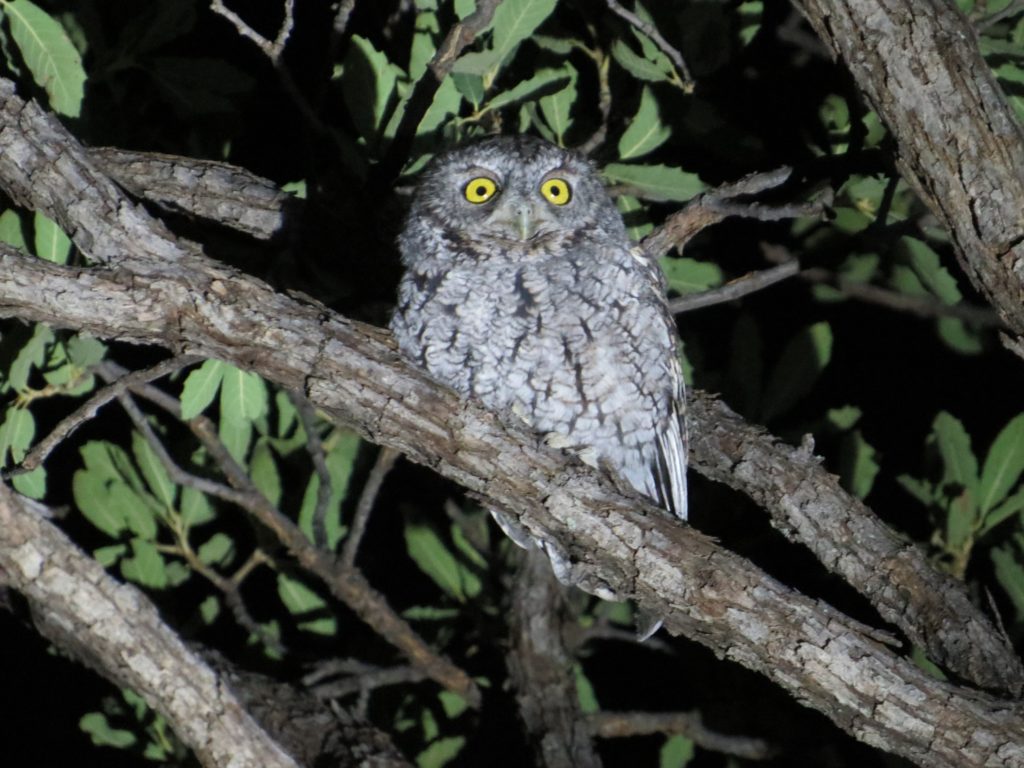 At this point Dad went back to the car on account of a knee that was giving him fits. Gordon, Tommy, and I decided we would try for more Whiskered Screeches. Why not?
At this point Dad went back to the car on account of a knee that was giving him fits. Gordon, Tommy, and I decided we would try for more Whiskered Screeches. Why not?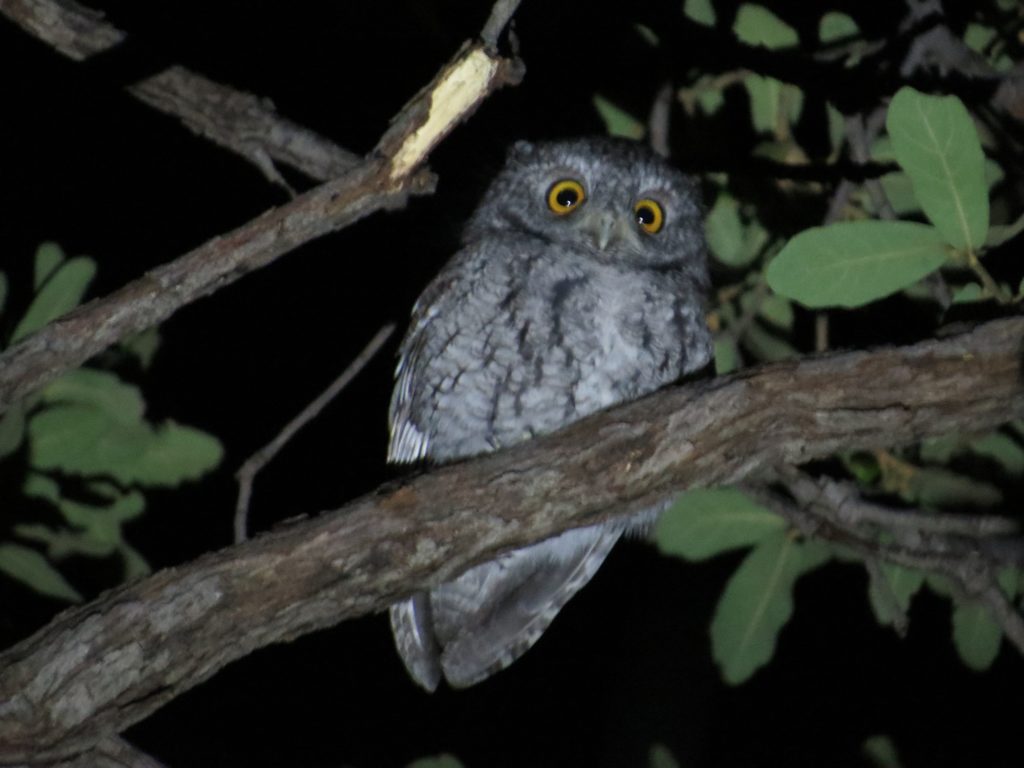 Hearing this vocalization was an exciting learning experience for Tommy. It wasn’t as cool as the Morse-code calling we heard the adult make earlier, but it was still pretty neat regardless. Have a listen for yourself:
Hearing this vocalization was an exciting learning experience for Tommy. It wasn’t as cool as the Morse-code calling we heard the adult make earlier, but it was still pretty neat regardless. Have a listen for yourself: Two Owl lifers remain for me in Arizona. The question is not whether Tommy can help find them, but rather, will it happen in 2017? Time will tell.
Two Owl lifers remain for me in Arizona. The question is not whether Tommy can help find them, but rather, will it happen in 2017? Time will tell.